
IN-DEPTH GUIDE TO WHO’S WINNING ARGUABLY THE MOST IMPORTANT CHANNEL IN QUICK SERVICE.
83%

ghirardelli.com/professional
By Kitchen Brains
Data-driven decisions made easier


IN-DEPTH GUIDE TO WHO’S WINNING ARGUABLY THE MOST IMPORTANT CHANNEL IN QUICK SERVICE.
83%

ghirardelli.com/professional
By Kitchen Brains
Data-driven decisions made easier
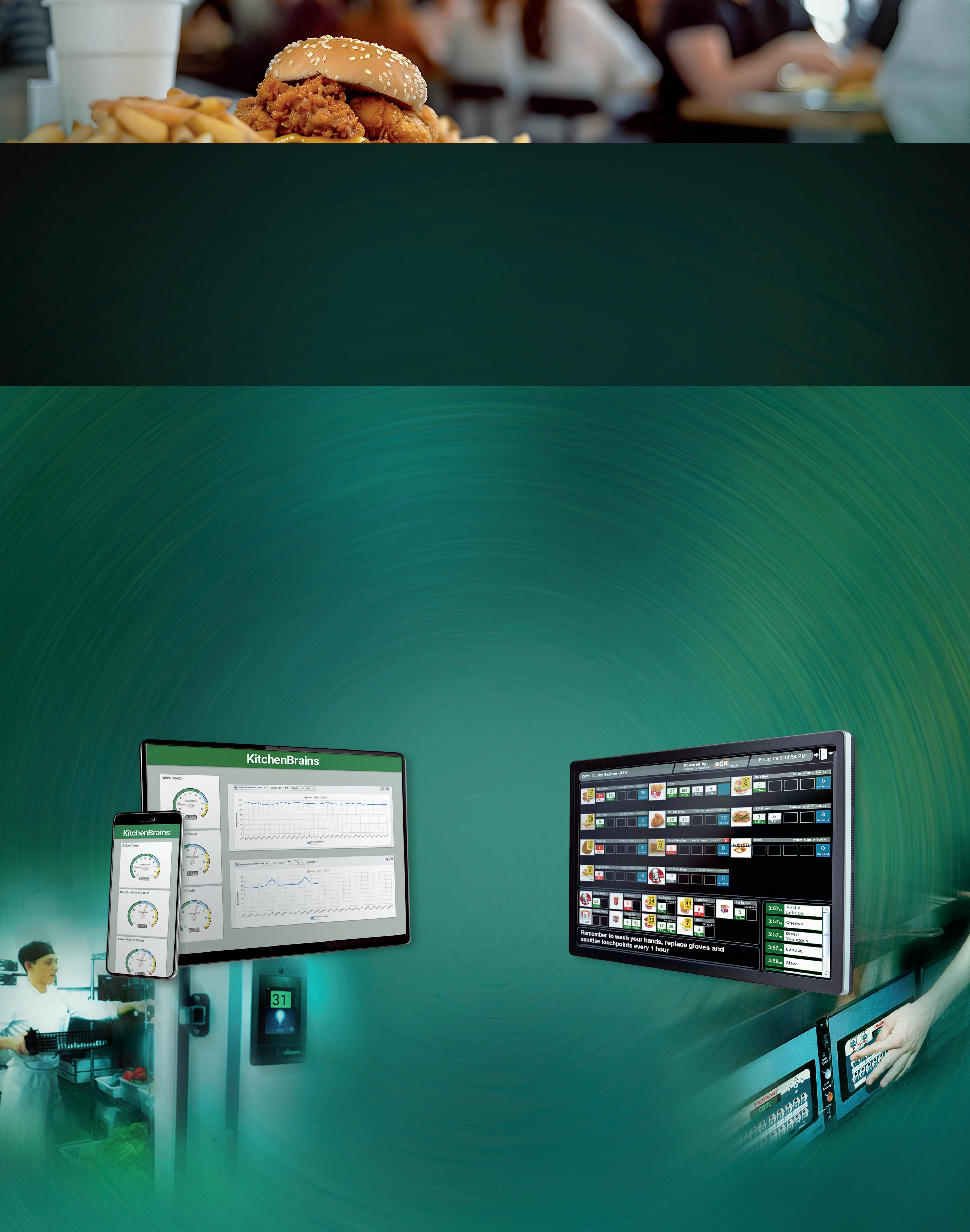

KorrectTemp
Temperature Monitoring System
Above store data & reporting
Remote monitoring
Real-time alerts
• Food loss prevention
• Eliminate manual logging
• Ensure customer safety

Kitchen Management System
IoT appliance integration
Automated dynamic projections
Real-time MoH™ insights
• Deliver quality & customer experience
• Ensure product availability & freshness
• Reduce Waste
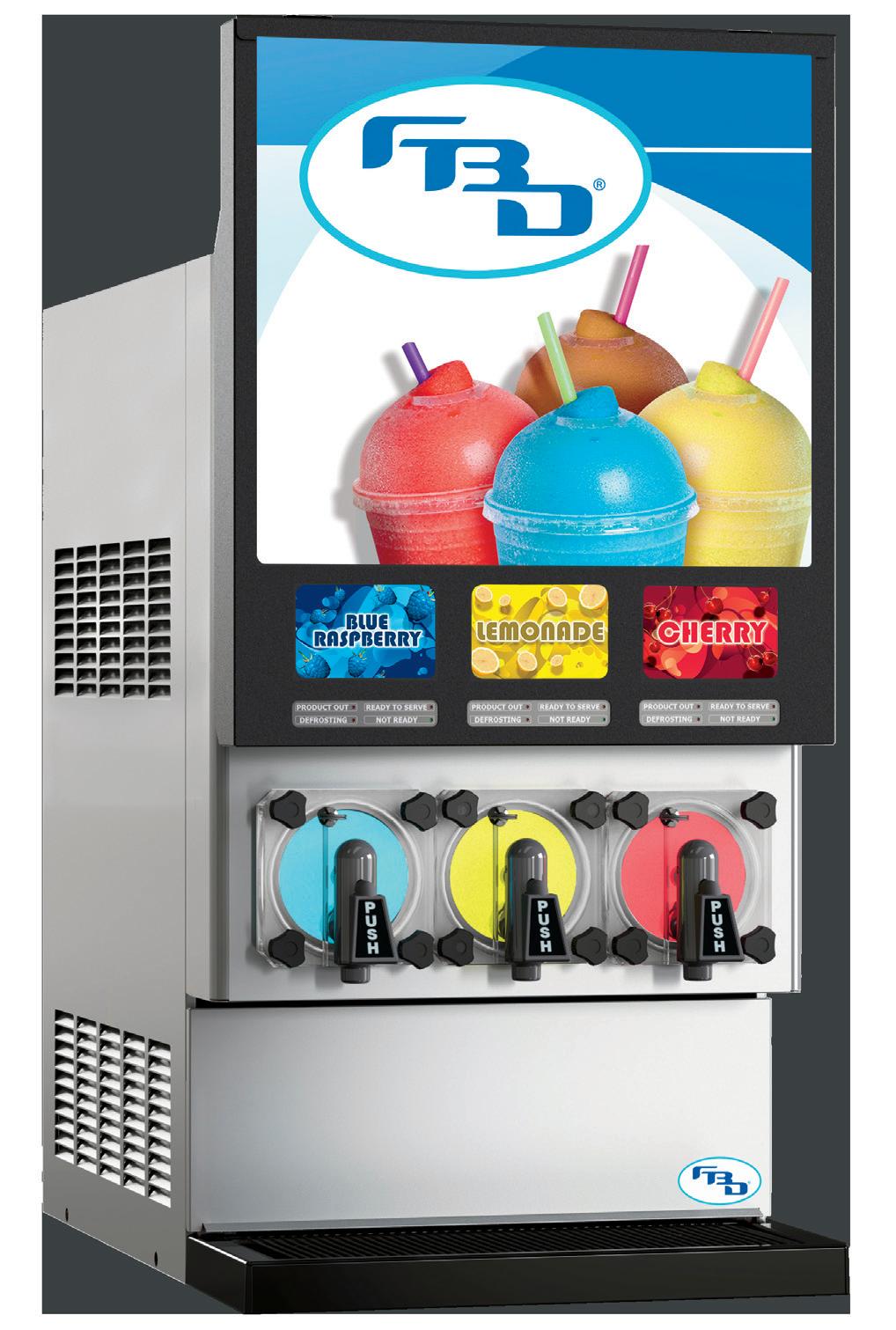

Frozen beverages are highly profitable up to 80% gross profit, given that they are mostly made up of CO2 & water.
The use of a closed sealed system, in conjunction with bag in the box technology (BIB), means no product mixing or daily disassembly to clean.
Our machines are designed to help your customers create unique and personal experiences, while ensuring excellent product quality and consistency.
FBD dispensers are engineered to make a frozen drink quickly and with minimal labor easy to execute and minimal labor- no product mixing or blending.
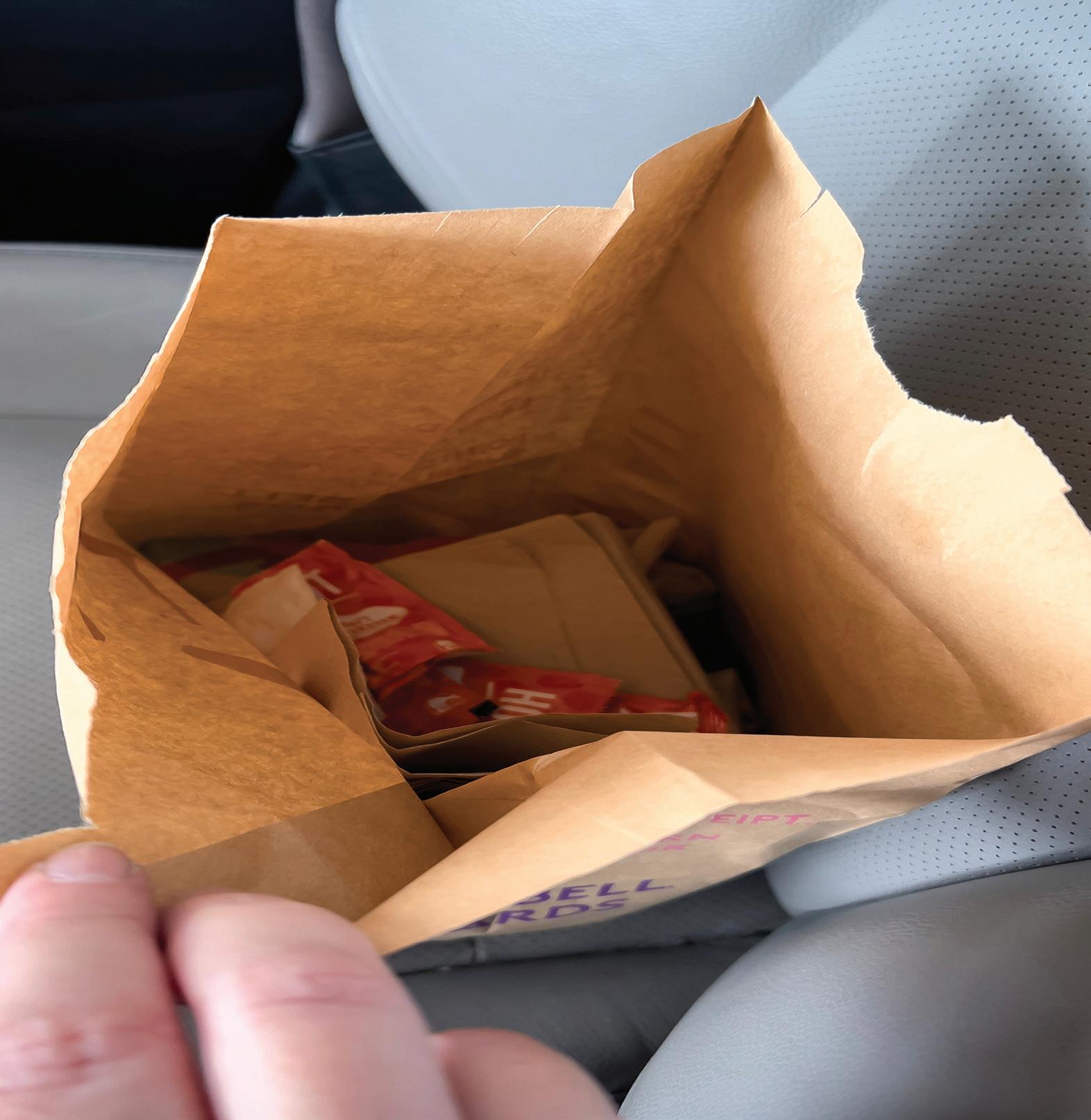
24
WOMEN IN LEADERSHIP Building Franchising Legacies
Two Orange Leaf operators give insight on how they've carved success in the business. BY SATYNE DONER
74
FRANCHISE FORWARD
The Blow of Political Headwinds
This year's presidential election is undoubtedly impacting restaurants. BY SAM DANLEY
INSIGHT
15
FRESH IDEAS
The Human Touch Behind Speedier Drive-Thrus
More concepts are emphasizing face-to-face interactions in the parking lot. BY SAM DANLEY
22
ONES TO WATCH Moby Dick House of Kabob
A Persian concept attracts a cult following in the DMV market. BY TALLULAH HAWLEY
78 OPERATIONS
Velvet Taco Taps into AI Menu
The chain is using technology to develop new flavors. BY TALLULAH HAWLEY
96
Winning
START TO FINISH Neil Hershman
The 16 Handles CEO describes what it takes to be a premium brand in the frozen dessert category.
Chick-fil-A’s latest prototype is wowing the restaurant industry.
PHOTOGRAPHY: CHICK-FIL-A

EDITORIAL
EDITORIAL DIRECTOR
Danny Klein dklein@wtwhmedia.com
QSR EDITOR
Ben Coley bcoley@wtwhmedia.com
FSR EDITOR


12 Fresh Development Captures the Heart of DFW
20
Fresh Development Captures the Heart of DFW
These restaurants are booming near one of the world’s largest international airports.
SPONSORED BY CITY OF GRAPEVINE
These restaurants are booming near one of the world’s largest international airports. SPONSORED
Investing in High-Definition Audio and Order Accuracy Pays Off How franchisees could gain up to $23 thousand per store every year.
SPONSORED BY HME HOSPITALITY AND SPECIALTY
Why Consumers Go Where the Deals Are More Than Ever New
SPONSORED
Callie Evergreen cevergreen@wtwhmedia.com
ASSOCIATE EDITOR
Sam Danley sdanley@wtwhmedia.com
VICE PRESIDENT EDITORIALFOOD, RETAIL, & HOSPITALITY Greg Sanders gsanders@wtwhmedia.com
CONTENT STUDIO
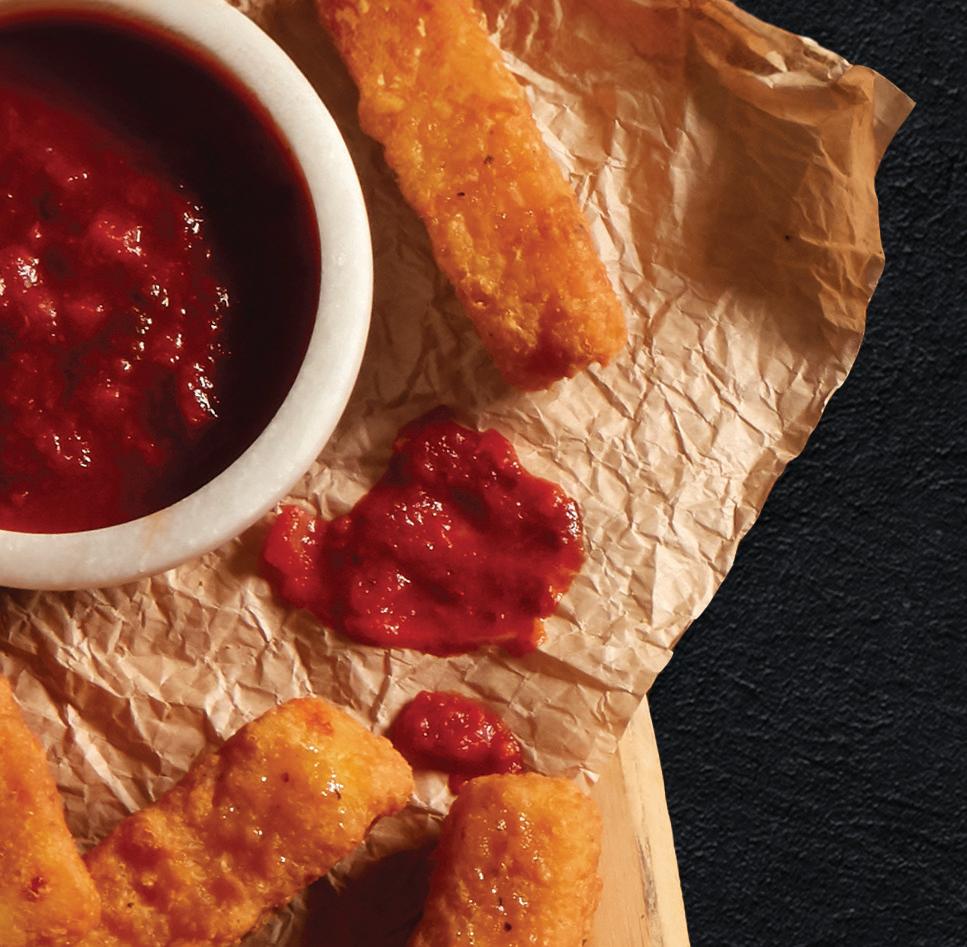
19 New Irish Product Set to Enter U.S. Market
New Irish Product Set to Enter U.S. Market
How sustainable practices and rich traditions are driving demand.
How sustainable practices and rich traditions are driving demand.
SPONSORED BY BORD BIA
SPONSORED BY BORD BIA
25 Prevent Costly Food Safety Violations with Superior Cleaning Methods
Digital Reader Boards: The
Prevent Costly Food Safety Violations with Superior Cleaning Methods
Marketing
How
A highly effective solution for maintaining restaurant hygiene. SPONSORED BY SANI PROFESSIONAL
A highly effective solution for maintaining restaurant hygiene. SPONSORED BY
Digital Reader Boards: The New Frontier in QuickService Restaurant Marketing How dynamic LED signage is boosting sales, strengthening
VICE PRESIDENT, CONTENT STUDIO Peggy Carouthers pcarouthers@wtwhmedia.com
WRITER, CONTENT STUDIO Ya’el McLoud ymcloud@wtwhmedia.com
WRITER, CONTENT STUDIO Olivia Schuster oschuster@wtwhmedia.com
ART & PRODUCTION
SENIOR ART DIRECTOR Tory Bartelt tbartelt@wtwhmedia.com
FSR ART DIRECTOR Erica Naftolowitz enaftolowitz@wtwhmedia.com
SALES & BUSINESS DEVELOPMENT

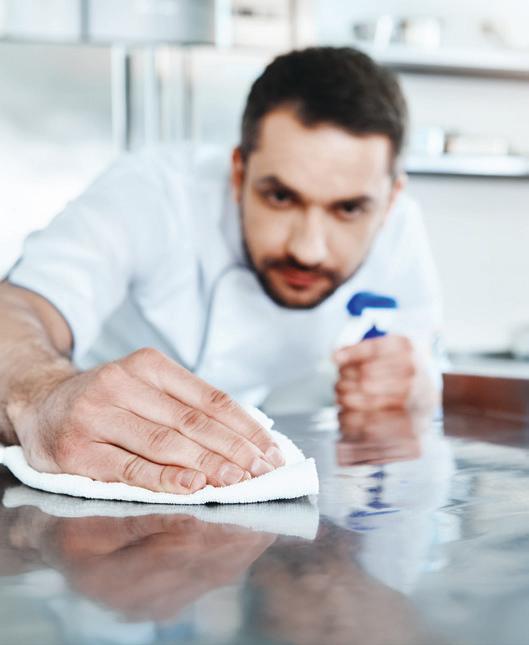

VICE PRESIDENT SALESFOOD, RETAIL, & HOSPITALITY Lindsay Buck lbuck@wtwhmedia.com
VICE PRESIDENT, BUSINESS DEVELOPMENT Eugene Drezner edrezner@wtwhmedia.com 919-945-0705
NATIONAL SALES DIRECTOR Edward Richards erichards@wtwhmedia.com 216-956-6636
NATIONAL SALES DIRECTOR Amber Dobsovic adobsovic@wtwhmedia.com 757-637-8673
NATIONAL SALES MANAGER Mike Weinreich mweinreich@wtwhmedia.com 561-398-2686
CUSTOMER SERVICE REPRESENTATIVE Tracy Doubts tdoubts@wtwhmedia.com 919-945-0704
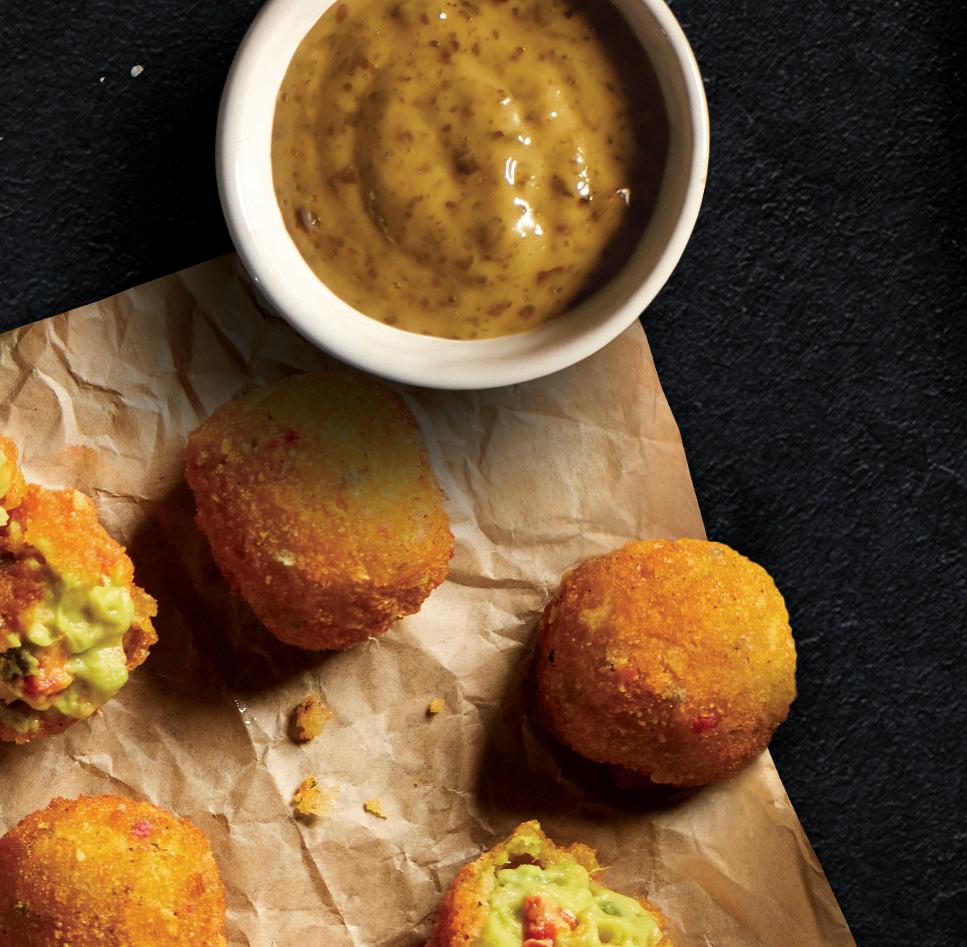
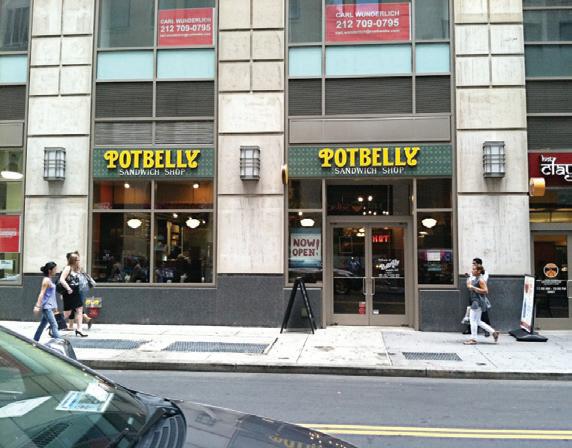



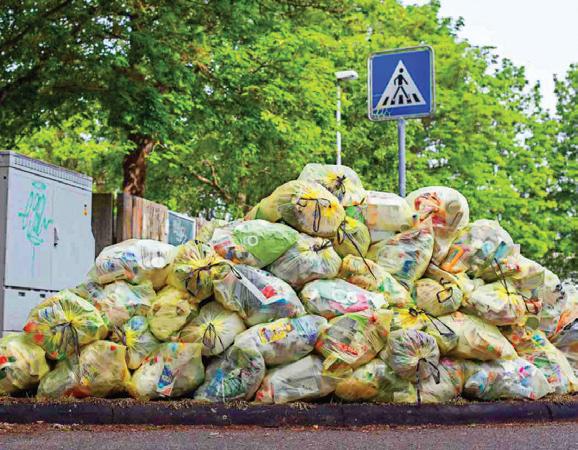
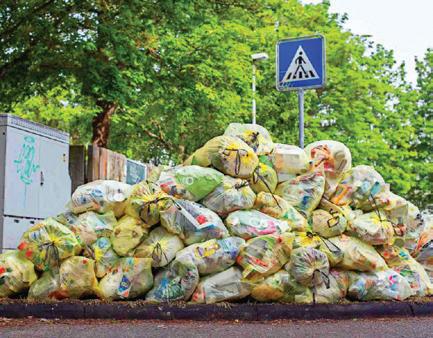
CUSTOMER SERVICE REPRESENTATIVE Brandy Pinion bpinion@wtwhmedia.com 662-234-5481, EXT 127 FOUNDER Webb C. Howell
ADMINISTRATION
919-945-0704 / www.qsrmagazine.com/subscribe
QSR is provided without charge upon request to individuals residing in the U.S. who meet subscription criteria as set forth by the publisher.
REPRINTS
The YGS Group 800-290-5460 FAX : 717-825-2150 qsrmagazine@theygsgroup.com WTWH MEDIA LLC RETAIL, HOSPITALITY, AND FOOD GROUP









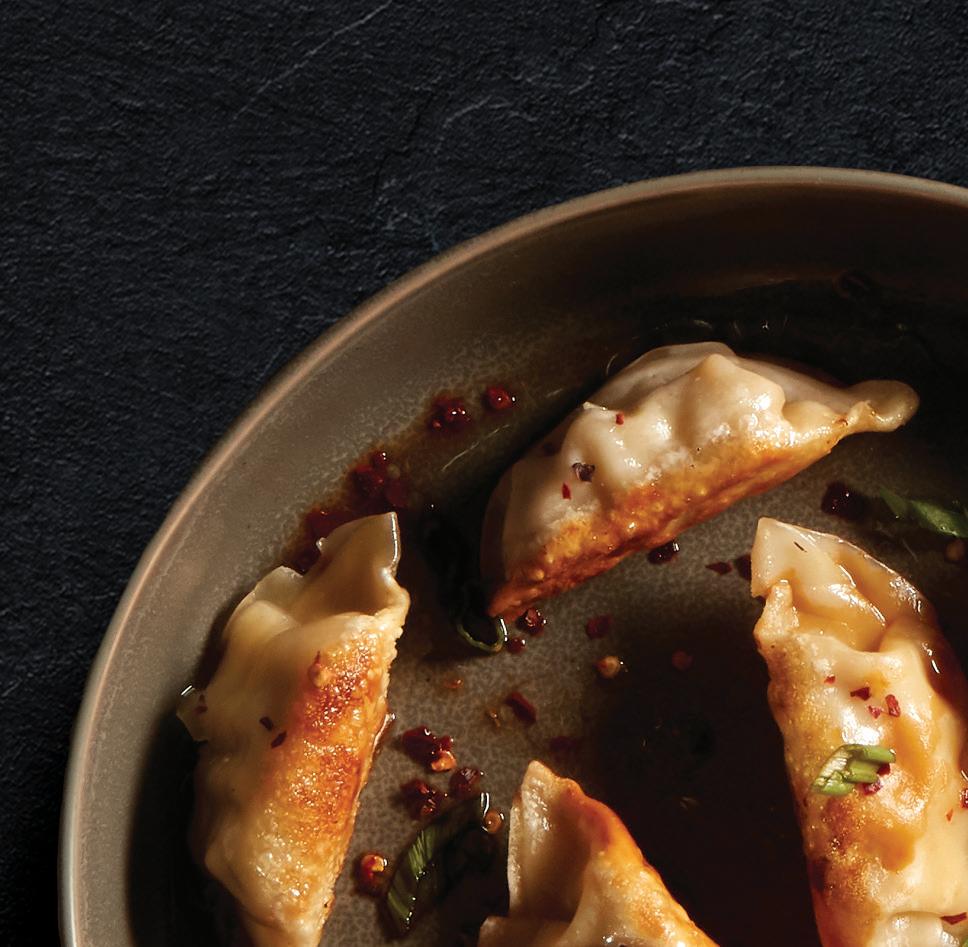
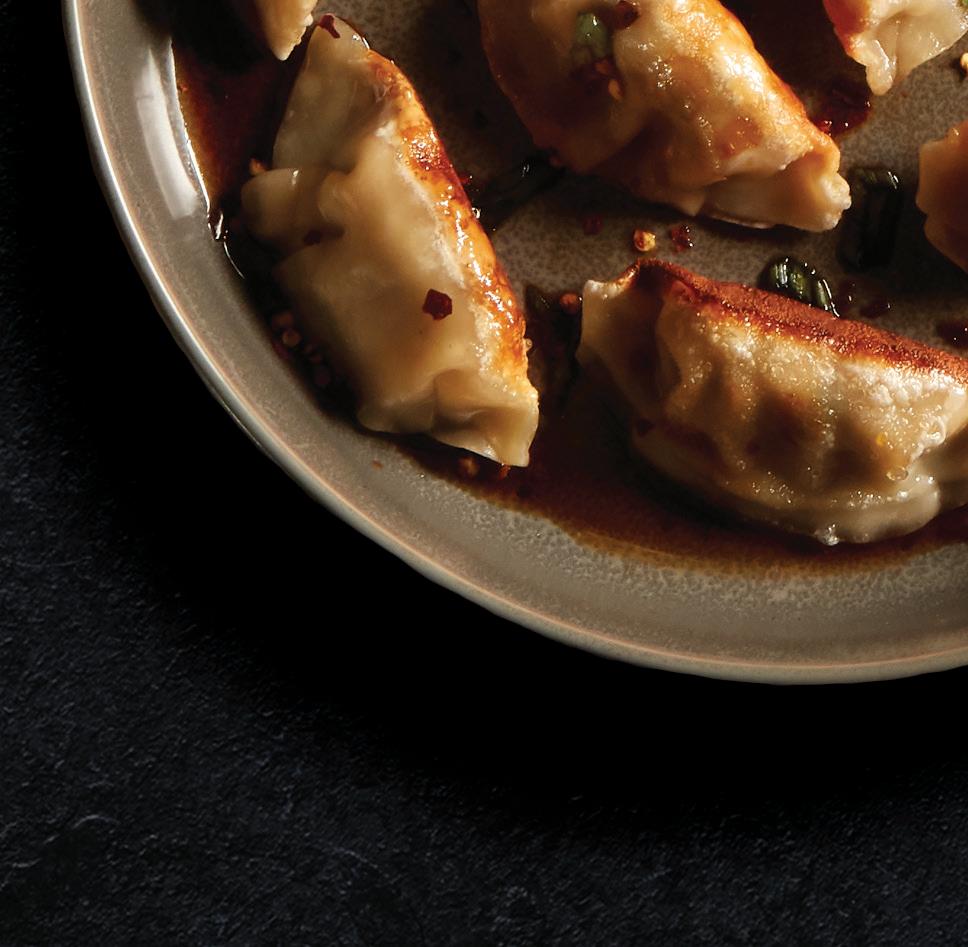


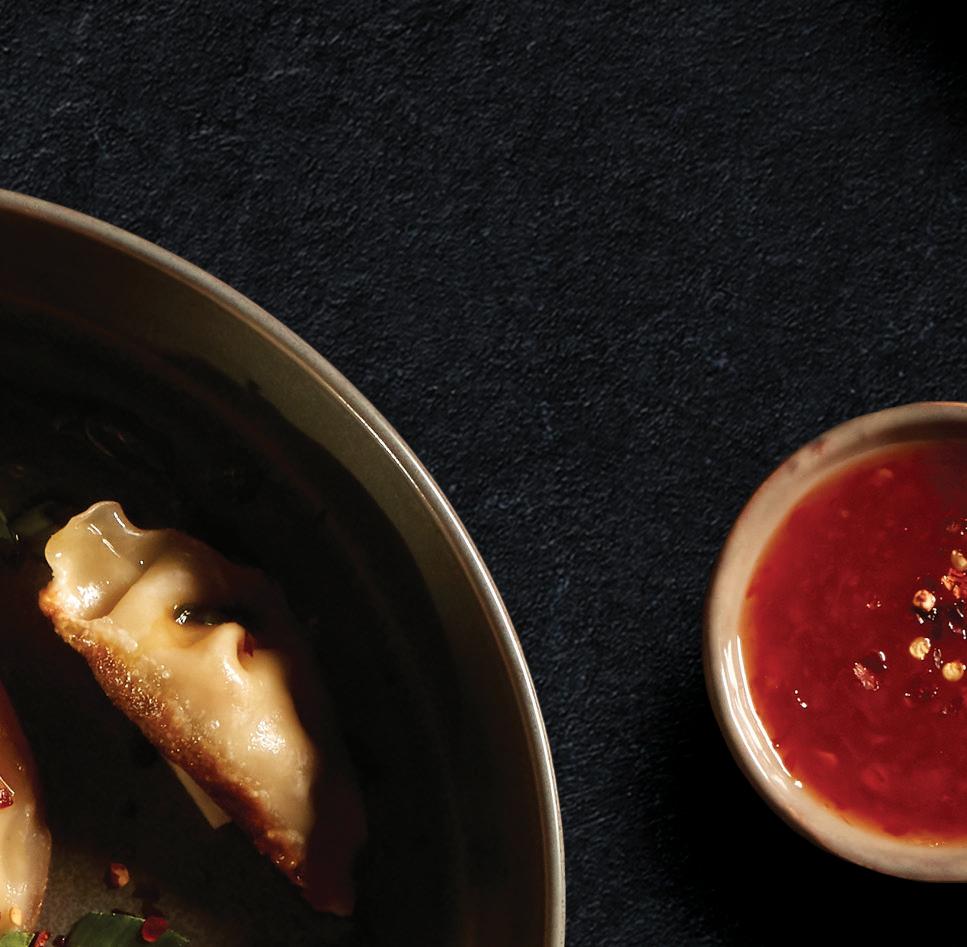
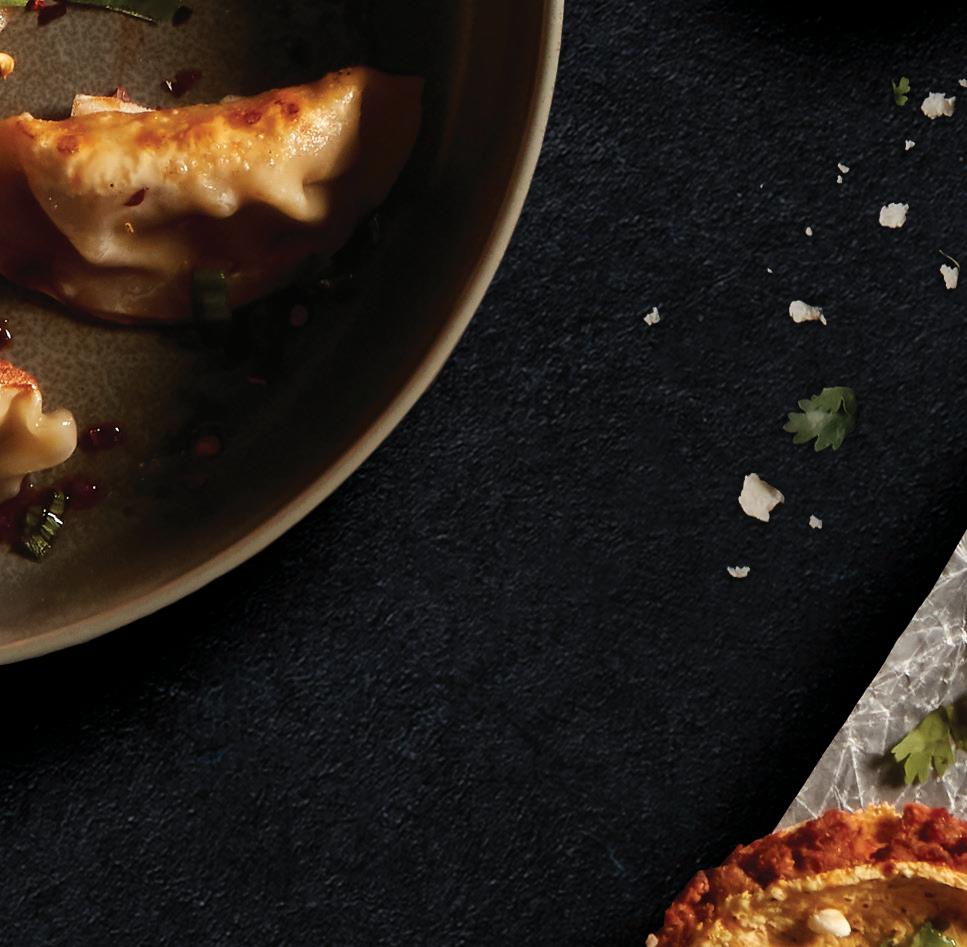







The channel is evolving quickly to meet guest needs.
For QSR magazine, October is all about the drive-thru.
At center stage is the QSR© DriveThru Report, a comprehensive analysis of performance at leading quick-service restaurants, conducted in partnership with Intouch Insight.

This year’s edition shows that postpandemic shifts stress the importance of friendly services and technological innovations—such as digital menu boards and AI-assisted ordering—to enhance the drive-thru experience. According to the data, order accuracy improves significantly with better employee/customer interactions and clear communication. Fast-food brands are increasingly adopting voice AI technology in drive-thrus to boost customer operations. Chains such as Bojangles, Taco Bell, Wendy’s, and White Castle are at the forefront of this shift. They’ve moved beyond pilot programs to wider deployment.
Meanwhile, digital menu boards are revolutionizing drive-thru operations in the quick-service restaurant industry by offering real-time updates, enhanced visual appeal, and improved efficiency. These boards enable immediate menu adjustments, reduce errors, and improve customer satisfaction by displaying clear, vibrant images of menu items.
Overall, the report showcases the need for a seamless, personalized experience that integrates speed with quality service. One of our pieces touches specifically on brands that forego the advanced technology at the drive-thru in exchange for literal face-to-face interactions. In all kinds of weather, some chains have employees take orders outside in the drive-thru lane before custom-
ers arrive at the window. This method, combined with strong training, has proven successful in maintaining quick service for a lot of concepts. Some have found that it creates a smoother, more personalized drive-thru experience.
Drive-thru is such a valuable channel that in many cases, chains are opting to get rid of the dining room in the construction and design process. This trend accelerated during the COVID-19 pandemic, when many restaurants operated almost exclusively through drive-thrus and pickup options. Brands like Jack in the Box, Del Taco, Portillo’s, and Captain D’s are exploring smaller, more efficient drive-thru-only units that reduce costs and require less space, making them suitable for urban and high-density areas. While these units offer a lot of benefits, there is a risk of them becoming purely transactional, lacking brand appeal. Companies are balancing these challenges by boosting customer experience through connection and streamlined technology.
As we look ahead, the quick-service drive-thru is poised to become more than just a channel for convenience—it’s evolving into a dynamic interface where technology and customer experience converge. The inclusion of AI, digital menu boards, and real-time data offers unprecedented opportunities to tailor each interaction, transforming drivethrus into hubs of closer service. Yet, as we embrace these measures, the industry must ensure that innovation doesn’t overshadow the essential human element that defines hospitality.
Ben Coley, Editor

The small base station footprint allows you to save precious kitchen space without sacrificing capabilities. With APEX Plus, your base station is also your timer, saving hundreds of dollars on installation costs!





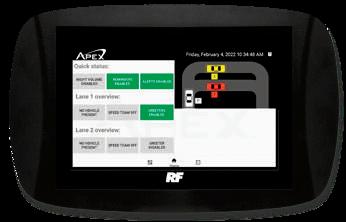
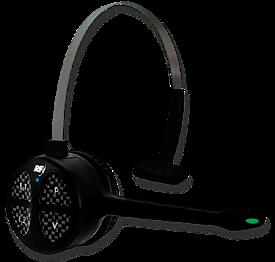
An optional secondary display keeps you updated on your drivethru metrics, enabling you to make real-time improvements easily and intelligently.
The lightweight APEX headset provides durability and comfort for your staff, allowing them to do what they do best: take care of your valued customers.



Increase revenue and lower cost
• No Busy Signals
• Call Recording
• Call Queuing / Auto Answering
• Multiple (random) start of call upsell messages
• On hold music/message loops
• Detailed reports—hold times, lost calls etc
• Callerid delivered to POS system
• Auto attendants— ”If you have arrived for curbside pickup press one ”


Protect against outages
• When your Internet fails our cellular backup router keeps your phones, credit card processing and web orders all working.
• The backup kicks in automatically in seconds. So quickly you will not even drop calls in progress when your primary Internet goes down!
• The same router can be used to create chain wide virtual private network to connect your locations.
• SD WAN LTE/LTE A (4G/5G) modems.


“Press one to
Manage bulk text message marketing from our system to drive increased revenue. As low as $0.01 per message.

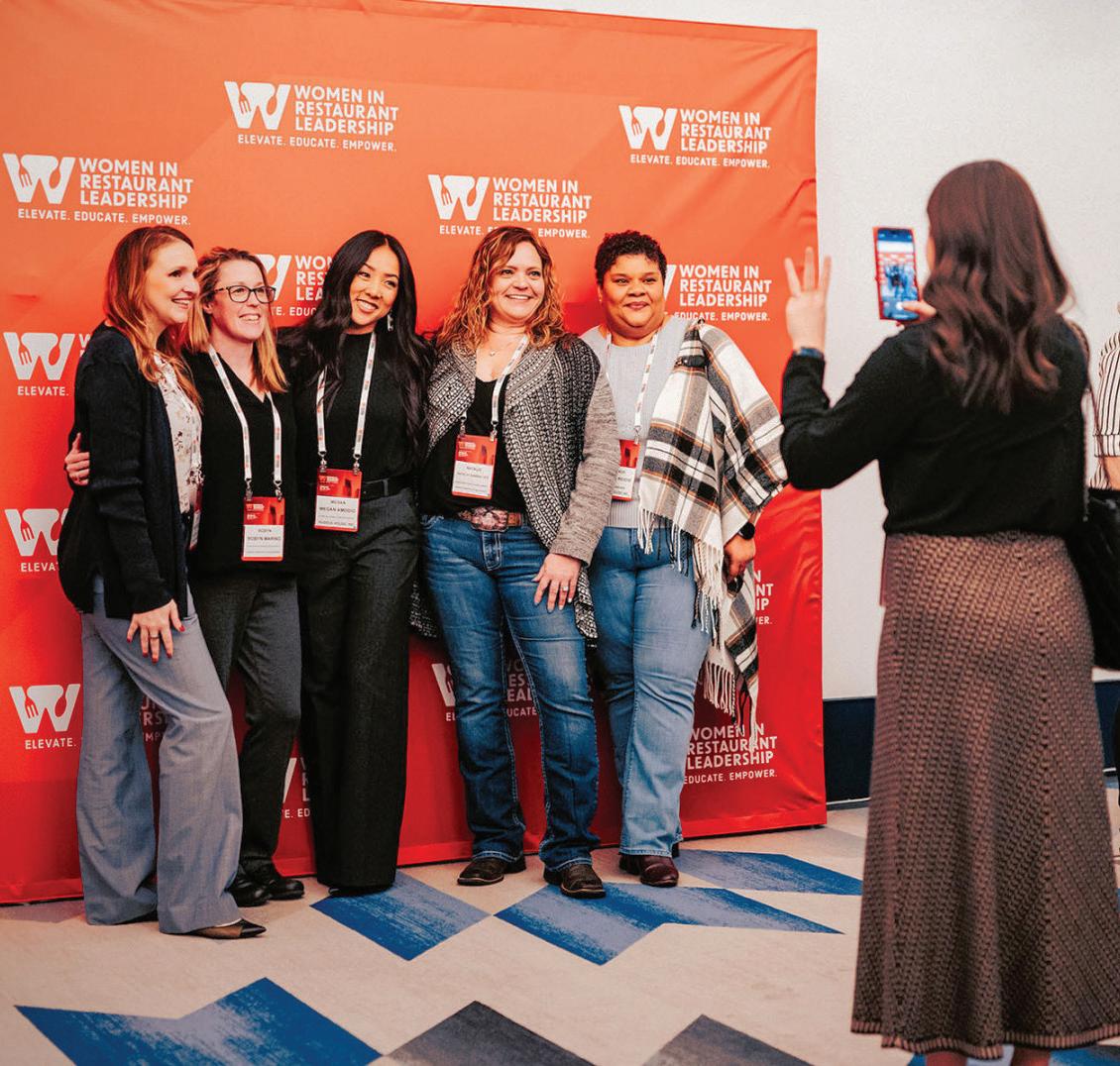
Come hear the industry’s top female leaders on how to make it in the restaurant industry.

QSR AND FSR MAGAZINES ARE PROUD to once again host the Women in Restaurant Leadership Summit for a second year. The event will take place February 19 and 20 at Grand Hyatt Nashville.
The Women in Restaurant Leadership Summit (WiRL) gathers female leaders from across the hospitality industry. It focuses on mentorship, career advancement, networking, and education, offering workshops and discussions on leadership, marketing, finance, and personal development.
Join us as we work together to create positive change in the restaurant industry. The event is ideal for restaurant brands of all sizes, from any corner of the sector, quick and full service, chains to independents. It will be an accessible and open forum, whether you’re high up in the C-level or just starting out your restaurant career.
Scan the QR Code to find out more information and register.
In August, Square released its Quarterly Restaurant Report , which uses data to explore trends and shifts in consumer spending, change in restaurant employees wages, and market growth.

• According to Square, cities across the country are seeing a resurgence in nightlife, with strong growth in late-night restaurant and bar transactions. The company’s analysis shows New York and Miami lead in this trend, but Boston has experienced the most significant increase. The city’s late-night transactions rose from 12 percent in 2019 to 31 percent in 2024. Richmond has also seen growth, with 35 percent of transactions occurring late at night in 2024, up from 23 percent pre-COVID. Similarly, Philadelphia’s latenight activity has rebounded, reaching 31 percent from 23 percent in 2019.

• Square’s data shows restaurant worker hourly pay is growing annually at a higher rate than inflation.
Average hourly earnings were up 4.10 percent versus 2.92 percent inflation as of July compared to 2019.
• Post-COVID, Washington, D.C. has seen significant shifts due to factors like remote and hybrid work and revitalization efforts, leading to increased restaurant traffic in suburban neighborhoods outside of downtown. Areas such as Navy Yard, NoMa, Glover Park, and Tenleytown have experienced notable growth in dining activity, driven by new housing developments. Meanwhile, areas near the National Mall and tourist spots have remained stable, supporting downtown businesses, while regions east of The Potomac River have seen declines in activity.


• A restaurant service fee is an additional charge, either a percentage of the total bill or a fixed amount, added to a customer’s transaction. It is different from a tip or surcharge. Restaurants often implement service fees to help cover operational costs such as wages, maintenance, and other overhead expenses.
• According to Square, these fees are uncommon, but growing. In Q2, about 3.7 percent of transactions included a service fee. That’s more than doubled since the start of 2022.
• Leigh Biddlecome, head of public relations at Cafe Venetia, said the espresso bar has embraced a European approach from the beginning. To maintain this model and support its team’s development, it applies a service fee. The company makes sure this fee is clearly indicated on menus to prevent any customer misunderstandings.
• Ara Kharazian, Square’s research lead and developer of the Square Payroll Index, said that while the current wage growth is positive for restaurant workers, there are signs of a weakening labor market. Wage increases have slowed significantly from their peak in 2022, and there has been a slight rise in unemployment and layoffs, even though overall unemployment remains historically low.
• Ming-Tai Huh, head of restaurants at Square, noted that restaurant profit margins are tighter than ever, pushing businesses to find ways to cover rising costs. Service fees are one method being used to manage unpredictable operational expenses, maintenance, and administrative costs. He emphasized the importance of transparency with these fees, so customers understand where their money is going and what it covers.

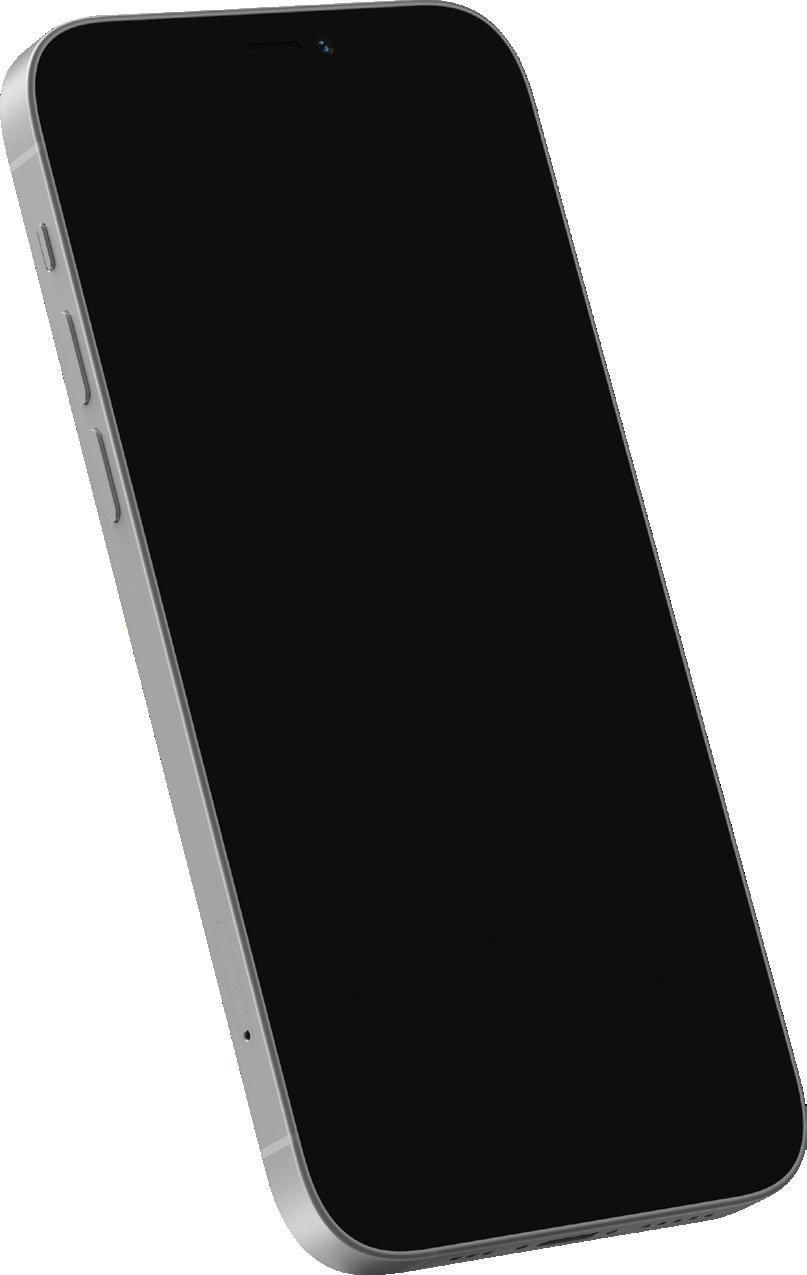

These restaurants are booming near one of the world’s largest international airports.
Location, location, location! Every operator knows how vital it is to open their business in an area that is open to new concepts, has a welcoming community and has a market primed for growth. Cities that boast strong tourism economies, supportive community events, and high incomes are places where operators and owners can look to expand operations and remain confident in their investments.
Nestled between Dallas and Fort Worth, Grapevine, Texas o ers more than just a prime location. Its vibrant community, thriving local economy, and event-driven culture make it an ideal place for restaurant chains to expand. Its proximity to Dallas-Fort Worth (dfw) International Airport means it attracts both tourists and business travelers and its relatively high average household income of $107,000 thousand means residents have the resources to support local restaurants.
“Grapevine has always been a strong market for restaurants,” says Brett Anz, part owner of Rock and Brews and partner in TradeCorp, a real estate development firm. “My first real estate deals there were for Outback Steakhouse and Carrabba’s, and they performed well for many years. There are many top-performing restaurants in Grapevine, due to the airport, hotel support, and community events, like the wine festivals and holiday parades.”
Anz’s extensive experience in real estate and franchise development led him to a key opportunity in Grapevine, transitioning an older


Ford dealership into a collection of restaurant spaces for thriving franchises. “We bought the property unknowingly right before COVID, so the restaurant industry was on hold for a while,” Anz says. “We had plans in place and were in talks with tenants, but everything was
paused for about six months. Once things became clearer regarding COVID, we resumed, and Velvet Taco came back on board early.”
Grapevine’s close proximity to DFW International Airport—one of the busiest airports in the world—is a major advantage to restaurants. With millions of travelers passing through annually, restaurants in this area benefit from a steady influx of visitors. Additionally, the city’s robust hotel industry, driven by tourism and business travel, supports the restaurant sector by providing a consistent customer base.
Grapevine is defined by a supportive community and local government invested in bringing new businesses to the area. The city’s calendar is full of events, from the Southwest’s largest wine festival to 40 days of holiday celebrations, making Grapevine the Christmas Capital of Texas.


According to Anz, the Grapevine city government was fully on board with his proposal for the dilapidated Ford dealership. “Grapevine city’s business-minded and entrepreneurial approach stood out,” Anz says. “They recognized this site as an important entry point to their city and Main Street. It was an eyesore, and they knew they wanted something better there, especially restaurants. Once I brought that idea forward, they fully supported it.”
Currently, the development includes five restaurants: Velvet Taco, Son of a Butcher, Firebirds Wood Fired Grill, Rock and Brews, and Portillo’s, which will be opening towards the end of the year according to Anz. “The neighborhood has been very supportive and regularly patronizes the restaurants, which are all performing well,” Anz says. “The old fences and structures were dilapidated, so replacing them with a new, much higher wall made a positive di erence. Our general contractor worked well with the residents, keeping them informed throughout the process.”

A supportive community and government that wants to work with new restaurants is key to the success of new ventures. Fortunately, Grapevine is supportive of new businesses, with plenty of opportunities for restaurants to engage with the community and build loyal customer bases with the locals.
CEO, Jack Gibbons, was familiar with the area from his years with Papadeaux and saw that Grapevine would be a great market for Son of a Butcher,” Wilson recounts. ”The community response has shown that it was the right call to open here—people have embraced what we’re o ering.”
Grapevine, Texas, exemplifies what it means to find the right location for restaurant expansion. With its robust tourism, supportive local government, and a community that values high-quality dining experiences, Grapevine o ers an environment where new ventures can thrive. “Liquor sales reports in Texas show that Grapevine consistently ranks high, which indicates strong overall volume,” Anz says. “Many restaurant chains see their Grapevine locations as top performers. People
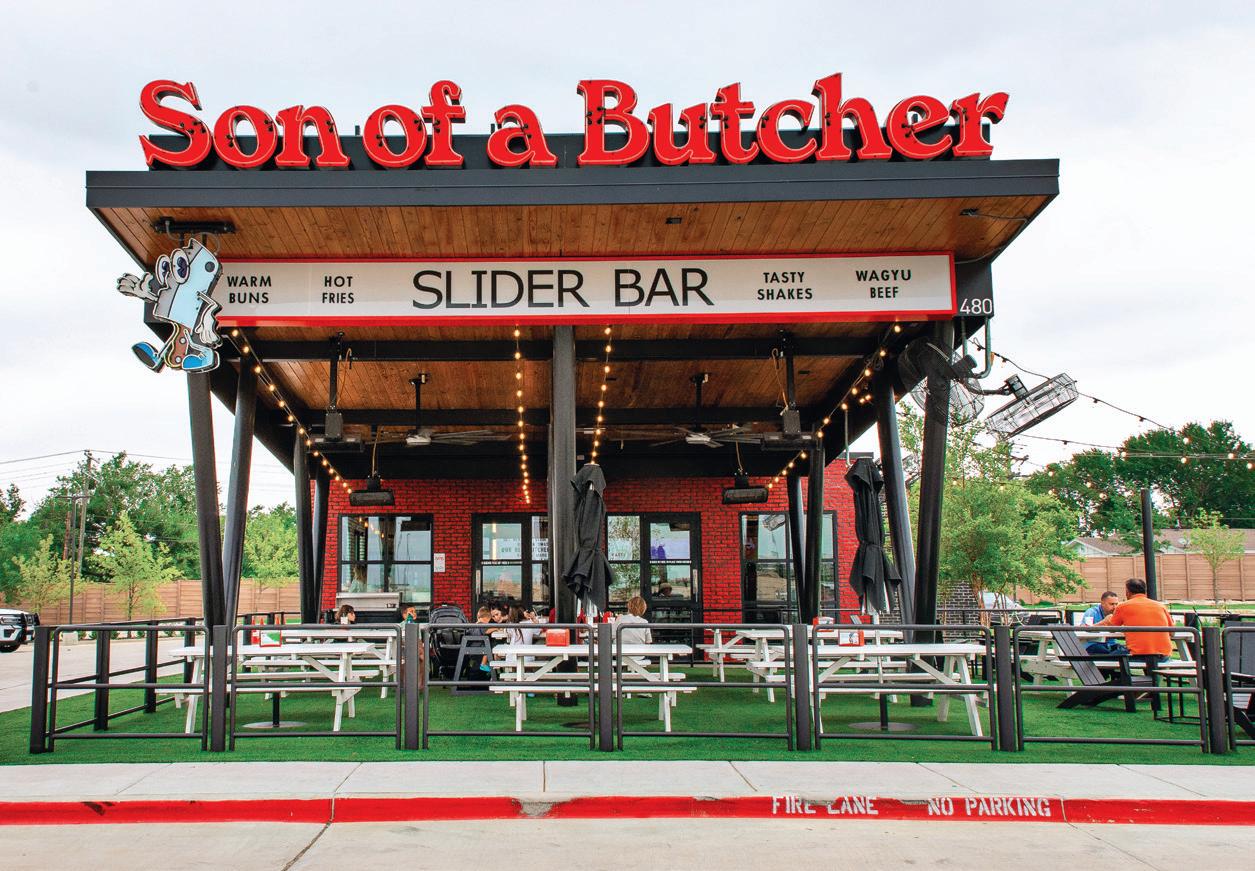
“Grapevine is a tight-knit community, and they have high standards for the businesses they bring in,” says Rachel Wilson, brand manager for FB Society, which manages Son of Butcher along with several other restaurant brands. “We’ve participated in several community events, like GrapeFest and car shows. We love finding unique local events and getting involved, whether we’re bringing Son of a Butcher to them or they’re coming to us.”
Son of Butcher was one of the first concepts to open up shop in the new development and is thriving due to community support and its unique approach to community building. From catering backyard barbeques and birthday parties to sit-down dining options, Son of a Butcher’s Grapevine location is thriving. “Our
have done well here for a long time, and if you do a good job for the community, they’ll continue to come out and support you.”
Operators looking to grow their brands will find not just a place to set up shop, but a community eager to welcome them. As Grapevine continues to grow and attract new businesses, it rea rms the age-old wisdom that the right location can be the cornerstone of success in the restaurant industry.
“I think there’s still room for more restaurant development in Grapevine,” Anz concludes. “Ideally, the market will continue to bring in restaurants that are either underrepresented or not yet represented here. There are definitely opportunities for growth.”
-Ya’el McLoud


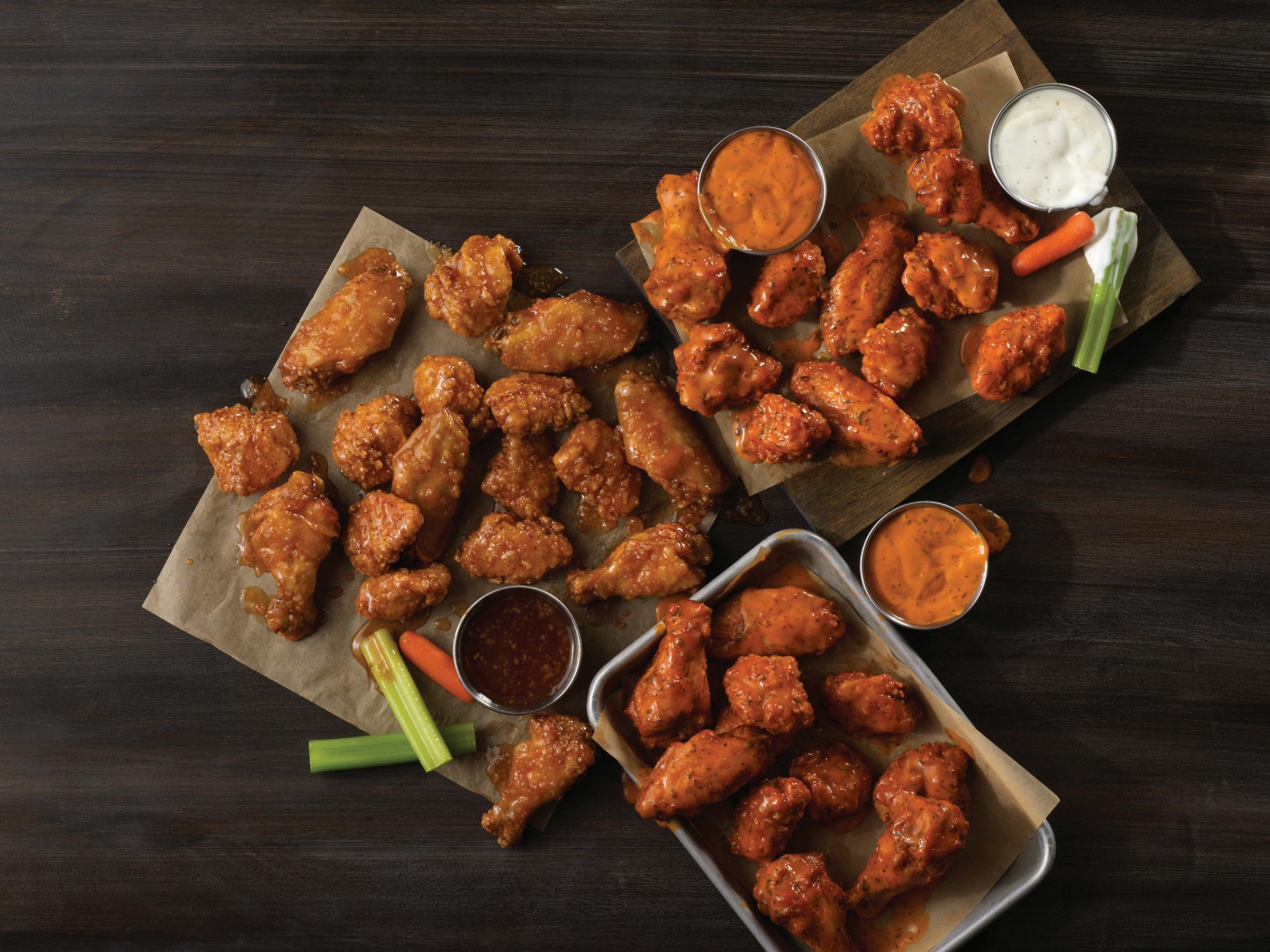



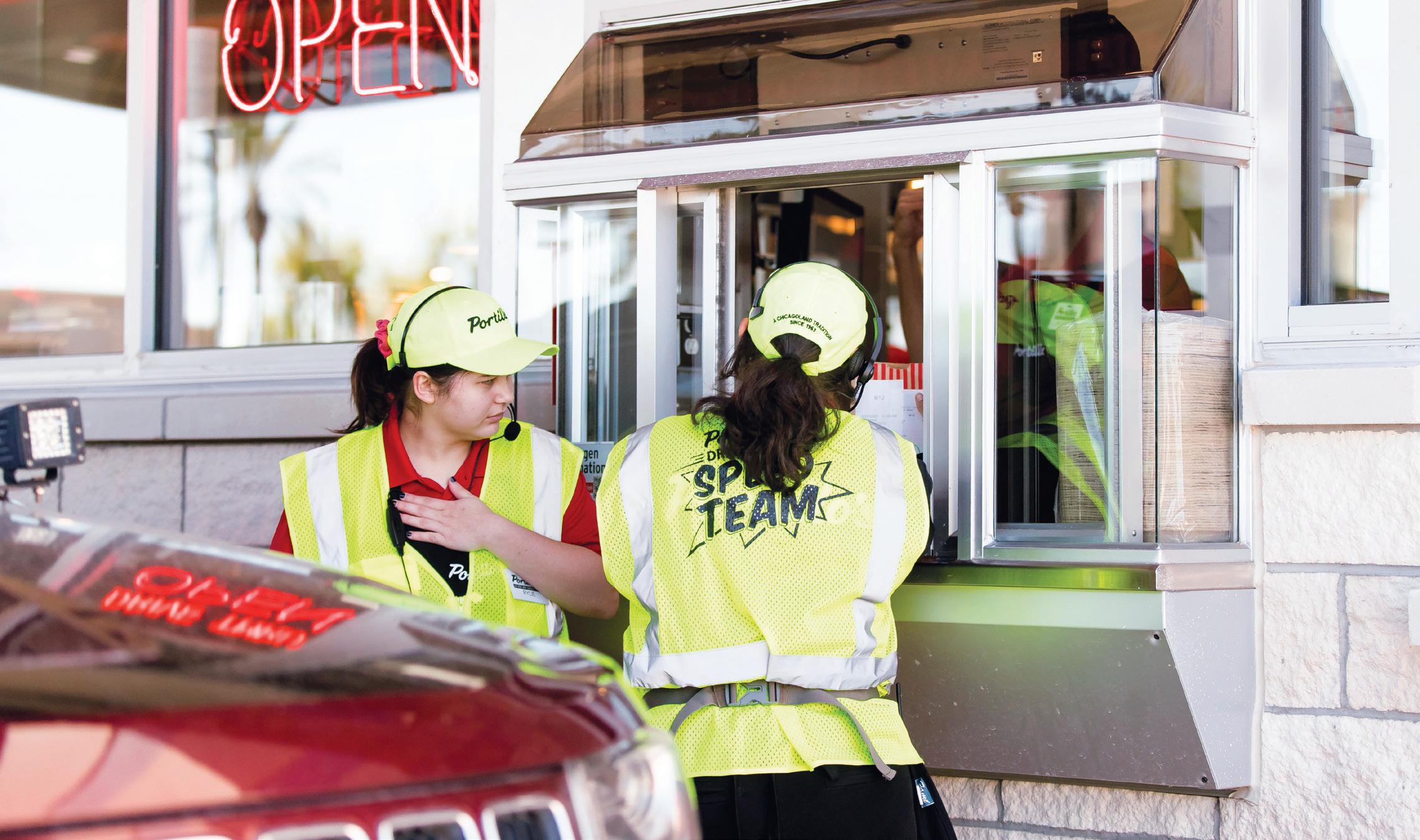
Top-notch training makes all the difference for outside order takers.
BY SAM DANLEY
While some brands are swapping out humans for computers and automating the drive-thru ordering process, others are ensuring guests still pull up and interact with a person—face-to-face and not through a speaker box.
Sending employees to take orders directly from cars offers a few key benefits, says Mike Roman, vice president of field operations at Portillo’s.
“One, it’s about bringing hospitality from inside our four walls to all channels,” he says. “Two, we know that speed is always an important factor, and having people outside keeps that front and center.”
The fast casual helped pioneer the use of outside order takers. Over the years, the tactic has helped it match the swift service typically associated with fast food, resulting in drive-thrus that average around $4 million in sales alone.
Portillo’s has been taking a closer look at its approach lately, though. This summer it reported that drive-thru times were lagging behind 2019 levels by nearly a minute. The company at some point “got a little complacent” with how well it was performing in the channel, CEO Michael Osanloo told investors earlier this year. Stores also got slower in assigning a second person as an outside order taker during peak traffic periods.
Onsaloo spent time observing and participating in operations across the system and concluded that processes for measuring success relied on too many metrics and prevented GMs from paying attention to the guest experience. Since this observation, Portillo’s has realigned its GMs to focus on factors that matter when driving transactions and sales, including real-time coaching “for the speed and sense of urgency that we’re known for, especially in our drive-thrus.”
With that shift, speed improved 15 seconds year-to-date in a matter of weeks, he said during the company’s mid-year earnings

update in August. Most of that came from a renewed emphasis on training and ensuring that employees are properly deployed along the lane.
“It really comes down to having fundamentally strong training, both at the hourly and at the management level,” Roman says. “We also require the management team to be outside because that’s one of the best ways to keep an eye on our team members.”
Having a managerial presence outside also helps ensure those order takers are equipped with the tools they need to deliver a friendly and more personalized experience, he adds. To that end, Portillo’s has continually upped the game on creating a safe and comfortable environment for team members. It pays a premium for people working the drive-thru in inclement weather. It went cashless in the channel last year, a move that Roman says was made “100 percent for team members.” And it’s always looking for opportunities to retrofit existing locations with fresh amenities.
From fans and heaters to rain pods and longer canopies on the building, those types of investments are table stakes for restaurants looking to send employees outside.
“Whether you’re in New York and it’s snowing, you’re in Florida and it’s pouring down rain, or you’re in Texas where it’s 115 degrees, weather is the biggest challenge that we’re constantly trying to overcome,” says Makayla Moore, franchise coach lead at 7 Brew.
Outside order takers armed with iPads—dubbed “texters”— are a core part of the drive-thru coffee chain’s operation. These employees aren’t just there to input orders. They’re specifically trained to make friendly eye contact and spark conversations with customers.
Start to finish, Moore says the experience is focused on eliminating tension and removing friction while also fostering “genuine
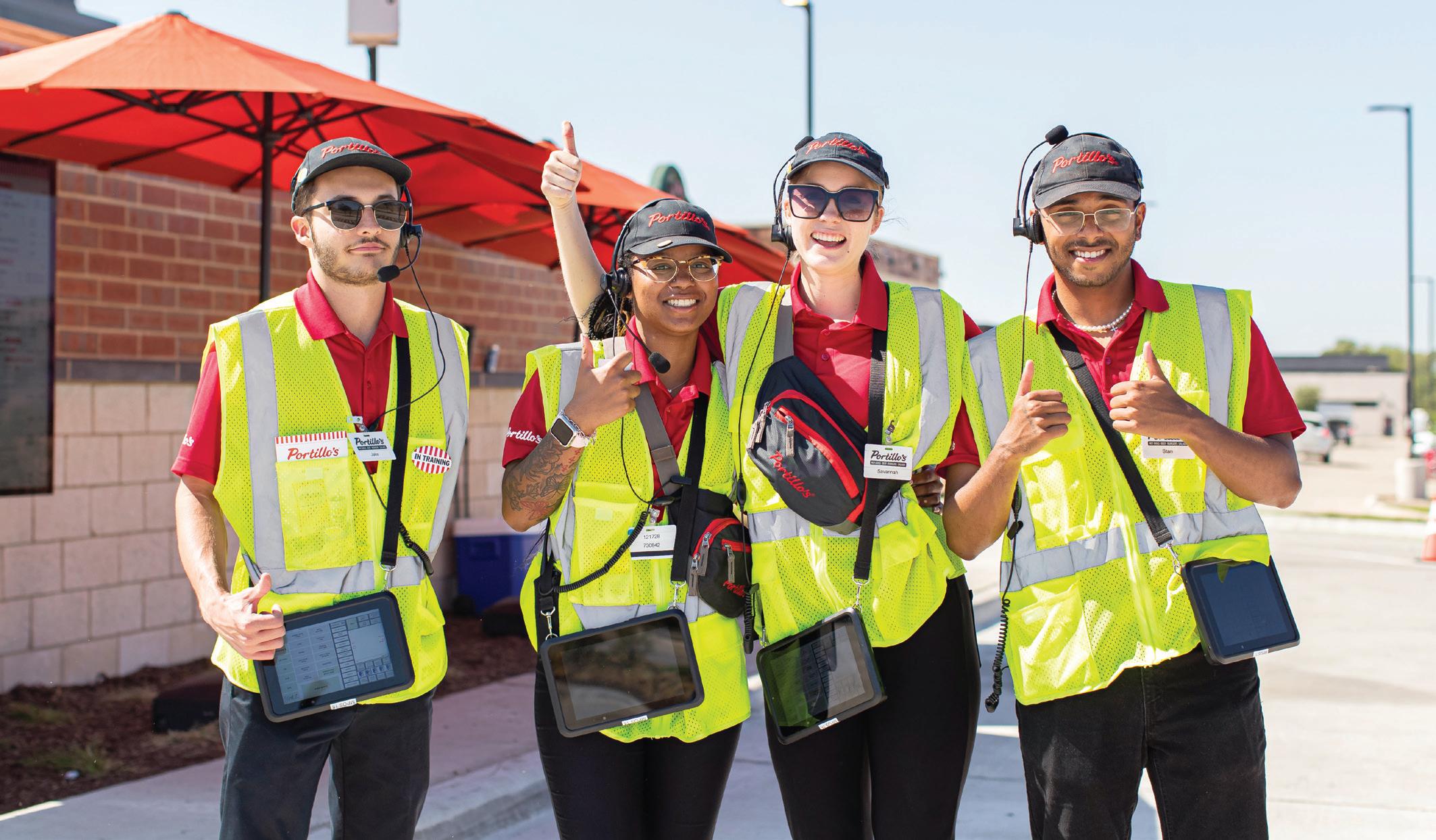






human connection.” The company drills that mindset into employees from the interview process onward.
“It’s about being as honest as we can with them,” Moore says. “It’s not always going to be 70 degrees and sunny. You have to be OK with working in the rain. You have to be OK with working in the snow. You have to be OK working with when the wind is blowing right in your face. Of course, we’re going to do everything we can to rotate you from outside to inside, but setting that expectation from the start is really important.”
From there, it’s all about equipping them with the confidence to strike up conversations and make those face-to-face connections.
“We actually bring baristas to our headquarters and train them at our corporate stands,” Moore says. “It’s easy to talk about it and say, ‘OK, we really want you to have a good conversation with the guest.’ But when they can actually see someone else do it and
see the impact it can have on a customer, it really clicks in their brain and makes a big difference. We want each conversation to be personable. We don’t want it to be scripted. Not everyone’s comfortable doing that at first, but we will stand side by side with you and train you and help you facilitate those conversations.”
Multiple points of contact are another pillar of 7 Brew’s drive-thru model. Guests are greeted by the texter. A minute later, they’re at the lane table having another conversation. A minute after that, someone is bringing out their drink. By breaking up the customer’s wait time with these interactions, the process feels smoother and quicker.
Outside order takers also help guide guests through the menu. That’s particularly valuable given the extensive range of customizable beverages and over 20,000 drink combinations that are available at 7 Brew.
Moore says the biggest benefit is the added efficiency since baristas inside the store aren’t waiting for a customer to pull up to the speaker box to start preparing their order
“If you can stack 10, 15, 20 cars in your line, it’s only going to make you faster because you can constantly be working ahead,” she says. “You’re never bottlenecked by the amount of cars that fit between a speaker box and the drive-thru window.”
To elevate the drive-thru experience further, 7 Brew is focused on leveraging technology through its loyalty program. When customers drive up, they’re asked for their phone number, which automatically enrolls them into the program. With more than 3.2 million loyalty members across 200-plus locations, 7 Brew tracks 92 percent of its transactions through customer IDs. The result is a more personalized experience, with employees able to pull up recent orders and make suggestions based on customer preferences.
That process is becoming even faster and more seamless thanks to the introduction of the 7 Pass, a QR code sticker that guests can stick on their cars for employees to scan. It’s especially popular with frequent guests who stop by on their way to work or school as part of their daily routine
“Those regulars have a lot of customizations, so when we scan that pass, we can see exactly how that special drink was made last time,” Moore says. “It allows you to have an even more genuine conversation because you can just talk to them about how their day is going while you’re pulling up their previous order history.”
Sam Danley is the associate editor of QSR. He can be reached at sdanley@wthwmedia.com


Irish lamb, known for its premium quality and sustainability, is set to gain access to the U.S. market this year, marking a pivotal moment for Irish lamb exports. This milestone will open doors to one of the most dynamic consumer markets in the world.
“Securing access to the U.S. market means new opportunities to showcase the unique quality of Irish lamb and share the sustainability story behind our production methods with a fresh audience,” says Adam Hannon, market specialist at Bord Bia.
Bord Bia, an Irish government agency, supports Irish food producers and exporters in achieving growth and competitiveness on the world stage. With formal approval for Irish lamb imports into the U.S. expected later this year, Bord Bia is gearing up to connect Ireland’s family-run sheep farms with the expansive U.S. market.
“Irish lamb is pasture-raised for most of the year on a grass-based diet, in clean air, under the care of farmers who have been raising lamb this way for generations,” Hannon
explains. “This deep-rooted tradition, combined with stringent quality assurance schemes, ensures that once we secure market access, Irish lamb will truly stand out.”
The introduction of Irish lamb to the U.S. comes at a perfect time, as operators seek new sources of premium, sustainably sourced ingredients to meet rising consumer demand. Quick-service restaurants and fastcasual dining establishments, known for rapid growth and their focus on authentic ingredients, now have a unique opportunity to enhance their menus with the rich flavor and natural tenderness of Irish lamb.
“Quick-service restaurants can really get creative with Irish lamb,” says Hannon. “It’s a versatile ingredient that can elevate everyday dishes. With its natural tenderness, Irish lamb is delicious and easy to prepare, making it a perfect fit for the
fast-paced restaurant environment.”
Holidays and cultural celebrations also provide excellent opportunities for quick-service restaurants to feature Irish lamb. "Irish cultural occasions like St. Patrick's Day offer a prime moment for special lamb dishes, such as Irish-inspired lamb burgers or stews," says Hannon. "These seasonal promotions not only highlight the unique qualities of Irish lamb but also resonate with consumers looking for festive, culturally rich menu options.”
With Bord Bia expecting access to the U.S. market to be finalized this year, the future looks bright for Irish lamb. As Hannon says, “When consumers see Irish lamb on the menu, they’ll know they’re choosing a product that’s not only delicious but also ethically produced and aligned with their values.”
-By Drew Filipski
For more information on Bord Bia and Irish lamb, visit their website at bordbia.ie. You can also explore the profiles of Irish food and drink producers by visiting irishfoodanddrink.com .
◗
How franchisees could gain up to $23 thousand per store every year.

Time equals money, and mistakes caused by poor audio quality have an exponential cost. Inaccurate orders take on average 15 seconds longer compared to accurate ones at the drivethru. By improving accuracy and maximizing car throughput, an owner can add up to $23 thousand per store each year, according to Intouch Insights 2023 Drive-Thru report.
To succeed, quick-service restaurants must invest in high-quality audio communication while keeping an eye on the future of technology. Subpar drive-thru audio quality leads to miscommunication and frustrated customers and employees, which can result in inaccuracies and less e ciency, and ultimately resulting in slower service and less sales.
To improve everything from friendliness to speed of service audio quality must be excellent. Order accuracy is 18 percent higher when the speaker is clear and understandable, and 15 percent higher when the customer does not have to repeat their order, according to Intouch
Insights 2023 Drive-Thru report. As technology inside the restaurant continues to advance, you not only need best-in-class audio, but a platform that grows with your business and technology needs. With HME’s NEXEO | HDX communication platform, you get a solution that ensures the highest quality audio to any channel, whether you choose in-person order taking or voice AI ordering.
“HME-patented audio technology doubles the bandwidth to capture higher and lower voice frequencies, increasing intelligibility and clarity by 20 percent and dramatically reducing outbound noise by 88 percent compared to other systems,” says Scott Mullica, senior director of product management and innovation at HME. The audio quality of a drive-thru directly impacts nearly every aspect of service at a quick-service restaurant.
One way to assist in running a quick and e cient drive-thru is using voice AI ordering. NEXEO | HDX offers seamless integration to streamline drive-thru operations and keep your operation running even if sta ng fluctuates. “NEXEO | HDX enables your crew to support key areas of your restaurant while AI automatically takes drive-thru orders and sends them to the POS to process,” Mullica says.
In addition to best-in-class audio for order taking, HME’s platform enhances your audio quality and accuracy while also streamlining operations to further accelerate your revenue opportunities by integrating ZOOM Nitro. “Our platform also delivers timer-to-headset performance alerts to select team members, stating exactly which metric needs immediate attention,” Mullica says. “For instance, if your drive-thru speed metric is not meeting your set goal, a store manager can get an alert immediately in their headset and take action.”
High-definition audio can transform a good operation into an excellent one, and HME customers will be the first to say how thoroughly NEXEO | HDX impacts operations. “Operators are impressed that while they now have a best-in-class audio system,” Mullica shares, “they also get new functionality on their system every quarter that allows them to operate their restaurant more e ciently.” ◗


A 5-second improvement in speed of service could result in a potential gain of over $8,200 per year per store.* The NEXEO | HDX™ Communication Platform delivers unmatched, HME patented high-definition drive-thru audio, resulting in 20% better clarity and an 88% reduction in outbound noise, and ultimately, faster service. Quality audio is not a luxury—it's a necessity for drive-thru success.
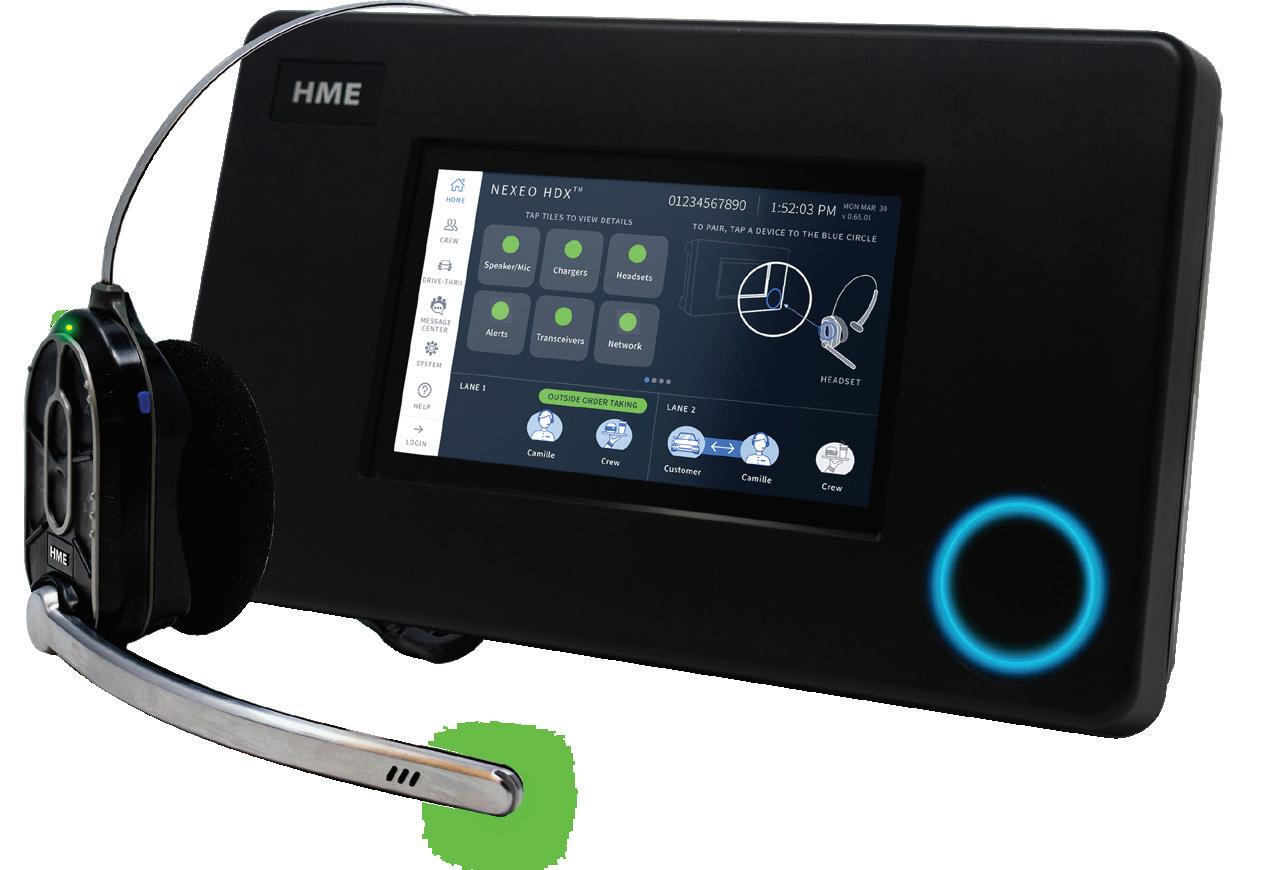
The Persian chain has grown from a family-owned luncheonette into a 30-unit DMV favorite.
BY TALLULAH HAWLEY

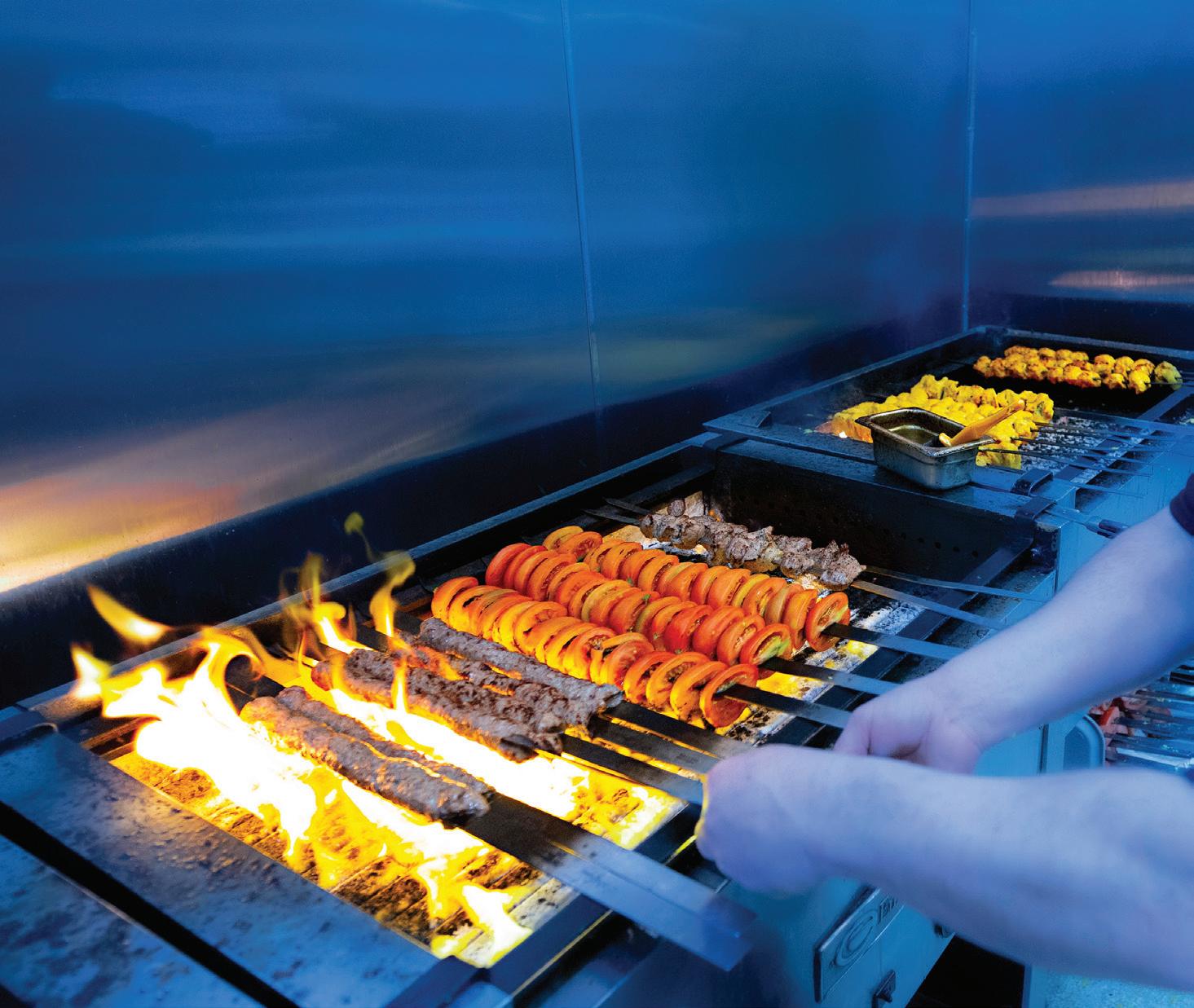
HEADQUARTERS: Hyattsville, Maryland
YEAR STARTED: 1987, but became Moby Dick House of Kabob in 1989
ANNUAL SALES: Undisclosed
TOTAL UNITS: 30
FRANCHISED UNITS: 11 franchised, 19 corporate
ORIGINALLY DRAWN BY THE COLLEGE STUDENT–friendly prices, Alex Momeni began his rise to COO by accepting a call to fix Moby Dick House of Kabob’s neon sign out front, having already frequented the Persian family-owned restaurant many a time. At this point in 2009, the chain had only six locations. Since then, the brand has grown into the DMV’s go-to spot for kabobs, Persianstyle soups and stews, and falafel.
The concept that would eventually become Moby Dick House of Kabob was founded in 1987 by Mike Daryoush as Moby’s Luncheonette, serving typical deli fare like subs and Reubens. As Mike immigrated to the Maryland area from Shiraz, Iran, “He fell back on what he knew best— which was the food that he grew up with,” says Mike’s son Ned Daryoush, who now sits as CEO. Over time, Mike, who passed away in 2019, added a few Persian dishes to the Luncheonette’s menu. They sold so well, Ned says, that Mike decided to build his own traditional Iranian clay oven, which cranked out warm pita bread to pair with the new plates. The popularity of the dishes led Mike to revamp his original establishment in 1989 to Moby Dick House of Kabob.
Ned says people used to approach Mike and ask him why the restaurant was called what it was. “That’s why the name works,” Ned states, smiling, “[ Mike] would say, ‘We’re talking about it!’”
Back in Tehran, Iran, Ned says, a restaurant also called Moby Dick House of Kabob sat next to the American Embassy. The Persian restaurant in the nation’s capital mirrors this original Moby’s, where Americans abroad in Iran would go across the street from the Embassy for a quick bite. Ned recounts that earlier menus had dishes named after characters from the iconic Herman Melville novel, but the company has since moved on from going “overboard” on the theme.
Mike’s vision was to serve flavorful Persian kabobs and platters that were high quality but still affordable. Persian restaurants tend to be sit-down spots where a waiter tends to you, says Momeni, who is also of Persian descent.
“[Mike] wanted to break that, and it worked,” Momeni says.“He wanted to make sure that people would come in several times a week and enjoy their favorite meals without having to bring their families if they wanted not to.”
While Moby Dick is a “treat” of a meal, Momeni says, families can afford to go more than once per month. The utensils and containers are all disposable, but the quality of the meal matches what one would get in a higher-end dining experience.
Moby Dick has pride in its made-toorder system, with ingredients created in its own commissaries. Yogurt, dressings and sauces, desserts, and soups and stews are all specially produced for Moby Dick. The chain also hopes to roll out its signature ready-made dips—such as its yogurt and hummus offerings—available for purchase online in the coming years.
“It’s what makes our

Consistency isn’t just about taste. Are staffing changes causing chaos in your operations? Our automated coffee equipment at SEB Professional offers a solution. We understand the challenges operators face when staff turnover disrupts workflow. With state-of-the-art technology, operators can continue uninterrupted service regardless of changes in their teams. With coffee machines that don’t quit, operators can deliver reliability and consistency with every pour. Experience peace of mind knowing your business is equipped with the tools to maintain quality, even in the face of turnover. Revolutionize your operation and keep the coffee flowing!

Allison Phillips and Mandy Mack paint color on what it’s like to be the driving force behind Orange Leaf.
BY SATYNE DONER
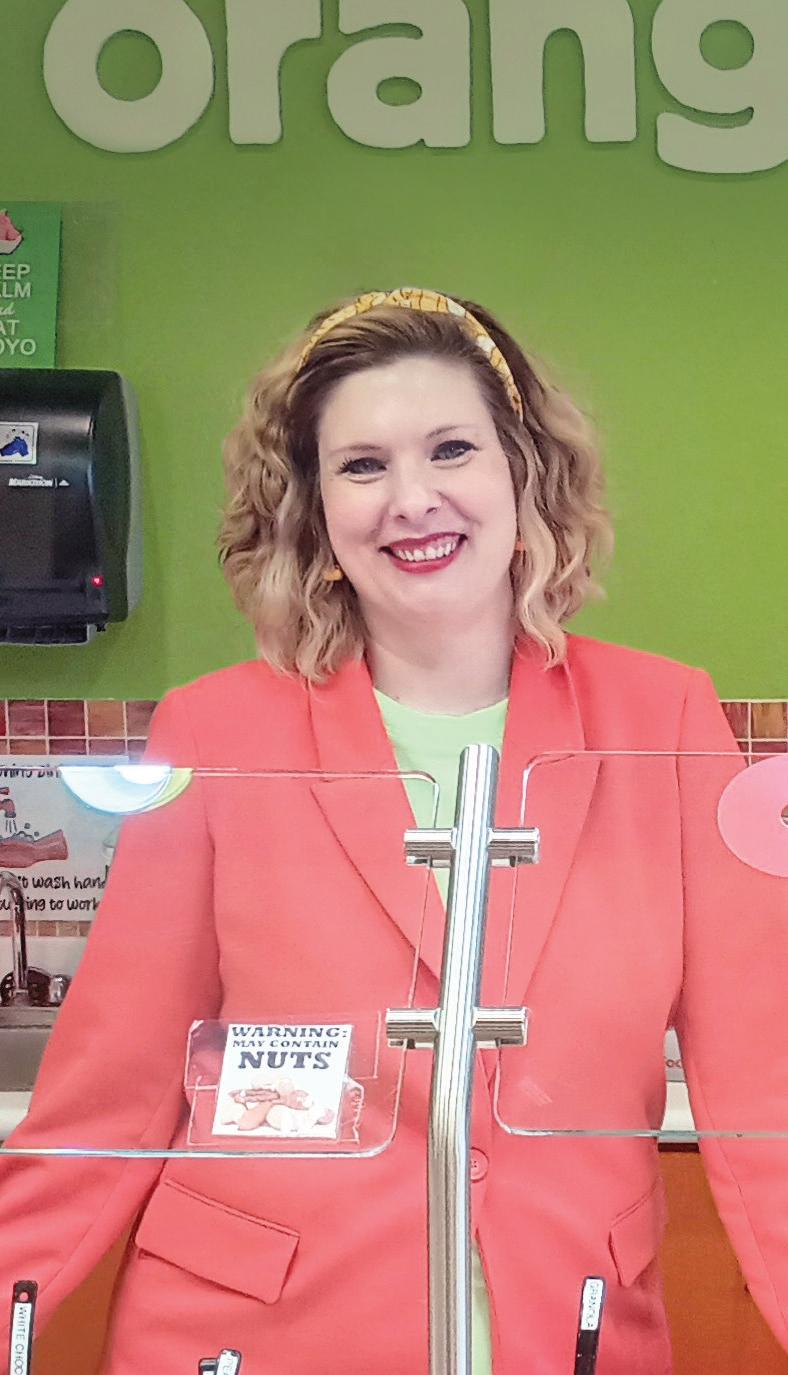
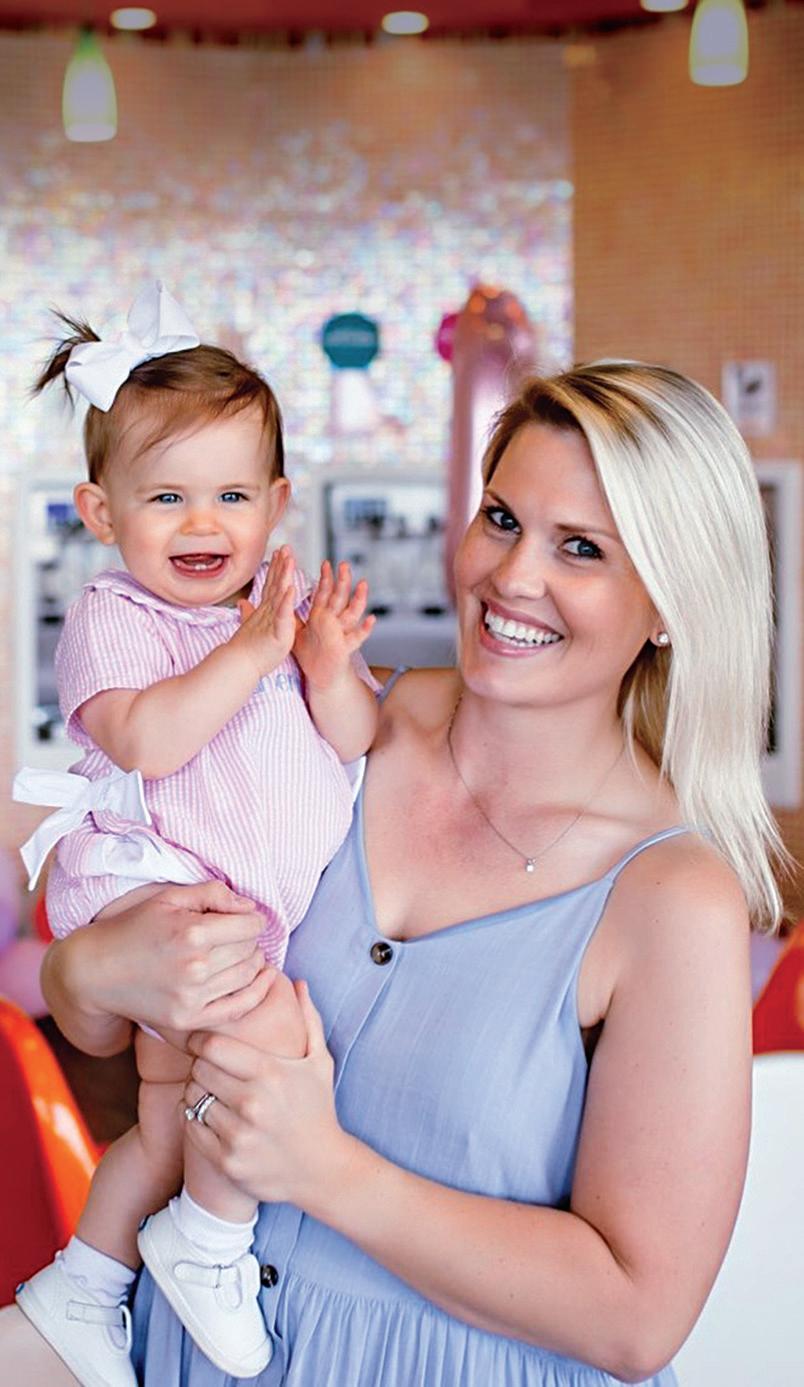
After an Easter dinner, Mandy Mack and her boyfriend were driving around their hometown in Iowa when they noticed an A&W restaurant for sale. A year later, the property was still available, and on a whim, they decided to venture into franchising. Mack’s background was unconventional for a franchisee—she held a linguistics degree, and had experience as a dietary aide, hotel front desk clerk, and pantry chef—but she had always harbored a love for food and hospitality.
After co-owning the A&W for over five years, Mack was ready to take the reins of a business entirely her own. By 2023, Orange Leaf, a popular family-friendly frozen yogurt concept, became available in Mason City, Iowa. Attracted by its streamlined operations and simple labor model, she seized the opportunity.
The fulfillment of becoming a small business owner is something Mack doesn’t take for granted. In an industry where most workers and owners are male, she takes pride in being a role model for others.
“This is a privilege I don’t take lightly,” Mack says. “My greatgreat-aunt was a suffragette who marched for women’s right to
vote, and here I am, owning my very own business. She inspires me, and I like to think about how proud she would be to know she made a difference. I’m working to do the same in a male-dominated field.”
In less than a year as an Orange Leaf franchisee, Mack has surpassed her sales expectations and expanded her product line to include frozen yogurt cakes, a popular addition that has increased average check sizes.
But for Mack, success is about more than just sales. Watching her employees flourish under her leadership is the most rewarding aspect of being a business owner. Most of her workers are young, mostly girls, and she takes pride in helping them develop their skills.
“I like to think my role as an owner gives my female employees someone to look up to. I hope it inspires them to advance their careers and be brave enough to take that first step and then run with it,” Mack says. “Starting your own business is scary and takes a lot of grit, hard work, and maybe a little luck, but it’s possible with the right support system.”
In Evansville, Indiana, Allison Phillips is also making her mark as an Orange Leaf franchisee. After earning a degree in marketing, Phillips turned down a full-time job offer to manage her friend’s Orange Leaf location.
“We were supposed to just meet for coffee, but after talking about Evansville and their store, they asked if I’d be interested in running it. I thought it could be a fun opportunity,” Phillips recalls. “I hit the ground running, touching every aspect of the operation. I always treated it like it was mine … It was always an aspiration for me, and I made it happen.”
In 2017, after six years in management, Phillips felt ready to take over as a franchisee. Despite not having a foodservice background, her passion for leadership and eagerness to learn have driven her success.
Both Mack and Phillips were drawn to Orange Leaf’s operational simplicity and attractive labor model. Phillips has leveraged her marketing background to promote the brand’s diverse product offerings and build-your-own dessert experience.
“People are always going to seek out dessert, and we provide an opportunity for guests to create their own,” Phillips says. “I’m big on ensuring my staff provides an exceptional
A highly effective solution for maintaining restaurant hygiene.

Customer satisfaction hinges greatly on perceptions of cleanliness, highlighting the importance of reevaluating traditional cleaning methods like the rag and bucket approach that may not meet modern standards. QSR sat down with Esperanza Carrion, vice president and general manager of Sani Professional to learn more about why its pre-saturated wipes are better for restaurant cleanliness.
Why are traditional methods suboptimal?
Many quick-service restaurants still rely on the traditional rag and bucket method, where surfaces are cleaned using a towel repeatedly dipped in a sanitizing solution from a bucket. However, this method can lead to crosscontamination, as the same towel is used on multiple surfaces, potentially transferring dirt and germs.
Furthermore, the rag and bucket method can impact your next health inspection, as inspectors closely examine if the sanitizing solution adheres to regulatory guidelines for effective no-rinse sanitizing. If it’s too low, the sanitizer isn’t effective. If it’s too high, the food contact surface needs to be rinsed, which usually isn’t the protocol. An overly treated food contact surface can be toxic and there’s a high risk of human error when staff mix and measure the solution.
Restaurant health inspections are conducted without prior notice, and poor kitchen sanitation is consistently among the top health code violations. These infractions can have serious financial consequences for restaurants and potentially lead to closure.
What makes Sani Professional wipes a better alternative?
Sani Professional wipes come pre-saturated with the right level of sanitizing solution in every wipe. Health inspectors are familiar with Sani Professional wipes and trust their proven effi cacy. Unlike the rag-and-bucket method, these wipes mitigate the risk of cross-contamination since each wipe is used once and discarded after every use.
One of the major benefits of Sani Professional disposable wipes is their convenience. When using the rag-and-bucket method, employees must mix the correct solution and then saturate the towel by dipping it into the solution, which is less than ideal for both staff and the overall consumer experience. Using Sani Professional pre-saturated wipes not only ensures that the right level of quat is consistently released with each wipe but also simplifies the staff process. Customers who use our wipes report that their staff feel more confi dent implementing the cleaning protocol with wipes. When they feel confident, they are more motivated to clean regularly.
What are the additional benefits of Sani Professional wipes?
Sani Professional wipes excel in ease of use with a color-coded system, significantly reducing the risk of human error. These wipes are coded as green for cleaning, red for sanitizing, black for disinfecting, and blue for hands. This simplicity greatly aids in simplifying training which is key in this industry with there being a high turnover rate and potentially an inexperienced workforce. Plus, the color-coded system minimizes language barriers for staff members whose first language is not English. Trusted by major chains, these wipes streamline training efforts and promote appropriate use.
Our wipes provide the benefit of no mixing, no measuring, and no mess. Instead of using potentially contaminated laundered towels repeatedly, the staff is empowered to just pull a wipe, wipe the table, and then dispose of the wipe. So, you know that your tables are cleaned effectively, and done so quickly.
Sani Professional’s comprehensive portfolio includes solutions that are ideal for use in the front and back of house. The red-packaged No Rinse Sanitizing wipes are essential for back-of-house use in effectively sanitizing clean surfaces against common foodborne pathogens as well as Norovirus and COVID-19. By using these wipes, the food preparation process is made safer.
How do these wipes contribute to overall business success?
Sani Professional wipes combine convenience, efficiency, and compliance. By replacing traditional methods with pre-saturated wipes, restaurants can ensure a cleaner, safer environment for guests and staff, ultimately driving business success.
At the end of the day, you have peace of mind knowing your surfaces are clean and sanitized, and your staff feels confident in their actions.
–By Olivia Schuster
Investing in consumer relationships is vital to remaining competitive within the industry. The rise of loyalty programs is one of the best indicators of a successful relationship with consumers, ensuring repeat visits. Overwhelmingly, consumers agree loyalty programs are a good way to save money at their favorite restaurants. In fact, 96 percent of consumers who participate in loyalty programs said they are a good way to get more “bang for your buck,” according to the National Restaurant Association’s Restaurant Technology Landscape Report 2024.
Bb.q Chicken, an up-and-coming franchise featuring authentic, high-quality, Korean fried chicken launched its loyalty program in April at select markets with a full nationwide rollout occurring July 10th. The program was an immediate success with 90,000 users downloading the app and subscribing to the bb.q Chicken rewards program within a few months.
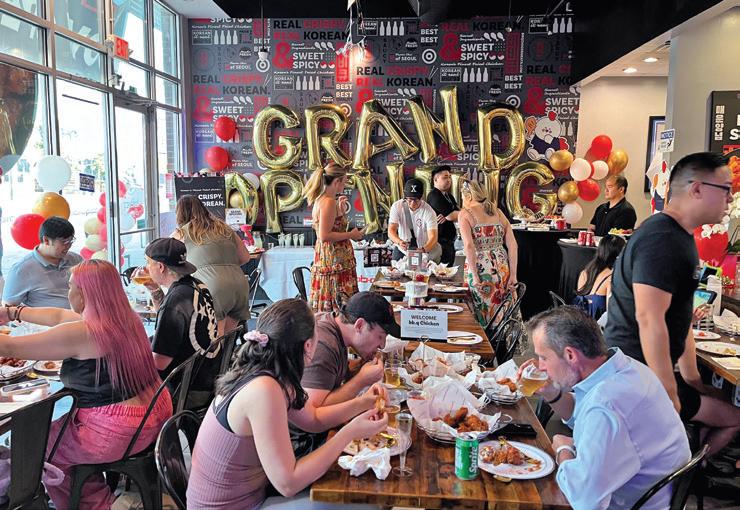

“ Consumers have responded with great feedback to the bb.q Rewards program and mobile app, which have incentivized loyal customers to visit more frequently while o ering the convenience of ordering with just a few taps,” says Andrew Lee senior manager of marketing at bb.q Chicken U.S.
Robust loyalty programs remain advantageous for consumers while supporting franchisees in building and marketing community relationships. “Franchisees have expressed strong support for the rewards program, recognizing its crucial role in personalized marketing and data collection in today’s market,” Lee says. “The program not only drives customer engagement but also enhances loyalty and reten-
tion, which are vital for sustained business growth.” This is of special interest to bb.q Chicken as it is 99 percent franchisee owned.
Future franchisees can expect perks when building consumer loyalty, especially with Gen Z, who are interested in both global flavors and loyalty programs. According to the National Restaurant Association, Gen Z leads in participation of loyalty programs, belonging to an average of 4.4 loyalty programs.
It is vital to consider when restaurants can bring in the most business and perform the most outreach within their communities. For bb.q Chicken, National Wing Day ensured a boost in profits for franchisees around the country, along with an increase in orders through the app and loyalty program sign-ups. “We saw a great impact during our National Wing Day promotion which included 20 percent o orders exclusive to the app,” Lee says. “The number of app sign-ups increased by 48 percent compared to the previous week.”
As bb.q Chicken continues to expand its footprint, the success of its loyalty program underscores the importance of cultivating strong consumer relationships. With the overwhelming support from consumers and franchisees, the program has proven to be a powerful tool in driving engagement, retention, and growth.
As the brand looks to the future, leveraging the preferences of key demographics like Gen Z and capitalizing on strategic promotions will be crucial. By consistently prioritizing customer experience and community outreach, bb.q Chicken is well-positioned to build lasting loyalty and sustain its competitive edge in the market. -Ya’el McLoud ◗




/ BY DANNY KLEIN
WITH DRIVE-THRU DATA:
• ORDER CONFIRMATION BOARDS /P 31
• SUGGESTIVE SELL /P 31
• ORDER ACCURACY /P 32
• TASTE OF MAIN ITEM /P 32
• AVERAGE TOTAL TIME /P 34
• AVERAGE SERVICE TIME /P 36
• AVERAGE WAIT TIME /P 36
• CAR TIMES TOTAL /P 38
• OVERALL SATISFACTION /P 40
• CUSTOMER SERVICE /P 40
• EXTERIOR SCORE /P 46
• METHODOLOGY /P 50


Winning in the industry’s most-vital channel continues to be a puzzle of speed, accuracy, and understanding what the consumer is truly looking for.
Nobody could have turned over a card pre -2020 and realized the drive -thru would soon become the separator between brands that held the wire during COVID- 19, and those who suddenly had lines jamming traffic patterns.
But what was clear at that chaotic juncture was the paradigm shifted. Restaurants welcomed floods of guests, new, lapsed, and loyal alike, into lanes that were, understandably, not always equipped to serve this refocused demand.
It triggered operational responses from multiple lanes to voice-order taking technology to less-visible, yet-no-less vital realities, such as kitchen flow reconfigurations and labor adjustments. The wide point didn’t take a fortune teller to assess: extra volume created higher stakes, or, at the least, a need to satisfy added capacity at the order point—a quick-service challenge as old as the category is.
Amid this torrent also arrived the acceleration of something already stirring. For decades, the drive-thru was a handshake with consumers for their time and wallets. The marketing banner of “food as fuel,” so to speak. Quality and accuracy were elements of the experience, but the bar was “speed” and “affordability.”
Ever since COVID hit, we’ve begun to see this sentiment tilt in our annual QSR© Drive-Thru Report, conducted with partner Intouch Insight. Mystery shoppers pulling into lines at drive-thrus across America have discovered a changed dynamic that mirrors some of the retail disruption consumers witnessed in other parts of their purchasing lives.
Thibault Roux, the chief digital officer at Burger King North America, says the brand’s focus at the drive-thru has become “overall guest satisfaction.” So what is that to today’s quickservice customer?
It’s a combination of speed, accuracy, freshness of food, and service, Roux says. However, based on research and guest feedback, Burger King increased attention on one tick in particular—customer service and hospitality.
“We see that when friendliness is at the forefront, guests have a better overall experience and are wailing to wait longer or forgive small mistakes,” he says.
Consumers have become accustomed to the digital and immediate journey. You buy a pair of sneakers on Amazon and within the time it takes you to close the window have a confirmation email and, soon after, sight lines to when it’s shipped and how long it will take to arrive. All without speaking to anybody.
That transactional face of the drive-thru has become table stakes. Guests don’t expect to shout into scratchy speaker boxes or pull up to assets that look like they need to be sprayed with disinfectant. They’re also mostly used to ordering and then waiting, pulling out a mobile device, and taking a break. What occurs along those checkpoints in the process, though, is where the drive-thru has evolved the quickest.
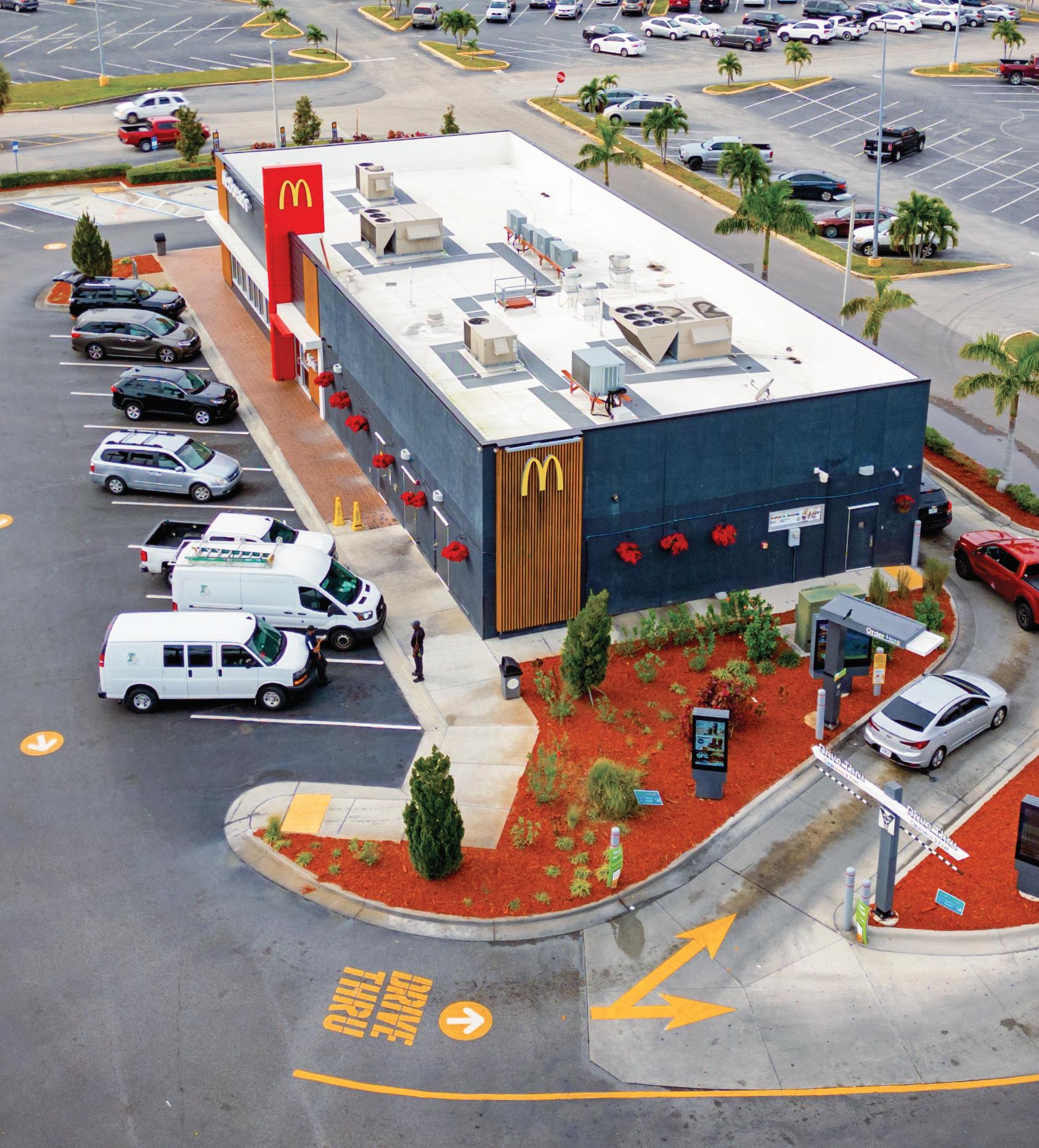
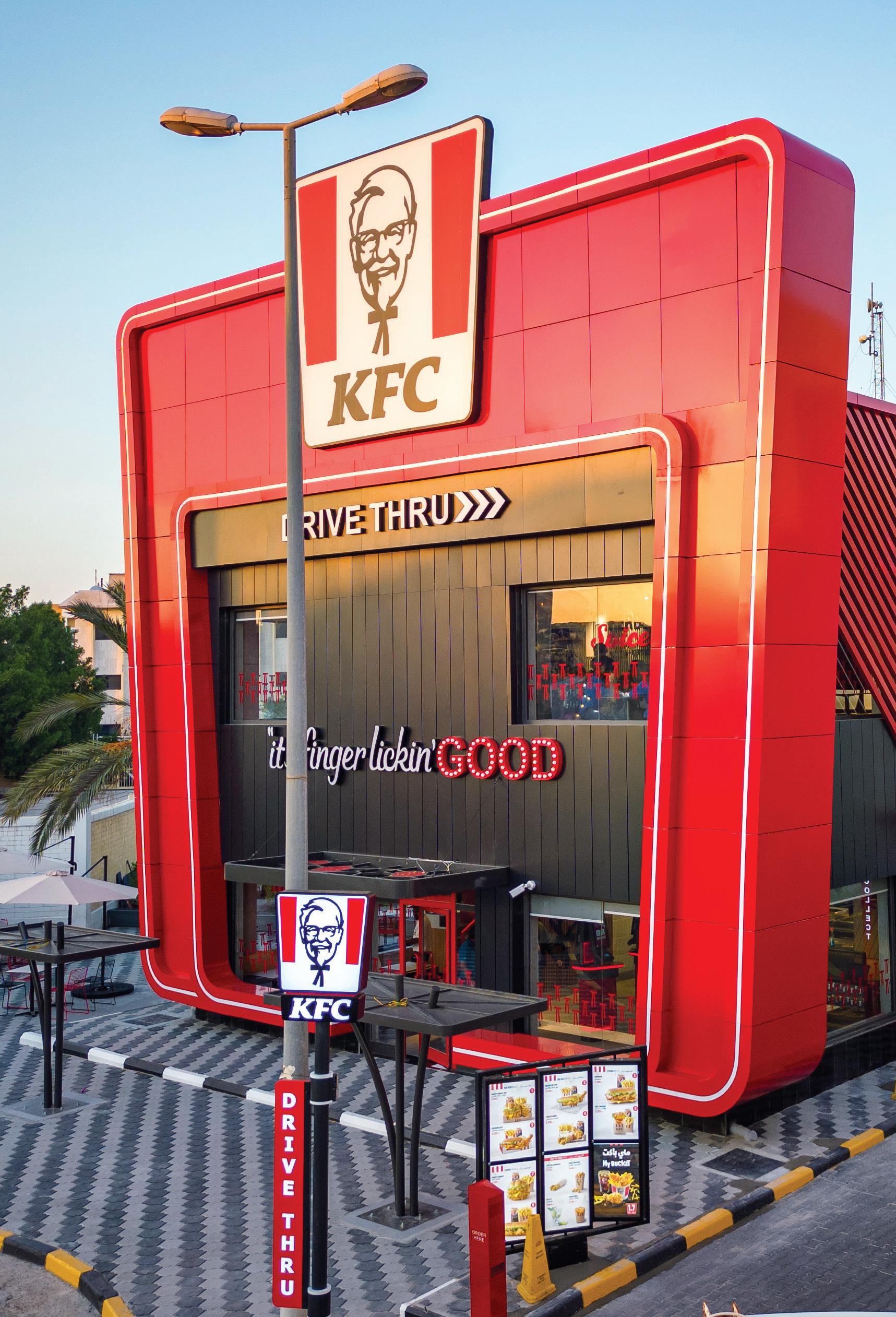


100+100+100+100+100+100+100+100+100+100+100
856963424138151298+38
Vans Nelson, senior vice president, operations innovation at Inspire Brands, the parent company of Buffalo Wild Wings, Arby’s, Dunkin’, Sonic Drive-In, Jimmy John’s, and BaskinRobbins, calls the invent of digital menu boards a “transformational change in drive-thru technology.” The ability to display live updates and transparency explain why accuracy has climbed from a technical standpoint.
In this year’s Report, order accuracy overall hiked to 89 percent, a 3 percent rise from 2023 as operators continue to understand perception can’t always be clocked by a drive-thru timer. More vivid and in support of Roux’s point: order accuracy was 18 percent higher when there was friendly service compared to not friendly service.
99%
Cane’s 99% McDonald’s 98% Taco Bell 98% Arby’s 98% KFC 96% Burger King 95%
Wendy’s 95%
Carl’s Jr./Hardee’s 95%
Dunkin’ 94%
97%
Is that latter result a tangible point or one that gets into psychological depths? The chance is a friendly restaurant employee is going to be better at their job than one in an outward bad mood. Chick-fil-A CEO Andrew Cathy, talking of the broader principle, once referred to this as “cared-for people care for people.” Simply, if you’re delivering friendly service, chances are you’re doing it better than the alternative.
But getting back to the Amazon-effect of retail, this hospitality differentiator might have been glossed over a bit during
the worst of the pandemic. After all, people were coached to avoid each other. Yet it’s now become the divide.
When Burger King introduced “You Rule” in October 2022, it sought to bring the campaign to life, in-store and at the drive-thru, by having employees tell guests, “they rule,” Roux says. It started offering them “crowns” to positively impact the guest experience. Additionally, Burger King implemented “Gold Standard Service” training on core items like the Whopper and fries to ensure food was accurate, hot, and fresh. The brand has also begun testing capabilities within the BK App and at the drivethru to create a more seamless experience without sacrificing friendliness, Roux says.
Peter Hong, global director of operations, engineering, and innovation at KFC, agrees accuracy is “absolutely critical” in this drive-thru climate.
The guest now expects to receive what they ordered exactly how they ordered it. “Incorrect or missing items are inconvenient to some, but unacceptable to many,” he says.
This, too, rolls back through the annals of drive-thru lore. Somebody drives up, puts their hand in the bag, and realizes the fries are missing. If they want to remedy the issue, Hong explains, they’d need to park, exit, and go inside—an action they were trying to avoid in the first place.
“The team member assisting them would then need to step away from their current task to remake the order or get the missing item to the guest,” Hong says.
Put plainly, it’s about as unacceptable, in diners’ eyes, as it gets these days. Accuracy is one of those drive-thru metrics that has multiple tentacles, even though the end result is cut-and-dry.
In QSR’s Drive-Thru Report, order accuracy was 8 percent higher when the customer was asked to confirm their order on the order confirmation board. It was 15 percent better when the
SoundHound’s leading end-to-end voice AI platform transforms how restaurants engage with customers and staff. Our voice AI solutions can help lower employee turnover rates by providing information and training in real time, increase revenue and throughput by automating your drive-thru experience and keep calling customers happy with accurate orders and no hold time. Whatever your restaurant needs, our voice AI solutions can have a tangible impact, making your restaurant of tomorrow a reality today.



interaction via speaker was “clear and understandable” and 7 percent higher when the diner did not have to repeat their order. Lastly, accuracy came in 12 percent above the field when the volume of the speaker was loud enough to hear the employee.
Accuracy has only gained relevance in a value-focused marketplace that thins the margin for error, Nelson says. It “remains the most impactful KPI in measuring success in our drivethrus,” he says.
“Speed of service is also essential, with consumers valuing quick turnaround times to minimize wait,” Nelson adds. “Effective wayfinding also ensures smooth navigation through the

drive-thru lanes, optimizing the overall guest experience. Guests are seeking a distinct, personalized drive-thru experience.”
Blake Devillier, president of Carl’s Jr. USA echoed Nelson’s thought. “Historically, speed was the primary driver of drive-thru success,” he says. “However, the evolving restaurant landscape demands a more holistic approach. Today, guests seek a seamless experience encompassing speed, accuracy, quality, and exceptional service. In essence, while speed remains crucial, it’s merely one component of a successful drive-thru strategy.”
Elaborating on speed, Hong adds people are a bit more flexible, especially when they know the food is made fresh to order. But everything has its ceiling. And speed is an equation that pays itself off for restaurants as more transactions equal more revenue.
Taco Bell took the QSR© Drive-Thru Report crown as the fastest drive-thru in the industry for the fourth consecutive year.
Examining broader trends, it begins to crystalize how “speed” itself isn’t losing traction necessarily. It’s the building blocks within that are rising and falling.
Wait time in 2024 was 3 seconds slower than 2023. Service time—how long it takes to get the food to a customer after their order is taken—was 17 seconds faster, year-over-year. Total time was 14 seconds faster.
Total time was 13 seconds better when the volume of the speaker was loud enough to hear the employee. Total time was 27 seconds ahead when the customer didn’t need to repeat their order and 28 seconds faster when the interaction via speaker was “clear and understandable.”
Bringing the point full circle—total time was 28 seconds

Deliver smarter, personalized journeys with ACRELEC
one partner that can do it all
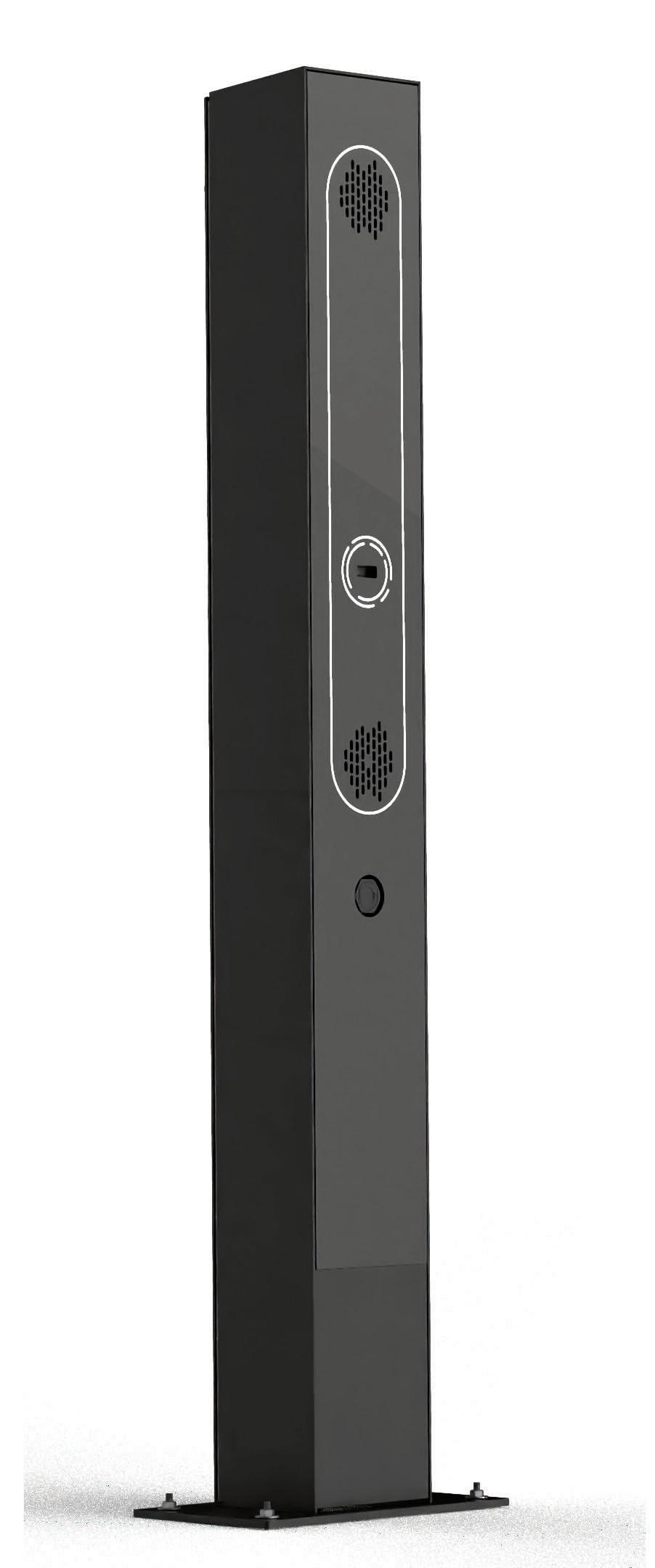

faster when there was friendly service.
So there are a few things to unpack. Past QSR© Drive-Thru Reports have shown a distinct cliff in speed acceptance among consumers at the “wait time” and “service time” split of drivethru experience. Essentially, how long somebody is willing to wait to have their order taken versus how long they’re content sitting until they get the bag. Chick-fil-A has rewritten the parameters of this topic in recent years with its in-line ordertakers and system of delivering hospitality at multiple points through the experience.
Like usual, Chick-fil-A was the “slowest” brand in this year’s Report across multiple measures. For “average wait time,” it was roughly 55 seconds behind the next in Raising Cane’s ( a first-timer in the Report ). On “service time” it came in last as well (see charts below), and for total time Chick-fil-A custom-
ers waited 479.42 seconds on average. McDonald’s was ninth out of 10 at 375.67 seconds.
By now, understanding why is a recurring theme rooted in context. Chick-fil-A had 3.44 cars in line when mystery shoppers pulled up. Raising Cane’s followed at 2.44, McDonald’s at 1.48, and Wendy’s at 1.01. No other brand was above .72. A sign of Chick-fil-A’s undeniable busy restaurants—the brand’s standalone drive-thrus pushed average-unit volumes in excess of $9.3 million in 2023. Nearly 1,000 of the 2,049 stores counted were at that number or above. One reported $19.094 million, which is nearly $7 million more than the average take of a Cheesecake Factory.
If you factor the total time with cars in line ( basically how fast each vehicle was being moved ), Chick-fil-A reported a time of 139.4 seconds. That was about 12 seconds faster than


the next competitor, Raising Cane’s, and 512 seconds better the last-place finisher. Basically, it flips the speed conversation.
The larger theme, however, returns to the separating elements. Across the Report, overall satisfaction was 94 percent—4 percent higher than 2023. Friendly service increased by 6 percent over 2023, to a score of 79 percent.
And here was the headliner: overall satisfaction was 78 percent higher when there was friendly service compared to not-
friendly service. One more—overall satisfaction was 17 percent better when the order was accurate.
Chick-fil-A was 7 percentage points alone in first place for guests who deemed the service “friendly” at 95 percent ( Raising Cane’s was next at 88 percent). It scored a 99 percent in “overall satisfaction” as well.
Resurfacing Roux’s conversation of how you chase this KPI of happy guests, the data reveals where the threads flow. Friendly employees and accurate fulfillment equal speed, both in the literal and perceptive sense. The pillars of the drive-thru move faster when the technology, operations, and labor connect. So perhaps the true aftermath of the COVID drive-thru rush isn’t merely elevated usage; it’s the death of speed for the sake of speed as restaurants knew it.
Speed has evolved toward a KPI that’s end aim is guest satisfaction rather than guest acceptance.
“At Carl’s Jr., we are planning to use a data-driven process to establish our ideal speed of service,” Devillier said. “By meticulously analyzing factors such as menu composition, restaurant layout, and customer ordering behavior, we aim to create a seamless experience for our guests. If we can find the


right balance of quality, accuracy, hospitality and speed, we can improve both the team member and the guest experience.”
Matt Abercrombie, senior director, service and hospitality at Chick-fil-A, Inc., says as the industry continues to morph, guest needs remain steady. “We know that our customers want a quick and convenient experience with freshly prepared food,” he says. “They want their orders to be correct. And they
want to be served by friendly team members. Our drive-thru innovation is centered around ensuring we can continue to consistently deliver that experience as more customers come to dine with us.”
Chick-fil-A, rightfully at times, can be labeled a throwback brand in the sense it makes statements like the one above. It doesn’t overcomplicate what matters. But how it gets there,
95% Raising Cane’s 88%
82%
Jr./Hardee’s 79%
77%
King 77%
77% Taco Bell 77% Wendy’s 68% Dunkin’ 66% TOTAL 79%

especially at the drive-thru, isn’t old-school.
The brand has been rolling “Mobile Thru” designated pickup lanes through the system as it looks to give customers options in experience. More are planned for 2024 and “even more” for the following calendar, Abercrombie says. “We are also continuing to work on our inclement weather solutions for our team members in the drive-thru, as well as technologies that
help us evaluate how our drive-thru operations are performing in real time so we can ensure we’re delivering an efficient, friendly experience,” he adds.
In July 2023, Chick-fil-A released a rendering of an elevated drive-thru with four lanes and space for “two to three times” more cars than a traditional setup. Of anything the brand has done emerging from COVID, whether it’s outdoor elements


or makeshift lanes or tech, this illustrated arguably the most striking vision of Chick-fil-A’s drive-thru potential. The Jodeco Road location, owned and operated by Brett Lewis, who relocated to his hometown to open the concept, debuted late August in Stockbridge, Georgia. Guests can order with an employee in the traditional lanes or use one of two dedicated Mobile Thru options with orders placed via the Chick-fil-A App.
Created with on-the-go guests in mind, Chick-fil-A said the elevated kitchen design doubles the restaurant’s capacity and expedites service. A sophisticated conveyor belt system transports meals from the kitchen to ground-level employees.
Abercrombie says Chick-fil-A will learn from the high-volume asset to understand go-forward possibilities. “As we look toward the future, the needs of our customers remain a top priority, all while considering new ways to increase efficiency and make the drive-thru experience more seamless and enjoyable,” he says. “However, as we evolve as a brand, our future drive-thru concepts will continue to showcase team member touchpoints and moments of personal interaction with guests to ensure the hospitality we are known for is not lost.”
Taco Bell on the last day of July announced it planned to expand automated voice ordering at the drive-thru to “hundreds” of restaurants by year’s end. To that point, the technology was live in more than 100 U.S. units across 13 states.
Taco Bell tasked the tech with improving back-of-house operations for employees and improving the ordering experience. The chain said it saw an ease in job load for workers and better order accuracy, which resulted in a more consistent drive-thru
execution and lower wait times.
Jason Kidd, global chief operating officer of the chain, says the overarching goal was to provide ease to team member experience “with a distinctive Taco Bell twist.”
“To achieve this,” he says, “we continuously listen to franchise partners and team members, spending time in restaurants and gathering feedback, to leverage their expertise and stay ahead of industry needs and expectations.”
“By leveraging feedback, data, and insights, we enhance consumer relationships with intuitive, user-friendly technology that minimizes the learning curve,” he adds of AI specifically. “The expansion of Voice AI is part of our sustained effort to integrate AI into our operations, aiming to create a best-inclass experience that drives operational excellence.”
An initiative that emerged from these overall efforts at the nation’s fastest drive-thru chain was a Touch Kitchen Display System that allows employees to prioritize orders based on size and complexity, build access cards, ands share orders with other workers. As a result, orders are delivered more efficiency and accurately, Kidd says.
A few innovations in recent years include: mobile orderahead options, which made pickup more convenient for guests and couriers; streamlined drive-thru digital menu boards; new features within the Touch KDS to intelligently synchronize orders with driver and customer pickup times; and back-ofhouse changes like Poseidon (order management and reporting), and AI-driven inventory management. Both give employees the breadth to focus on the customer satisfaction metrics mentioned throughout the Report, Kidd says.
Taco Bell has the ambition to become a 100 percent digitalfirst brand, with an integrated ecosystem where tech enhances
Our digital signage solutions are powered by purpose-built CMS tech stack that integrates with an array of POS platforms.
Allowing you to deliver dynamic, real time digital menu content that’s automated, accurate and synchronized across displays and devices.
Drive up transaction value, through-put and profit – but most importantly – guest satisfaction scores.

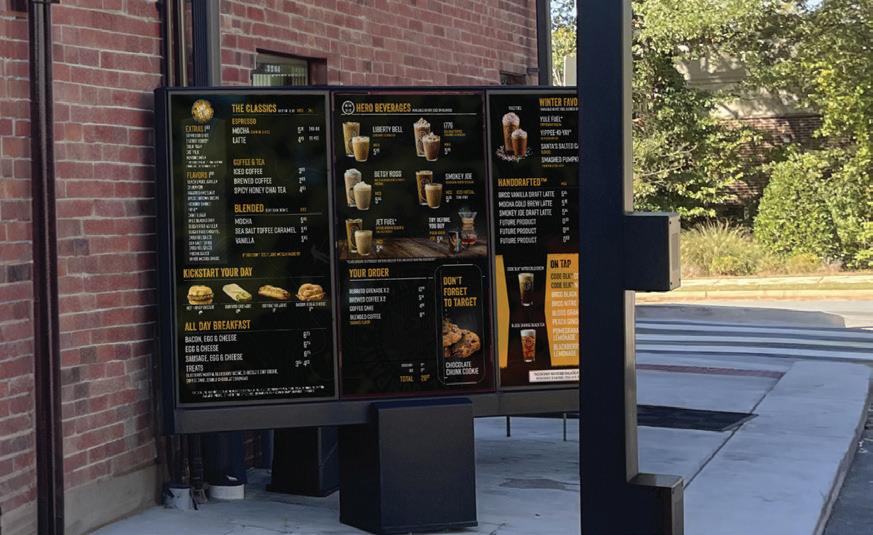







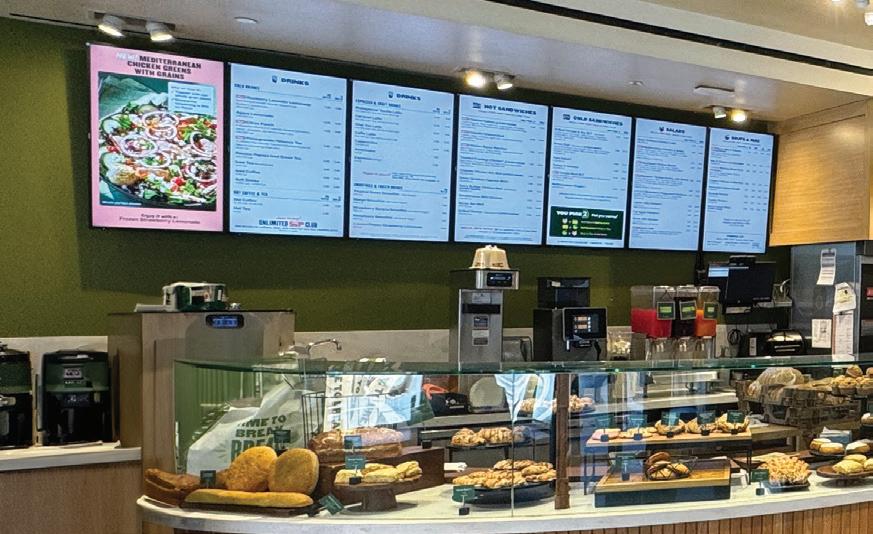


Unleash the Power of POS Integration, Clarity makes it possible – and profitable.

No matter what phase of your digital signage journey, let us put our use cases to work for you. Connect with us for a demo of our software at www.cri.com


all aspects of operations. This, of course, includes the drive-thru.
It’s not surprising to see AI and other tech flood Taco Bell’s world. The speed strength of the brand speaks to understanding its base and what they expect of Taco Bell. In 2023, the chain launched the latest iteration of its Go Mobile design, which compacts square footage and features more digital touchpoints than any location. “This new concept addresses the industry-wide issue of drive-thru bottlenecks by including double drive-thru lanes, eliminating the indoor dining area, and adding dedicated parking for mobile and delivery orders, along with an outdoor pickup window and grab-and-go shelves,” Kidd says.
But just like Chick-fil-A’s decision to build a restaurant that can house some 75 cars at once, every decision is a brand-by-brand dive into what matters to its core and where it wants to go.
Naturally, there’s ample chatter through quick service surrounding AI drive-thru voice ordering. McDonald’s made the call earlier in the year to move away from its ongoing test, although it could resurface in time. Restaurants are still very much figuring out the process and if it fits their needs. It’s more complex than the baseline benefits tout—100 percent upsell from a machine versus a human, no breaks in the loop detector, and the ability to reallocate labor to a generally easier job, such as handing food to a guest and delivering friendly customer service.
QSR© Drive-Thru Report partner Intouch Insight surveyed nearly 1,500 consumers in March to take the pulse of it.
When asked how consumers felt about AI-enabled voice to automate drive-thru order taking, 45 percent reported “not liking the idea of it,” compared to 47 percent last year. However, when examining the data from demographic angles, 33 percent of respondents aged 18–44 reported “not liking the idea of it,” compared to 54 percent of those aged 45 and above.
It uncovered a clear split between generations in terms of acceptance and preference for AI technology.
Like any innovation, acceptance to “try” and desire to “use” veer by age brackets. AI remains a relative unknown when it comes to true preference since people are, more often than not, answering questions on the theory instead of the experience. Taco Bell is taking a bet on its in-house platform and ability to serve a consumer group that’s used to the company innovating on the front-lines. And akin to when credit cards arrived all those years ago, or mobile ordering, etc., acceptance will start to reflect reality—does the tech do what it promises? That
















explains the relatively immaterial year-over-year change (45 versus 47 percent). We’re still a ways away from the day when enough restaurants deploy AI voice ordering at the drive-thru to understand if guests want it.
Case in motion: only 19 percent of those surveyed said they’d experienced AI-enabled voice technology to automate drivethru order taking. But 61 percent of those who did said they enjoyed the experience.
Intouch Insight asked that same question regarding the use of AI-enabled video tech to identify repeat customers and enhance experience. There, 42 percent of respondents said they “do not like the idea of it,” down just 2 percentage points from a year ago. Thirty-two percent of people aged 18–44 polled “not liking the idea of it,” compared to 49 percent aged 45 and above. Again, the data was mindful of changing demographics.
Nelson sees AI, automation, and tech coming together to provide employees with the tools necessary to achieve better guest experience. That’s a present point.
Inspire is working on geofencing across brands to better satisfy digital guest behavior. It allows the restaurant to serve loyalty and app members as soon as they enter the drive-thru.
Order-ahead and third-party drivers can also deliver orders directly to customers near, but not in the drive-thru lane, at select Dunkin’ locations.
“In locations where we have tested these technologies, we saw an increase in the speed of service, accuracy, and guest satisfaction,” Nelson says. “Our team members are also responding positively, as this frees up their time to be redeployed toward other roles with higher guest touchpoints and can support continuous flow.”
Nelson says AI, in Inspire’s view, is something other than
a “single moonshot idea that will solve all inefficiencies.” The company believes it’s a tool that can work alongside employees and existing technologies to drive efficiencies through more enhancements the consumers doesn’t necessarily see— like sticky printers, optimized kitchen display units, and POS systems. They’re all AI-driven inventions capable of supporting drive-thru improvements.
“We are using AI vision systems to decrease wait times, enhance accuracy, support team members with inventory management, and engage with drive-thru guests during order taking to provide personalized suggestions to our guests,” he said.
Inspire is unique given its approach covers solutions extensible across six brands. Nelson says as a shared service supporting multiple concepts, his team must develop a unified approach to site planning in the drive-thru, standardizing car stacks, wayfinding, and cockpit design. “We collaborate with everyone from the construction, real estate, and restaurant team members to identify and capture opportunities across each touchpoint.”
Each of Inspire’s chains has off-premises capabilities, and almost all of them have a drive-thru. So the cross-brand collaboration spreads learnings. That shared knowledge also creates a richer data set, Nelson says, which powers Inspire to use guest feedback to zero in on what’s most important. “We can then take that consumer feedback and use AI to combine it with the restaurant’s historical sales and forecast demand. This data then gives our restaurant managers a better understanding of how we can enhance our interactions with guests and where technology can be deployed to provide restaurants with the data they need to best serve our guests,” he says.
KFC’s Hong says the brand, internally, has gone straight to the source to understand and address drive-thru opportunities. It launched a guest and employee listening program called “KFC Listens.”
“When our team members share where there are opportunities for efficiency related to our drive thru, we listen,” he says. “And there’s a good chance that if a team member in one restaurant spots an opportunity, dozens more have, too. When we make adjustments or implement new


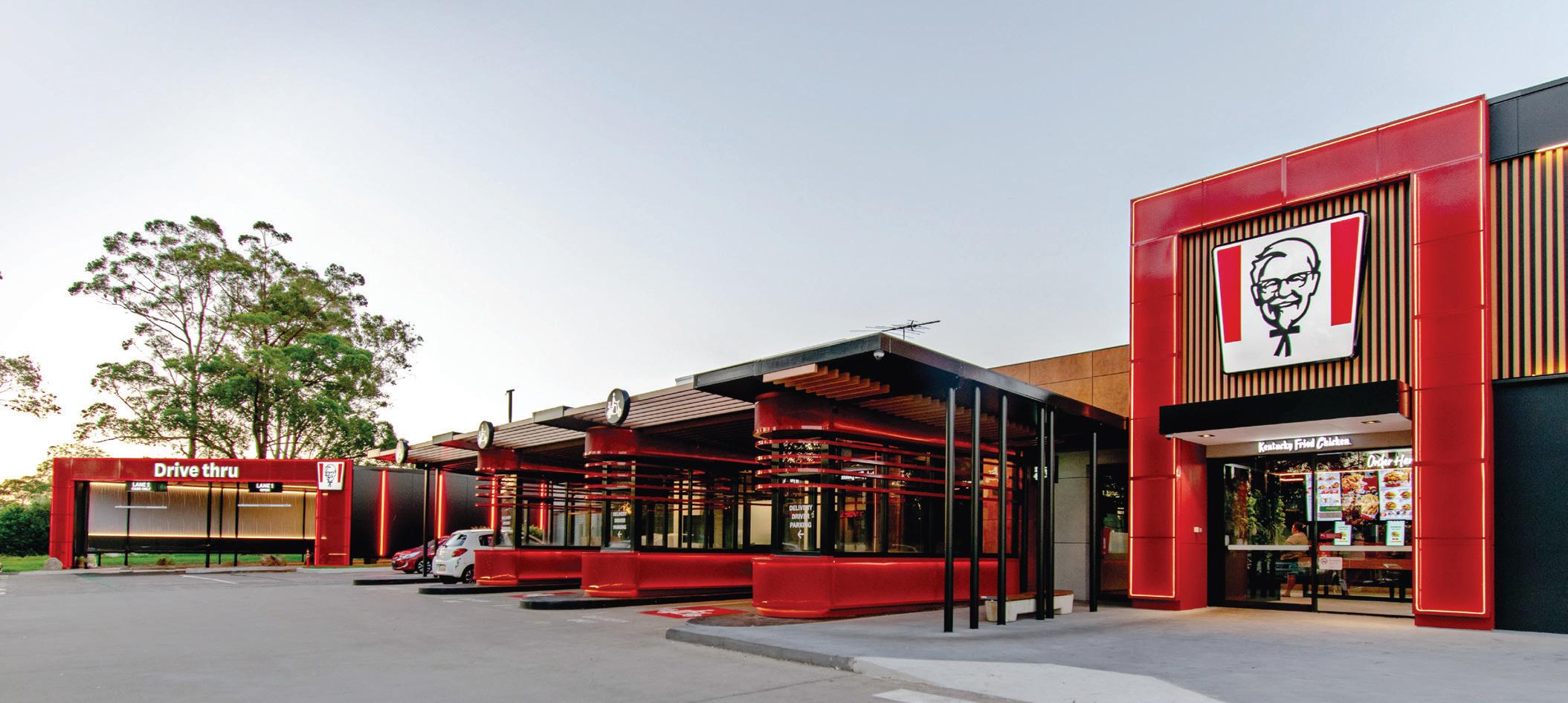
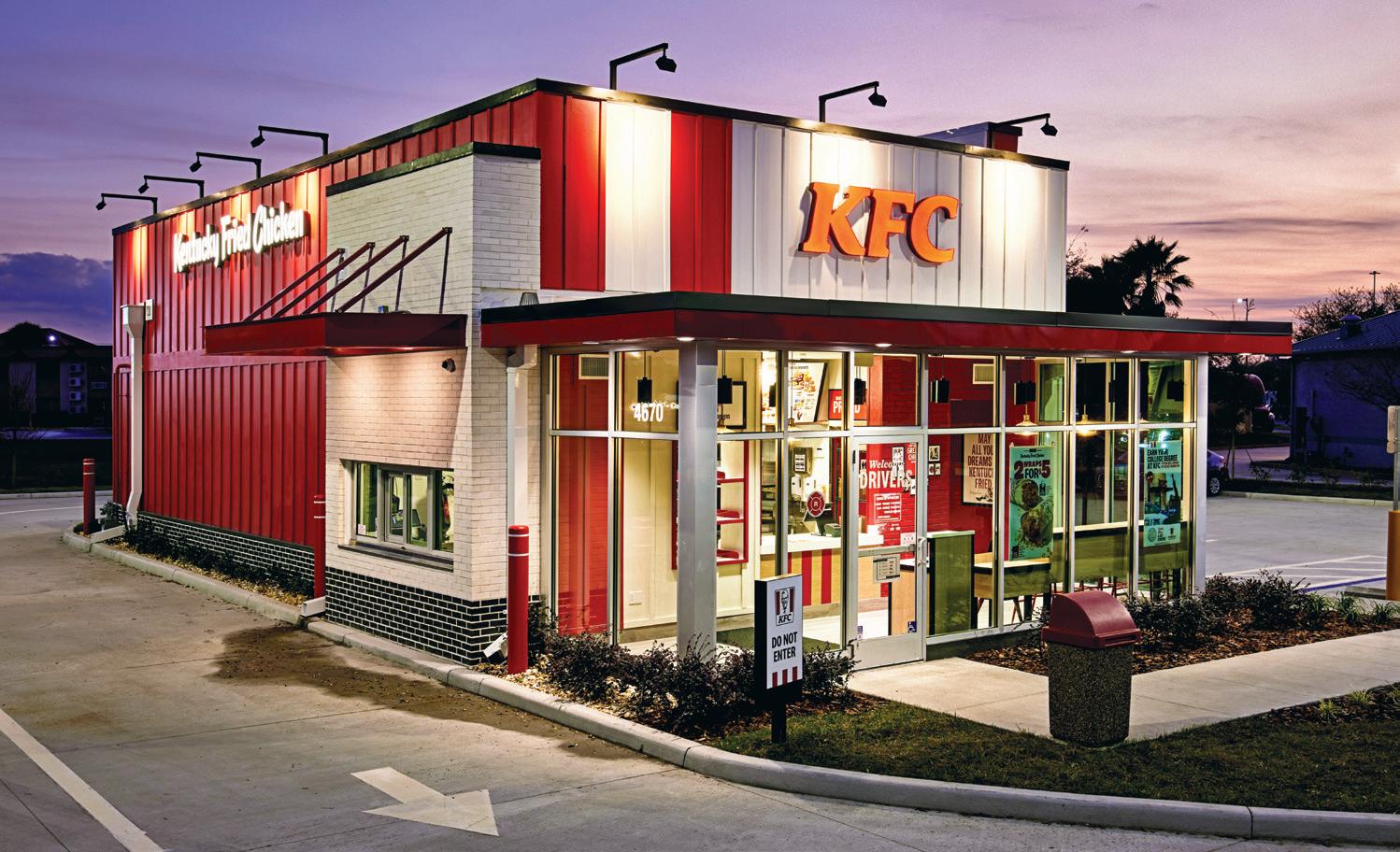
processes to address these friction points for team members, it makes their jobs and lives easier and often improves the guest experience as well.”
Externally, the brand uses KFC Listens to collect feedback and see how it might adjust. It can pinpoint specific issues, such as one store serving cold fries in drive-thru orders during the post-lunch rush. That feedback is available to GMs to provide in-shift feedback. KFC can also aggregate performance trends on a larger scale—”a capability that will enable us to ground our global operations strategy in feedback directly from our guests,” Hong says.
Framework is vital to understanding drive-thru innovation. At its core, the drive-thru is a human, uncomplicated transaction. Guests want food without getting out of the car; they want it to be hot; what they ordered; and for employees to deliver hospitality at the handoff. So any technology, Hong
says, can’t be viewed as simply attacking friction.
When assessing options, he adds, KFC looks for three signs of success: One, improved team member experience; two, improved guest experience; and three, the ability to drive profitable growth for franchisees.
“That’s why I’m excited about the recent launch of our Voice AI ordering trial in Australia,” he said, “which is being embraced by team members and guests alike. We’ve seen the technology ease the task load for team members to focus on their task at hand and provide a consistent, friendly experience while improving accuracy.”
“AI is a quickly evolving space so we’re continuously assessing where to implement this technology to improve the experience for both our guests and team members,” Hong adds. “When considering Voice AI order taking, I’m most excited about the powerful combination of the innovation and efficiency AI brings and the uniquely human connection our wonderful team members provide to guests.”
KFC, opening stores at a clip of a new unit every 3.5 hours, has no shortage of builds. There are single lanes, dual, double single lanes, drive-thru-only stores, two and three windows (one pay, two pickups), and conveyor systems, to name a few. “I would describe the drive-thru of the future as a faster, more connected, more personalized experience—leveraging technology while maintaining that human connection,” Hong says. Inspire has drive-thru-only and digital-forward formats,
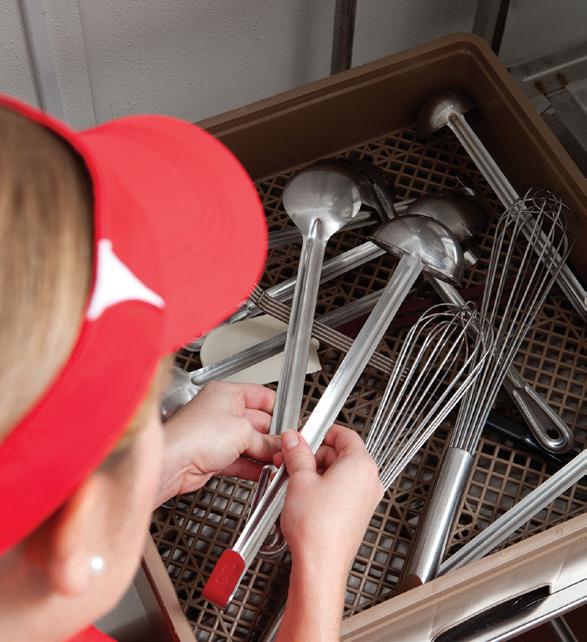
FOOD SAFETY
90% MORE SOIL REMOVED* compared to manual only process*
LABOR SAVINGS
WATER SAVINGS
REPURPOSE 2 HOURS OR MORE labor per day*** vs. traditional dump/fill machine
Designed specifically for QSR applications, the XL has a higher wash chamber, 50% faster cycle time, faster dry time, and delivers productivity and food safety at a lower total cost.

6,400 GALLONS OF WATER SAVED PER YEAR** Standard Height
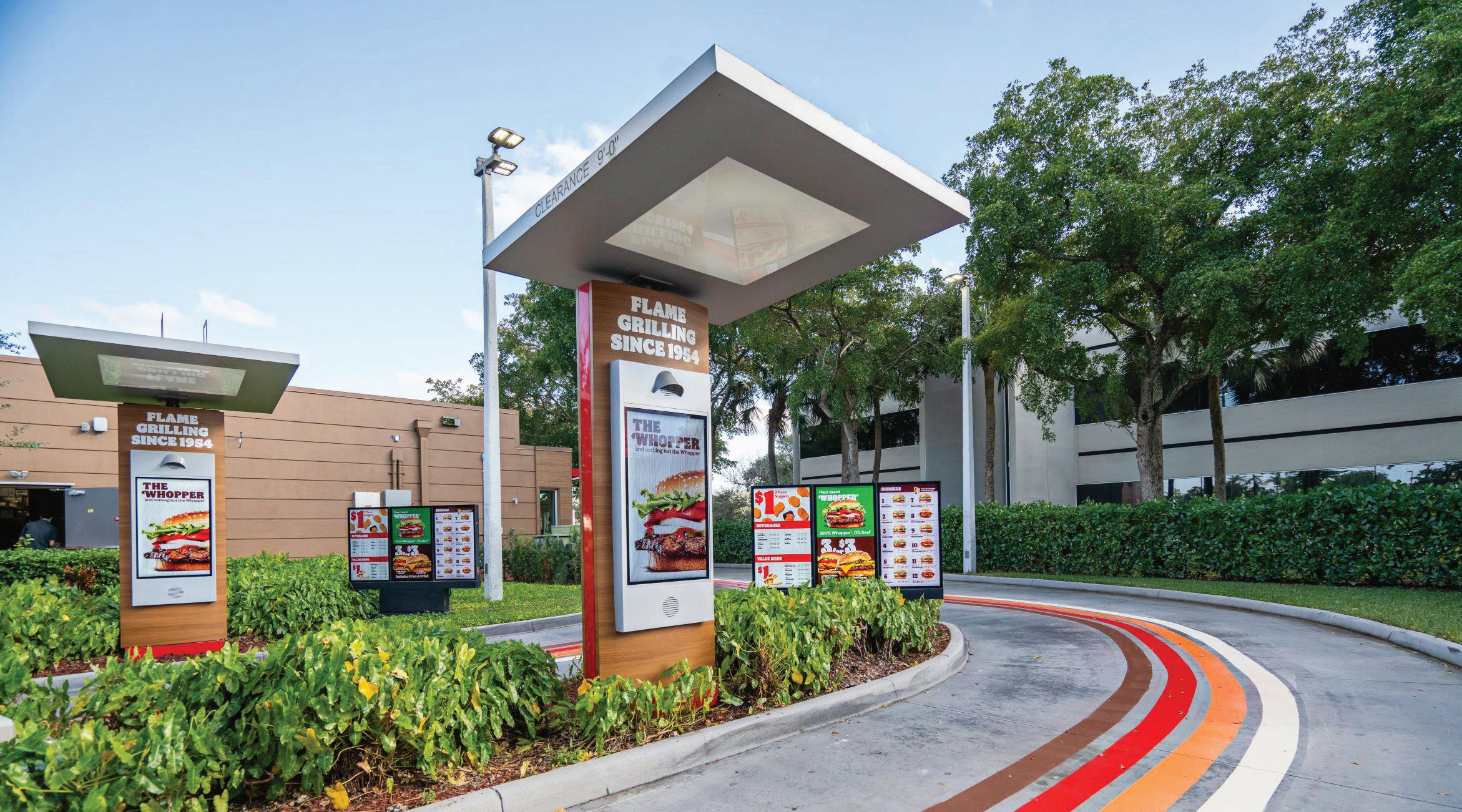
most notably in urban areas and college campuses. They’re often equipped with dual lanes and mobile pickup options. In high-traffic locations with a high propensity for drive-thrus, Inspire innovated construction around small lot sizes, co-location opportunities, and its Universal Modular Design. There’s a Dunkin’ that’s less than 1,000 square feet capable of supporting multiple lanes—one for people who order in advance on the app and a traditional lane. They can be outfitted with a walk-up window, too.
Shoppers were instructed to visit the restaurant’s drive-thru to place a live order and take note of several key aspects such as: speed of service, order accuracy, customer service, taste, etc. There were 10 brands shopped, with 165 shops per brand (with the exception of Arby’s, which had 166 shops). Shops took place in June and July and were geographically spread across the U.S. Shops were also spread across four dayparts: breakfast, lunch, afternoon, and dinner. Below is a breakdown of shops completed per daypart:


Burger King is in the process of quickly building and updating “Sizzle” stores. Introduced last year, the model includes the option for double lanes and a canopy. Additionally, Burger King, like others, is testing Voice AI, Roux says, which will integrate with the brand’s broader ecosystem, including loyalty and contactless payments. It’s also piloting separate lanes for on-site ordering and pre-ordering via the BK App or online.
“There is still a lot to learn when it comes to AI and the potential to leverage it in our drive-thrus and other high impact areas of the guest and team member experience,” Roux says.
“We know that things are always changing and evolving when it comes to the guest experience, including the drive-thru, so our focus is investing in the things we know aren’t likely to change—consumers wanting friendly, fast service, accurate orders, and fresh, hot and delicious food,” he continues. “As we look to the future, we will continue to test and implement how we leverage technology to ensure we’re achieving those things in a way that meets our guests where they are.”
Adds Nelson of the so-called drive-thru of tomorrow: “The drive-thru of the future aligns with our three goals: guest satisfaction, team member satisfaction, and restaurant profitability. Guests have a smooth, personalized experience enhanced by digital components and executed efficiently by our team members. Our kitchens are supported by smart, technology-enabled decision-making and require fewer manual tasks, allowing our team members to interact meaningfully with guests. Investing in our team members and delivering an exceptional guest experience is at the heart of our business.”
Danny Klein is the editorial director of QSR and FSR. He can be reached at dklein@wtwhmedia.com







ACRELEC has provided innovative hardware and software solutions to restaurant and retail brands throughout the world for over two decades. We are focused on achieving the highest level of customer satisfaction by delivering fully customizable technologies that are proven to increase revenue, improve operations, optimize staff efficiency and drive better consumer engagement.



Ready Access is your go-to source for Drive-Thru/Walk Up service windows and air curtains. A trusted market leader for over 40 years, specified by the largest restaurant chains worldwide. The perfect balance of durability, value, and function! All windows feature self-closing operation to meet health code.
Please call or browse our website to find the best configuration for your restaurant, including designs for energy efficiency, hurricane impact, California Retail Food Code, and security.
800-621-5045 | www.ready-access.com

We are expert integrators who put our customers first and invest in long-term partnerships. Our end-to-end, one-stop resource approach means that we are there to assist customers with every phase of their business transformation; from design to manufacturing to installation to on-going service. This approach helps save our customers time and money by working with just ACRELEC vs. multiple suppliers.
Learn more at acrelec.com

SoundHound AI , a leading innovator of conversational intelligence, offers an independent voice AI platform that enables businesses to deliver best-in-class conversational experiences. SoundHound provides solutions that allow restaurants to deploy voice technology across multiple channels to drive revenue, streamline operations, and enhance customer and employee experiences.
With groundbreaking products such as Smart Answering, Smart Ordering, Employee Assist, and Dynamic Drive-Thru, SoundHound’s multichannel platform is trusted by over 25 leading restaurant brands across more than 10,000 locations. SoundHound’s technology processes billions of interactions each year for world class businesses globally, setting the standard for speed, accuracy, and reliability in voice AI. Learn more at soundhound.com

For more than 60 years, Coates has partnered with the world’s leading QSR brands to drive impactful customer experiences through our digital and physical solutions. Today, connecting our customers’ digital and physical channels enables us to deliver actionable insights, driving increasingly dynamic, tailored, and personalized customer experiences.
Our deep QSR expertise, industry-leading hardware design, software innovation, and comprehensive end-to-end services can power data-driven growth and connected experiences for businesses and customers, today, tomorrow and into the future.
Learn more at coatesgroup.com
Innovators of best-in-class consumer engagement and business optimization solutions, Delphi Display Systems has been a technology leader in the restaurant industry for 20+ years. We have solutions installed in over 40,000 locations in more than 75 countries around the world. Our offerings include indoor and outdoor digital menu boards, order confirmation displays, drive-thru timing systems, cloud-based content management systems and real-time performance ranking leaderboards. For more information on the company, visit DelphiDisplay.com or call 714-825-3400
For owners of quick-service restaurants, capturing attention is everything. Chad Oliver, a forward-thinking Zaxbys franchisee has discovered that Watchfire digital reader boards are the key to standing out, not just to passing motorists, but also to members of the local community.
Oliver first noticed these digital signs at other quick-service locations and was immediately struck by their impact. Unlike traditional reader boards that often fade into the background, these digital reader boards are full-color and dynamic, making them impossible to ignore.
Impressed by their potential, Oliver has now installed Watchfire digital signage at two of his newest Zaxbys locations. “What other investment allows you to display full-color food, build your check average, and increase sales with side items all at once?” he commented. The versatility of these LED displays has proven to be a game-changer for his business strategy.

One of Oliver’s restaurants is set back from the main road, making it di cult to see. The digital reader boards solved this problem by drawing attention from a nearby intersection. “The display is, without a doubt, eye-catching. It was a winning solution for me because of that,” Oliver said. The strategic placement has significantly increased foot tra c, proving the power of well-positioned, attention-grabbing signage.
From a sales perspective, the impact has been substantial. The digital boards effectively upsell menu items, complementing the e orts of the in-store team. “Right now,
we’re promoting chicken tacos. They’re selling great. Our check average is higher at that store,” Oliver reports. The ability to rotate messages frequently allows the promotion of everything from new milkshakes to seasonal desserts, keeping the o erings fresh and enticing even for regular customers.
Even when the restaurant is closed, the digital reader boards continue to work, catching the eye of night travelers and hotel guests. “We’ve had people say they saw our sign and didn’t realize we were here,” shared Oliver. “It makes us a destination, even when we’re not open.”
The digital signs have proven invaluable for recruitment as well. “When you pass by a restaurant and see a full-color sign that says ‘Now Hiring’ with graphics, it makes the restaurant seem more high-tech, which in-
creases our appeal to the younger generation,” explained Oliver. In a competitive job market, this modern approach has given Zaxbys an edge in attracting potential employees.
Beyond increasing visibility and sales, Watchfire LED displays have also deepened the restaurant’s ties to the community. When a local football team won a national championship, the restaurant celebrated the victory on their display, proudly highlighting their sponsorship. Zaxbys was able to join in on the community celebration and be an integral part of local life.
Looking back on his decision, Oliver reflects, “I was looking for something innovative, unique, and eye-catching that looks super clean and makes people want to be there – whether as customers or employees. I got that, plus way more.”
Increase your QSR’s foot traffic and boost sales by promoting new menu items, menu specials, and rewards program perks. Display eye-catching, dynamic brand-approved messages that uphold your QSR’s brand standards.
Maintain message flexibility with our Ignite OPx content management software. Ignite OPx allows users to program messages months in advance or make last-minute changes and streamline your sign messaging for one location or many.
Our reputation is built on your digital reader board looking and performing great, not just for one day but for its lifetime.


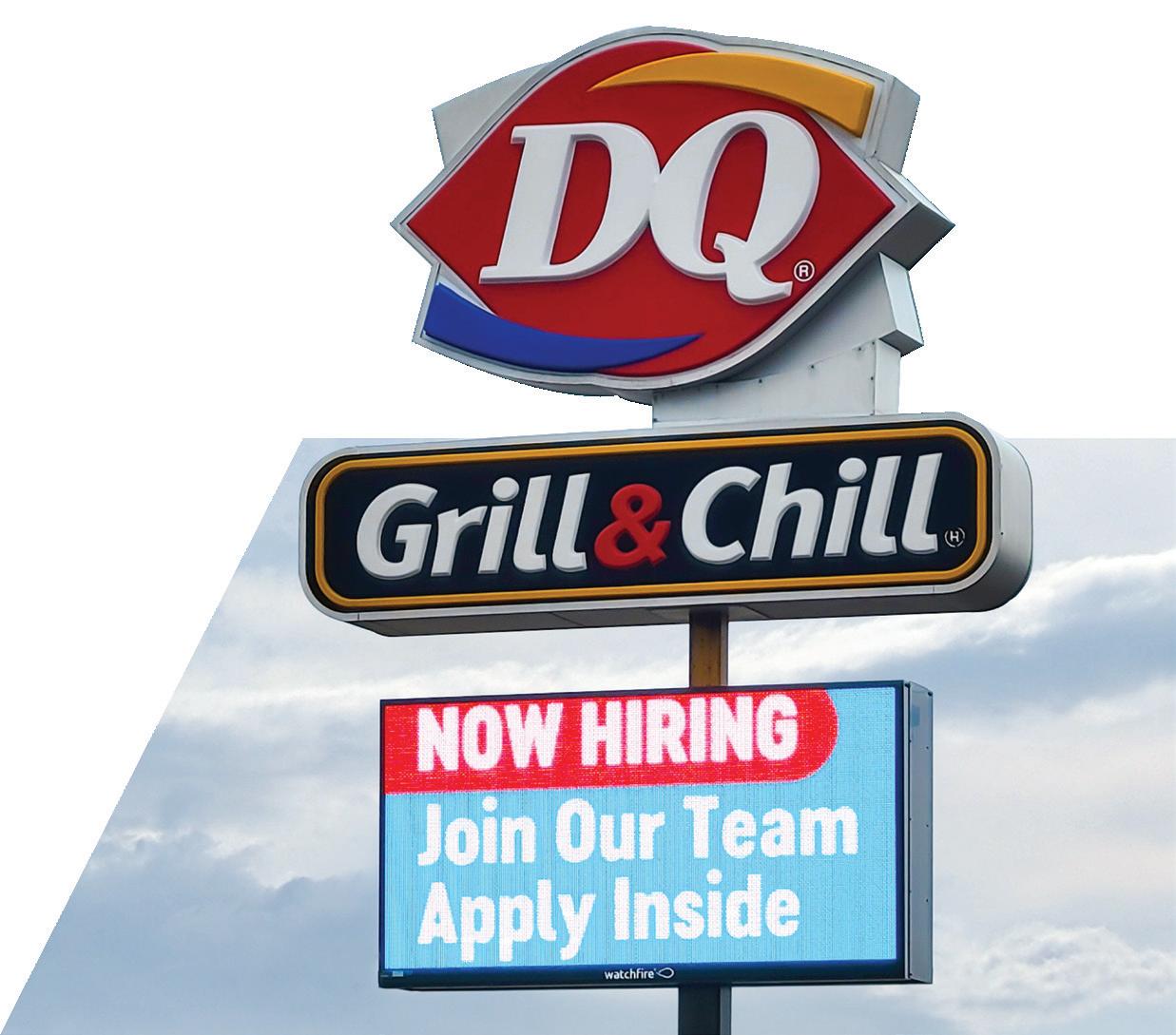


/ BY SAM DANLEY
Fast-food brands are accelerating their use of automated order takers. What’s next for this cutting-edge innovation?


There’s been an explosion of ideas on how advanced artificial intelligence can improve restaurant operations in recent years. One area that’s generated its fair share of attention is voice AI in the drive-thru, which uses machine learning to process, interpret, and respond to spoken language.
Many quick-service brands started experimenting with the technology after the pandemic. Now, many of them are scaling their systems beyond pilot programs and into widespread deployment.
Bojangles is one of those chains accelerating its investment in voice AI at the drive-thru. Following a successful pilot with tech provider Hi Auto, the company this summer inked a deal to bring the technology to hundreds of stores across the country. Its AI ordering assistant already is in over 200 locations, with new ones being added almost daily.


The system, called Bo-Linda, uses natural language processing and voice recognition to manage orders. It also gathers information from employees, like wait times or out-of-stock alerts, and relays relevant updates to customers.
“I think a lot of people went into this the same way that we did, thinking about it in terms of a cost offset device or as a way to deal with a shrinking labor force,” says chief information officer Richard Del Valle. “It absolutely fulfills on those fronts, but what we’ve discovered throughout this whole journey is that there are other benefits that are even more important to us.”
As an example, he points to Bo-Linda’s ability to reduce guest anxiety and confusion by confirming that customers are promptly greeted, eliminating concerns about whether their arrival has been noticed or when they should begin placing their order.
“Think about everything you want to accomplish with the order-taking step,” Del Valle says. “You have to engage the guests in a meaningful way. You have to be able to answer any questions they might have. And you have to make sure they get exactly what they want.”
Factor in fast food’s notoriously high turnover, and that leaves most restaurants in constant training mode to certify those boxes are always checked.
“There’s also an art to talking to guests with real warmth, to upselling and encouraging them to take advantage of offers and promotions,” Del Valle says. “Getting that every time from the workforce is a real chal-
lenge. This takes all of that out of the mix.”
Several factors can lead to poor customer satisfaction in the drive-thru, whether it’s inaccurate orders, long wait times, or a lack of hospitality at the window. Taco Bell has seen first-hand just how effective voice AI can be at avoiding the stressors that lead to those problems in the first place.
The brand started piloting automated ordering in 2021 with a handful of locations in its home state of California. The technology is now supported by digital menu boards as well as parent company Yum! Brand’s proprietary POS system. Soon, it will be integrated with the chain’s loyalty program, too.
The brand’s voice AI system currently is up and running at over 100 stores, including several units owned by Diversified Restaurant Group, one of Taco Bell’s largest franchise partners.
“When I go in, I try to confuse the AI and order stuff that no one else would think of—putting chicken on a breakfast item or adding with pickles,” says Todd Kelly, COO of Diversified Restaurant Group. “They get a little bit confused with the voice AI, but they’re always friendly.”
“... but what we’ve discovered throughout this whole journey is that there are other benefits that are even more important to us.”
-Richard DelValle CHIEF INFORMATION OFFICER BOJANGLES
The biggest benefit has been assuring stores deliver the same top-notch experience every time a customer cruises through the channel, he adds.
“The voice AI doesn’t have a bad day,” Kelly says. “They’re not in a bad mood when they come to work. They don’t get hungry. They don’t need a cigarette break or whatever. They keep plugging away. So, it’s nice from that standpoint. And they never miss trying to round up to our donations, a big part of who we are in the communities that we serve. They never forget to offer


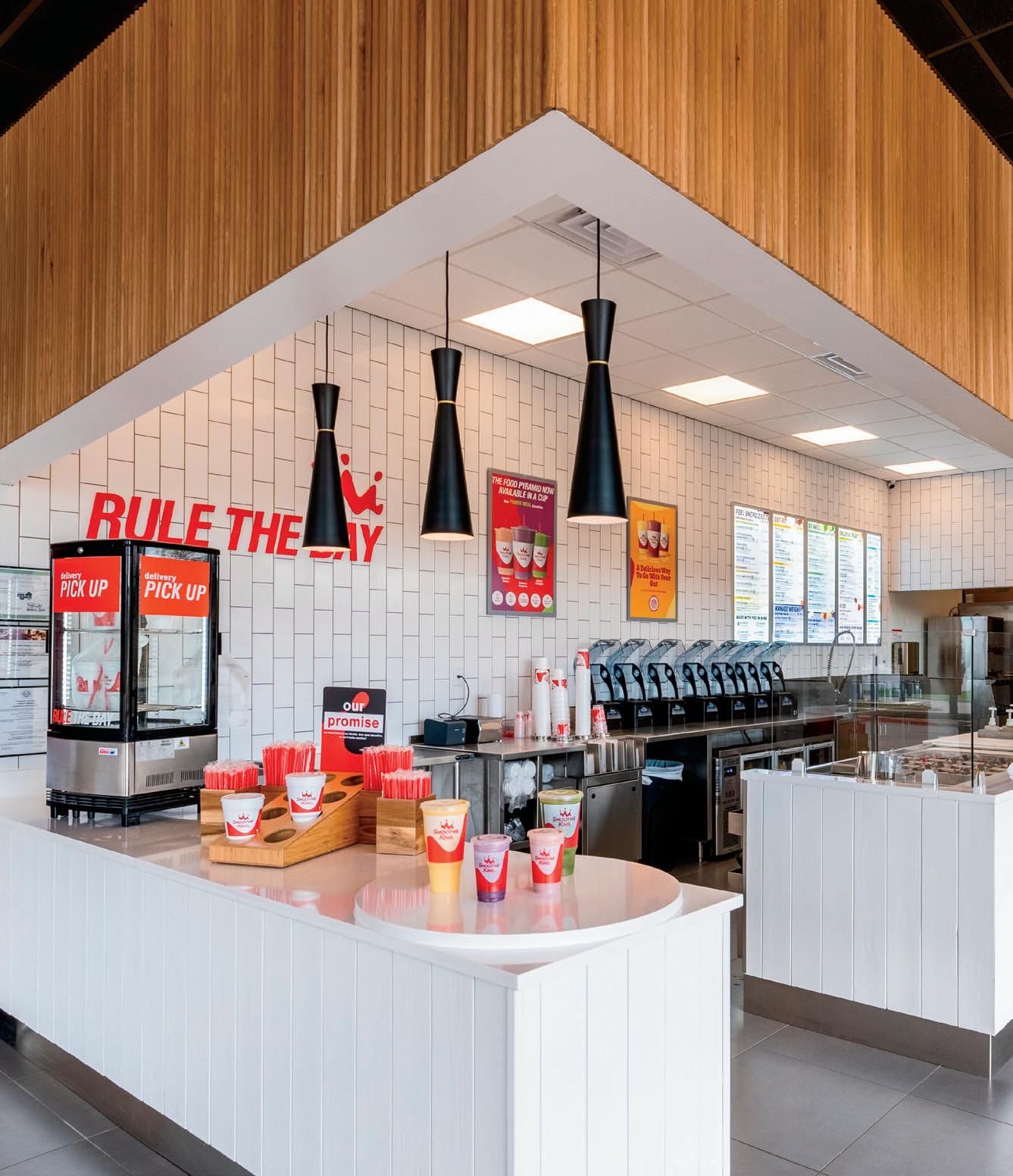





















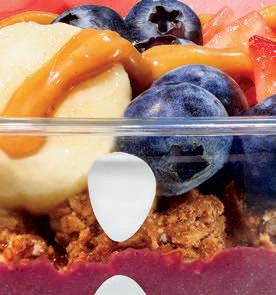





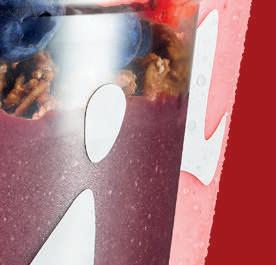




a drink to our customer. There are some bumps, but we’re actually expanding our test in all of our markets. Within the next couple of months, we’re going to have voice AI in about 30 of our restaurants.”
Taco Bell indicated this summer that it plans to expand the technology to hundreds of more locations over the same period. In a statement announcing the accelerated rollout, Yum! Brands’ chief innovation officer Lawrence Kim said he’s confident in the tool’s ability to deliver meaningful benefits around customer satisfaction and improved operations, citing over two years of fine-tuning and testing out on the West Coast.
AI to formulate dynamic responses and adapt in real time.
Since December 2023, Wendy’s FreshAI has expanded from four company-operated restaurants in the chain’s home state of Ohio to 28 restaurants across two states, with further expansion on the horizon. Results have so far been promising. An early pilot in Columbus, Ohio, showed a 22-second improvement in service times compared to the average for that market.
In August, the company introduced Spanish language capabilities to further enhance customer engagement as it continues scaling the technology across its footprint.
Wendy’s is also making strides with its drive-thru AI initiative, dubbed Wendy’s FreshAI, which launched last year through an expanded partnership with Google Cloud. It created the platform to overcome the challenges of traditional automated systems, which often struggle with complex customer interactions, uncommon phrasing, and complicated requests.
Unlike those older rulebased systems, Wendy’s says its technology uses generative
“ I’m energized by our partnership with Google Cloud to continue pushing this technology forward.”
-Matt Spessard CHIEF INFORMATION OFFICER WENDY’S
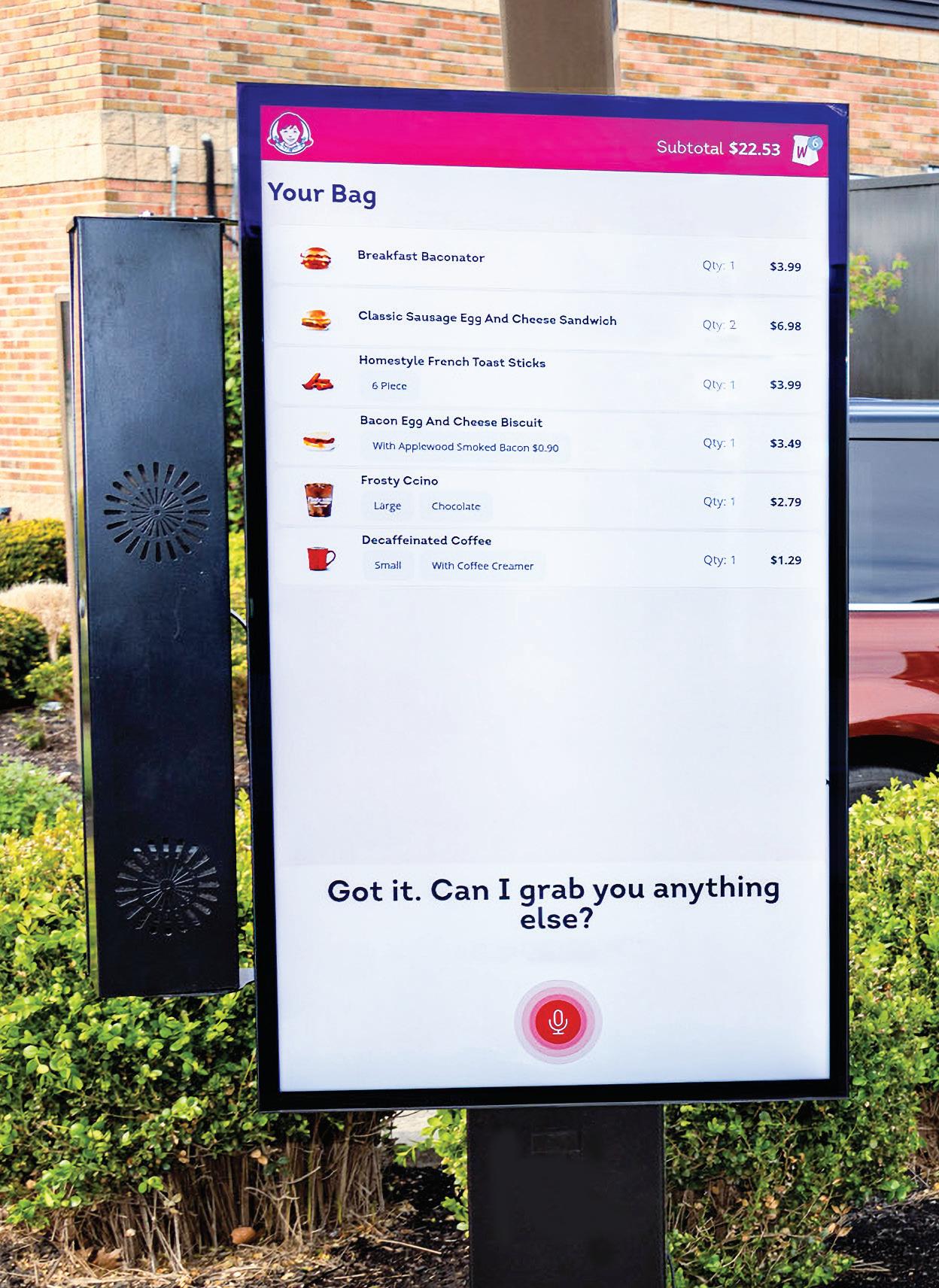
“I’m energized by our partnership with Google Cloud to continue pushing this technology forward,” says chief information officer Matt Spessard, adding that Wendy’s will continue exploring new ways to expand access and reshape the drivethru experience going forward.
Beyond improving service speed and accessibility, Wendy’s is placing equal importance on how the system impacts team members. The company’s technology and operations team have clocked thousands of hours working from dining rooms and engaging with crew members to ensure the system improves the experience for store-level workers as well as the guests they’re serving.
For Bojangles, the positive response from team members working alongside Bo-Linda is another key advantage. Del Valle says it far outweighs the cost-savings that could come from using the tool to operate drive-thrus with less staff.
“You’re taking roughly 35 percent of the workload away from one or two employees by removing the order taking, which then frees them up to be better at speed, better at accuracy, and better at cheerfulness at the window when they engage with guests to take the payment,” he says. “We’re finding that our employees are very happy with that, to the point where if you walked into one of our Bo-Linda restaurants and announced to the crew that you’re taking it out tomorrow, they’d be very upset. They’ve grown to like it and count on it. It’s fun to see just how quickly this technology becomes part of the team.”
White Castle also is pushing back on the widespread notion that voice AI in the drive-thru is meant to replace human jobs. In fact, the idea that it could free up staff members to focus on engaging with customers is what first sparked the company’s interest in the technology four years ago.
“It hasn’t affected our employment levels one bit,” says Jamie Richardson, White Castle’s VP of marketing and public relations. “If anything, it’s given us more capability to invest in our people. It’s not about the pathway to greater productivity. It’s not about cutting hours. It’s about giving our people better tools, so they’re able to take better care of customers, and then all things being equal, you’ll get more return visits sooner, and that math just keeps playing out over time.”
The sliders chain initially tested the technology in 2020 through a partnership with Mastercard, with SoundHound providing the voice recognition tool and another company offering vehicle recognition software. Now, it is working directly with SoundHound on an AI assistant it calls Julia, named after a beloved White Castle hostess from the 1930s.
The company has been steadily expanding Julia into more









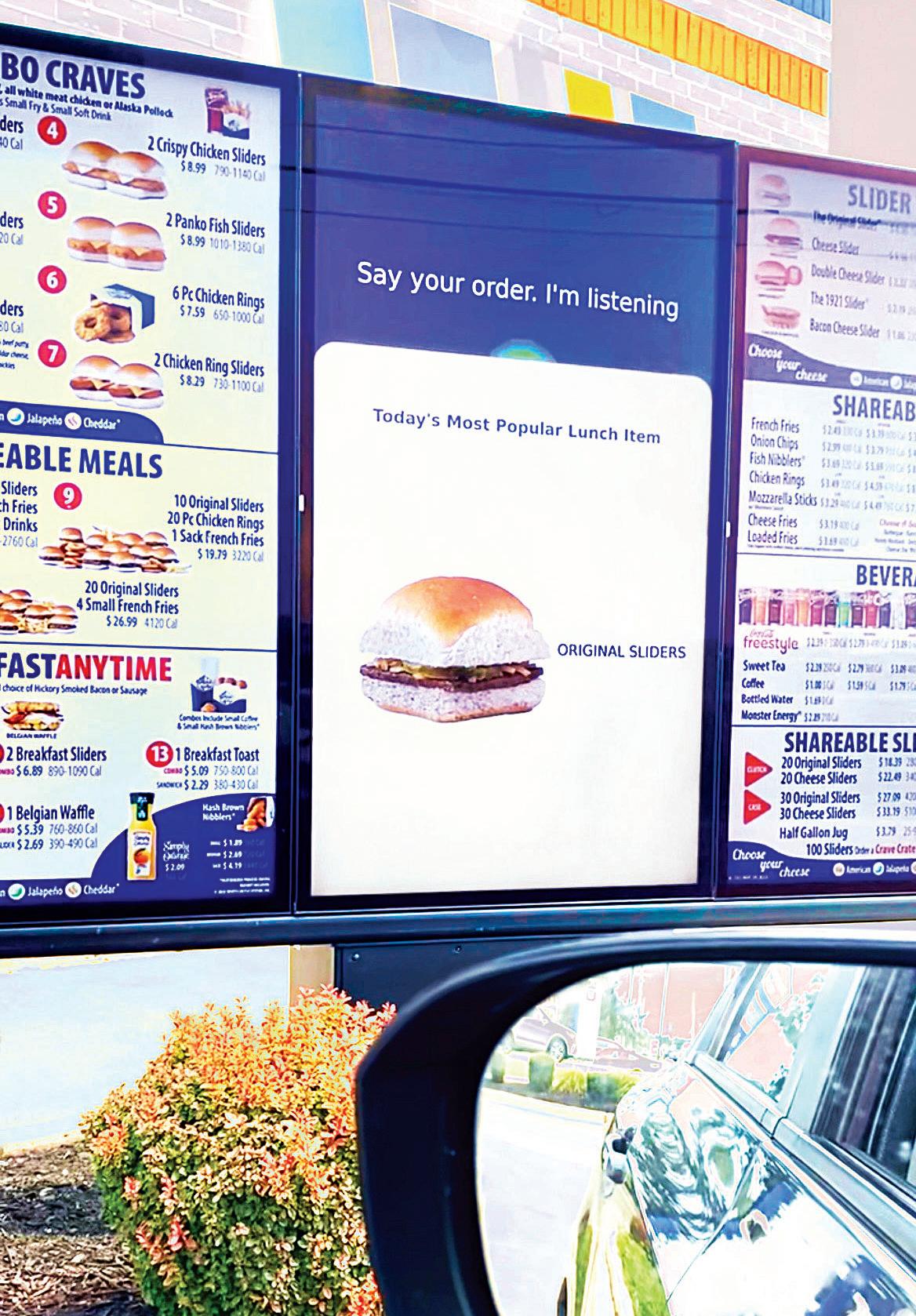
“... It’s about giving our people better tools, so they’re able to take better care of customers, ... you’ll get more return visits sooner, and that math just keeps playing out over time.”
-Jamie Richardson VP OF MARKETING AND PUBLIC RELATIONS / WHITE CASTLE
stores and plans to have it installed in 100 locations by the end of the year. Richardson says there have been plenty of learning moments along the way, especially when it comes to ensuring the system recognizes the vast amount of words and expressions people can use to communicate one simple message.
“We had no idea how many different ways customers can choose to order the same thing, like ‘give me some of this,’ or ‘I’ll take that,’ or ‘how about this?’” he says.
The potential variations multiply exponentially when you start dealing with customizations, clarifications, and revisions.
Richardson says dialing into those nuances was daunting at first. It was a bigger challenge than the company initially anticipated. But it also ended up being a key proof point for continuing to invest in the tool.
“It was amazing to see how quickly Julia could adapt and take on all of these new learnings,” he says. “Once we were able to recalibrate and say, ‘alright, it’s going to take a minute longer than we thought to get all the different nuances down’ it was just so outstanding to us, because Julia only gets faster and faster at learning.”
Not all fast-food chains have found success with AI in the drive-thru. Notably, McDonald’s this summer decided to end its trial of IBM’s Automated Order Taker due to difficulties with interpreting accents and dialects, which compromised order accuracy. At the time, the company said it would explore other vendors with the goal of reaching a decision on a future voiceordering solution by the end of 2024.
The fast-food giant reportedly couldn’t get its non-interaction success rate—the percentage of how many orders are handled by AI without any restaurant team member intervention—out of the low 80s.
“If I were in the low 80s, I’d shut it off too,” Del Valle says. “It’s counterproductive to have your team constantly stepping in.”
Bojangles is achieving around a 97 percent non-interaction success rate, a figure he attributes to extensive work conducted during the setup phase.
“The trick is that whatever comes out of a guest’s mouth, the system has to be able to fulfill,” he says. “I think that’s where a lot of people trip up and where you tend to see the most failure.”
Another challenge is determining the optimal time an AI voice system should pause before prompting customers. Restaurants need to ensure it’s long enough to be polite and accommodating but not so long that it slows down the service and frustrates guests.
Richardson says it also needs to strike the right balance between speed and efficiency while maintaining a touch of personality.
“We’ve got a little bit of that right now with different phrases that are less generic and recognize you’re at a White Castle,” he says. “One of the other big things we found early on was that the speed of Julia’s voice was too slow. We needed to speed it up to be a bit more conversational and make it sound less like a machine. It was really interesting to see how much better that made it. It’s the little things like that that end up making a big difference.”
Looking ahead, he views voice AI as more than just a flashin-the-pan trend. He sees it as a significant development with the potential to transform how the quick-service industry handles its leading sales channel.
“There was a time when there was no such thing as selfservice at the gas station or self-checkout at the grocery store,” Richardson says. “Then technology improved and provided more options. The same thing is happening here for restaurants. If we’re all doing our jobs in our industry, we’re going to ask good questions, listen intently to what our customers tell us, and then be responsive to those needs. It really feels like we’re on the right track in this instance, so I think it’s going to become the norm rather than the exception.”
Sam Danley is the associate editor of QSR. He can be reached at sdanley@wthwmedia.com

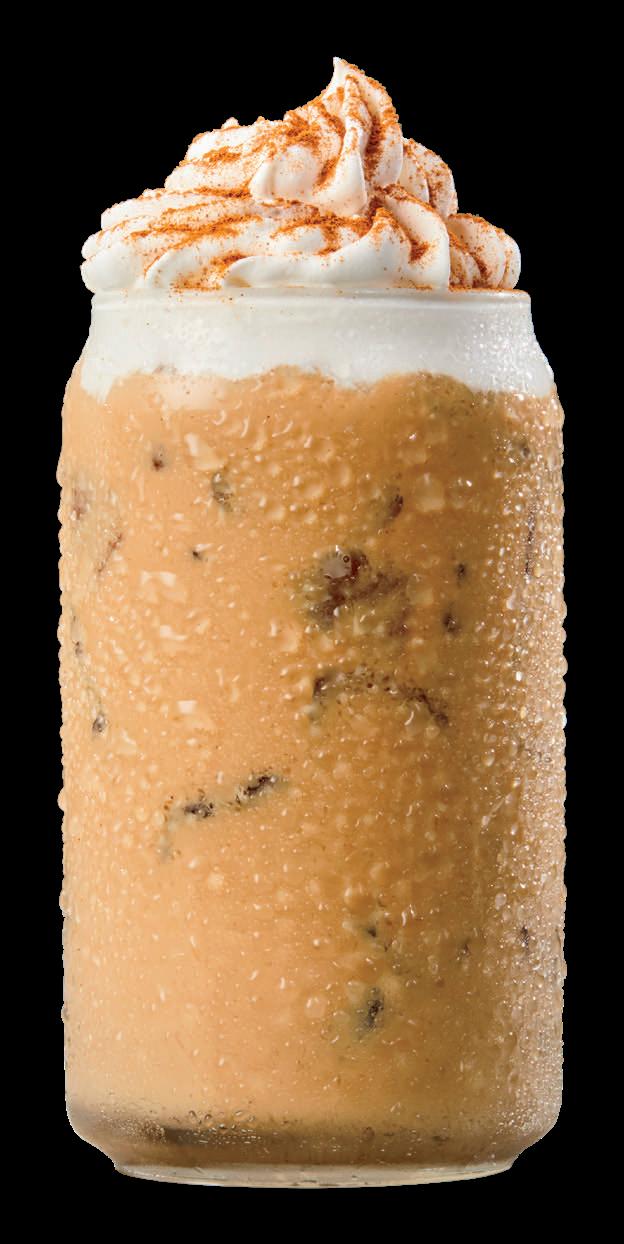
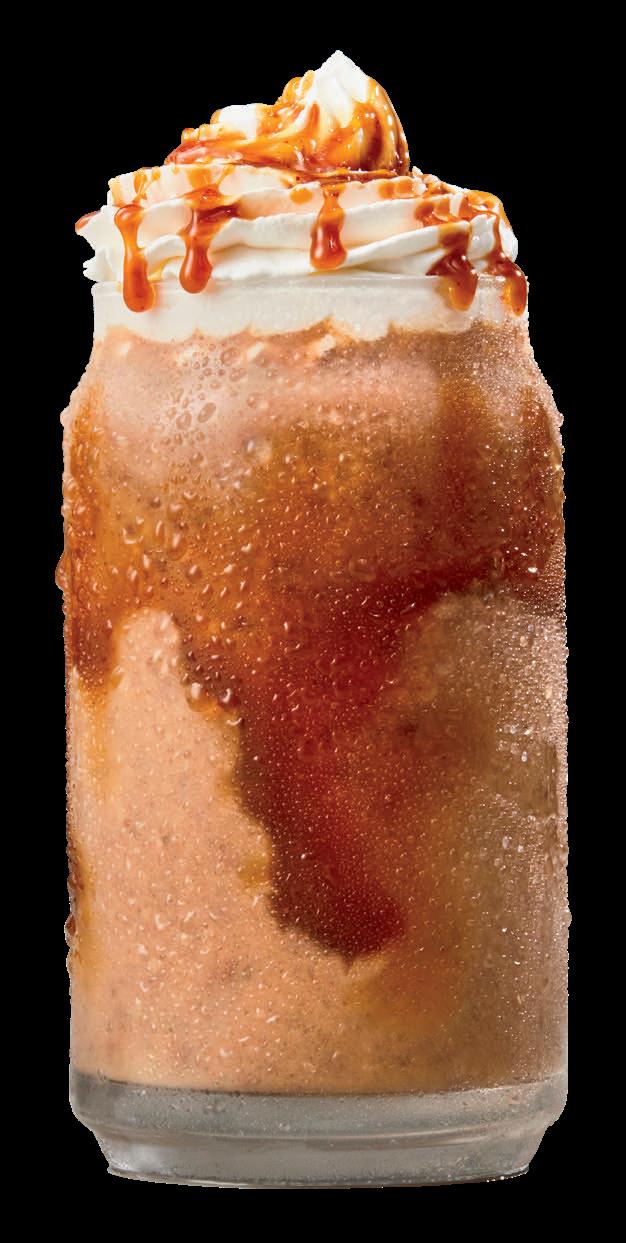
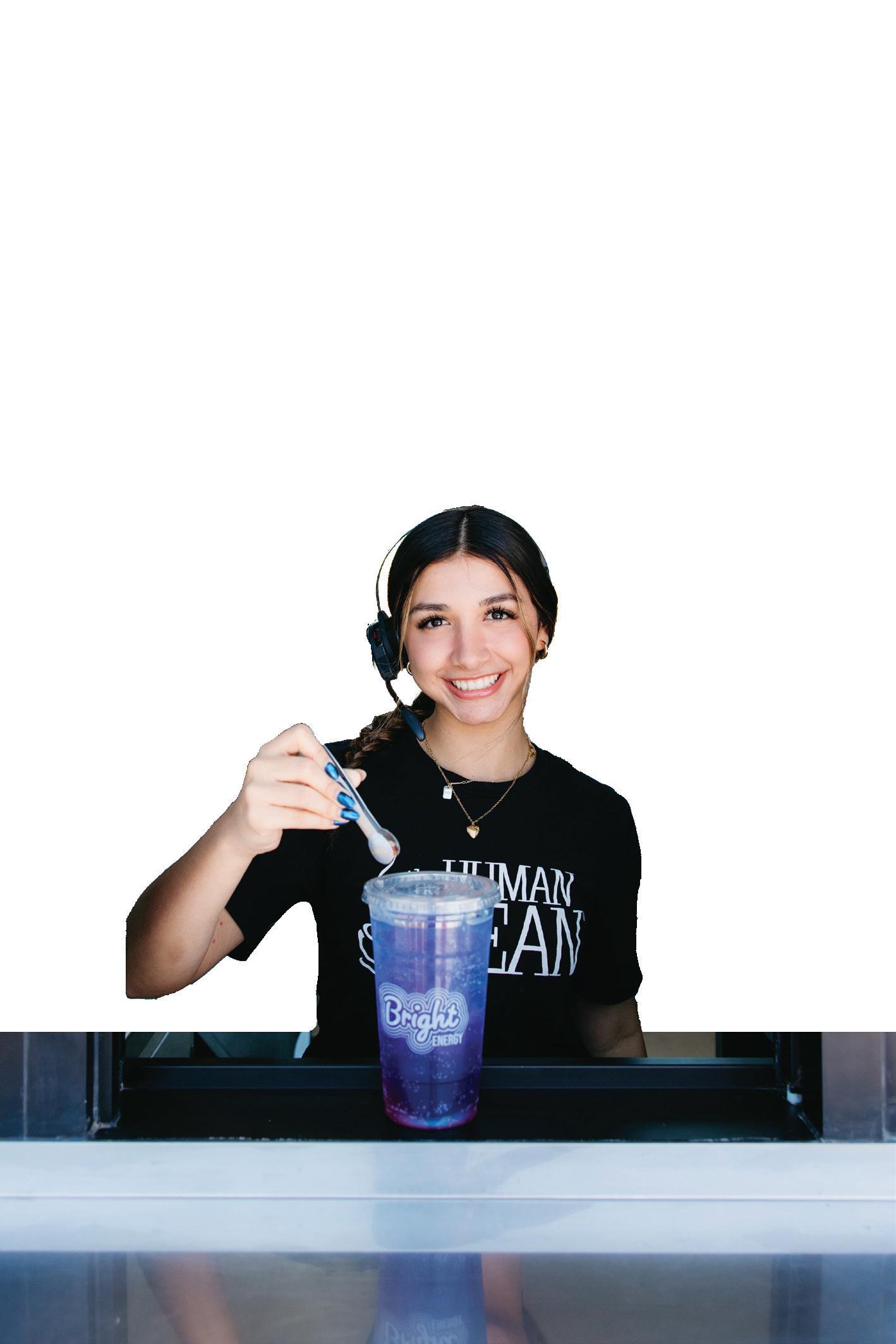
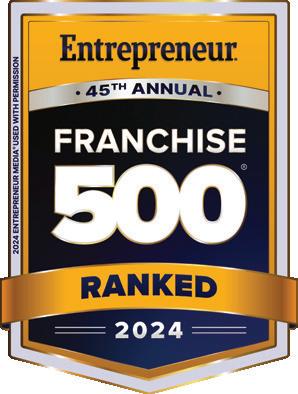

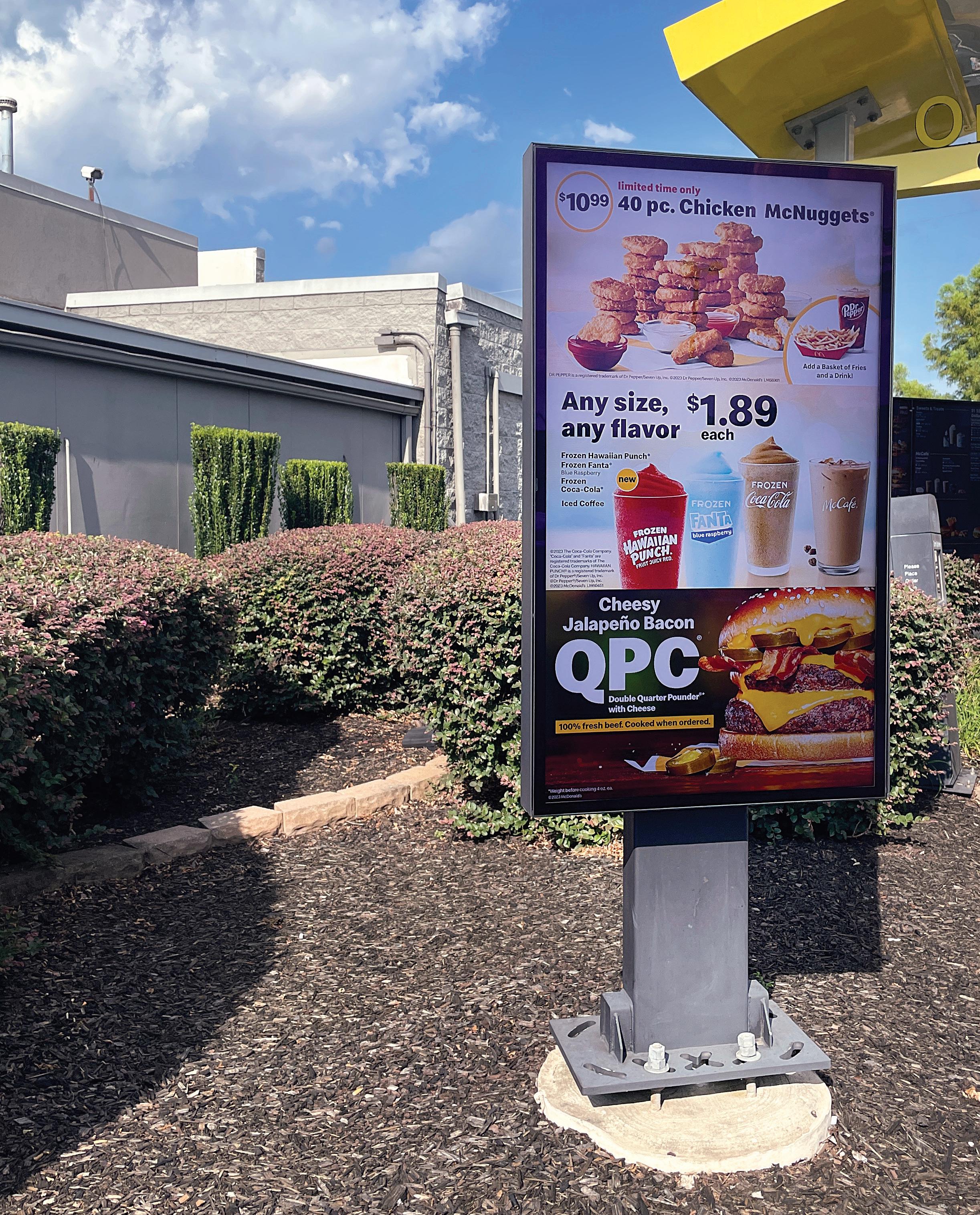
Operators believe digital menu boards are transforming the quick- service drive -thru with real-time updates, enhanced visual appeal, and improved operational efficiency.
/ BY BEN COLEY
The fast-food drive-thru has been a staple of American culture since the mid-20th century. However, some concepts have found static menu boards to be limiting in an era of rapid technological advancement and changing consumer expectations.
Across the country, quick-service chains have begun using digital menu boards—a dynamic, flexible, and efficient solution that appears to be revolutionizing the experience for customers and employees.
Wendy’s announced earlier in 2024 that it set aside $20 million in capital to complete a rollout of digital menu boards at company-run stores across this year and 2025. As of August 1, 30 to 35 corporate stores had the technology. The brand planned to ramp up its rollout in the second half of 2024.
“We like what we see. It’s a good experience for our consumer,” CFO Gunther Plosch told investors during the brand’s Q2 earnings call. “It’s a good experience for our crew members since you obviously don’t have to go out anymore and change our menu boards between the rest of day and the breakfast menu. So yes, committed to the investment.”
One of the most significant advantages is the technology’s ability to provide real-time updates. Burgerville CEO Ed
Casey says digital menu boards allow for immediate changes in the menu, particularly when a product becomes unavailable mid-campaign. Nine of the brand’s roughly 40 locations in the Pacific Northwest have digital menu boards.
“You don’t have to worry about putting big ‘not available’ signs on your menu board,” Casey says. “You can just go in and make that change right away. It gives us a lot of flexibility.”
This ability to update menus in real time helps manage inventory and enables restaurants to adapt quickly to changing market conditions. For example, during promotional periods or in response to seasonal demand, digital menu boards can highlight specific items or deals, driving customer interest and boosting sales. The dynamic nature of these boards allows for strategic placement of high-margin items, which can lead to increased profitability.
For Burgerville, the integration of digital menu boards has been a game-changer. Casey says the brand plans to convert all of its drive-thru restaurants to digital menu boards eventually.
Additionally, digital menu boards significantly boost the visual appeal of menu items. Todd Kelly, COO of Diversified Restaurant Group, a franchisee of more than 300 Taco Bell restaurants, emphasizes the importance of clear, vibrant images

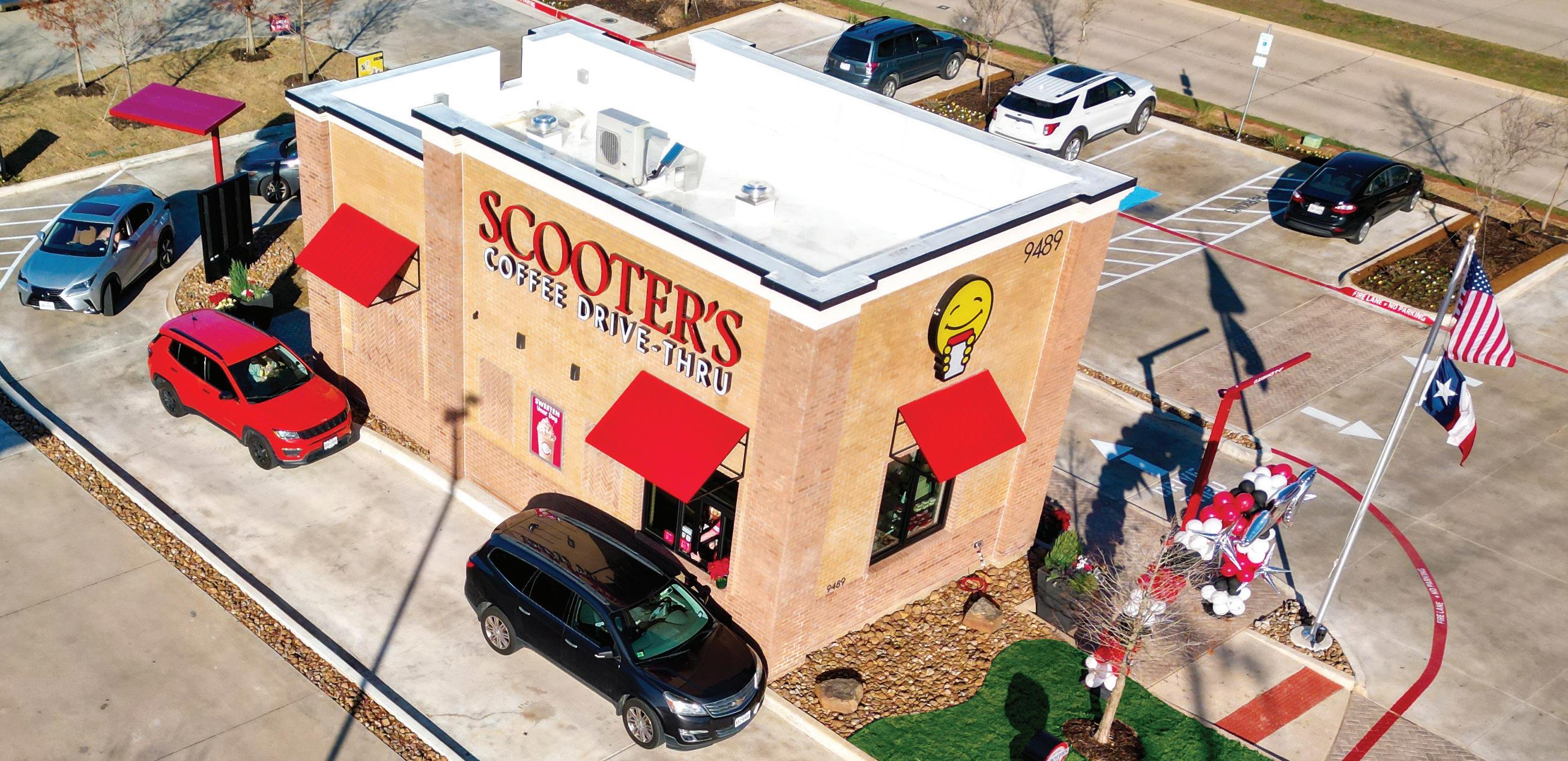













Are you a seasoned franchise owner looking for your next big opportunity? Discover how Scooter’s Coffee® can complement and enhance your portfolio. Our industry-leading brand offers a strong opportunity for multi-unit franchise owners.
Here’s why Scooter’s Coffee stands out:
Nationwide presence: Our coffee franchise is on the cusp of incredible expansion with over 800 locations across the country and plenty of territory still available.
Comprehensive support:
Our franchise partners bene t from extensive training, marketing, and operational support.
Multi-unit friendly:
Whether you’re already in the QSR industry or looking to join, our brand is ideal for owners ready to diversify their investments with multiple brands and locations.
Core values:
Integrity, love, humility, and courage are the pillars guiding Scooter’s Coffee. These core values have shaped our brand’s journey, ensuring we stay true to our mission as we grow.
Award-winning brand: We’ve been recognized for excellence through various accolades, including Entrepreneur magazine’s Franchise 500, Franchise Times’ Fast & Serious, and USA Today’s Best Coffee Chain.
Community focused:
We do more than just serve specialty coffee; we serve smiles. Our brand values high-quality products, community connection, and customer loyalty.
Flexible models:
We have options for both traditional kiosks and new endcap locations to t any market. Our locations thrive in rural, suburban, and metro areas.
Strong reputation:
Our franchise network is home to many successful multi-unit owners.

in driving customer interest and confidence.
“People want to see new things; they want to see a digital image of a product that can change,” Kelly explains. “It helps from an accuracy standpoint for the consumer. They have more confidence that you’re going to get it right when they see their order actually showing up on the screen.”
The improved visual clarity provided by digital menu boards also contributes to a better overall customer experience.
Kelly notes, “The message is a lot clearer out there ... The prices are much clearer so it’s much more readable and easier to
“I really like being able to have photos on our boards. Obviously, digital photos are a lot nicer, and then we can swap them out.”

fast casual, founded in 2006, opened its first drive-thru restaurant in December and equipped it with a digital menu board.
Founder and CEO Debbie Roxarzade explains, “I really like being able to have photos on our boards. Obviously, digital photos are a lot nicer, and then we can swap them out.”
She adds that the decision to install digital menu boards at the brand’s first drive-thru location was driven by a desire to stay current with technology and improve operations. The digital menu board has been crucial in simplifying real-time updates and the inclusion of an order.
“The feedback has been great,” Roxarzade says. “We do have team members that have worked at other places in the past, but haven’t had this and they definitely think that it’s easier for the guests as there could possibly be more information or if there’s a change that we need to make it’s more immediate that we can do it versus some of the other locations that they’ve probably been at or a different business they’ve been at, it’s a couple of days or a few days or a month or whatever, however long it takes to make those changes for them. So that’s been positive.”

read for the consumer. It also has a digital readout of what you order and a picture of what you order and how you’re modifying it. So it helps from an accuracy standpoint for the consumer. They have more confidence that you’re going to get it right.”
Similarly, Rachel’s Kitchen has seen positive feedback from guests regarding the digital menu boards. The Las Vegas–based
Roxarzade had a detailed approach to selecting a digital menu board vendor. She attended a trade show in Chicago where she had an opportunity to see multiple vendors, talk to them directly, and evaluate their technology. She focused on how quickly each vendor could implement changes and assessed their working platforms.
A key factor was ensuring the system integrated seamlessly with Rachel’s Kitchen’s existing pointof-sale system, Revel. Otherwise, it would’ve added unnecessary complexity.
“Once I went through and looked at all the options that were out there and then compared, ‘OK, here are my top four and of that top four, three of them integrate with Revel,’” Roxarzade says. “And I started meeting with each individual and dived down a little bit deeper to see which one would be right for us.”
Michael Parlapiano, managing director at The Culinary Edge, is currently working with City Barbeque to do menu design and strategy for its drive-thrus, which have digital menu boards. He says the innovation helps optimize the consumer journey by making it easier to navigate complex menus.
“Digital menu boards allow us to be so much more dynamic with the way we think about testing different menu architectures and consumer journeys,” Parlapiano says. “They enhance

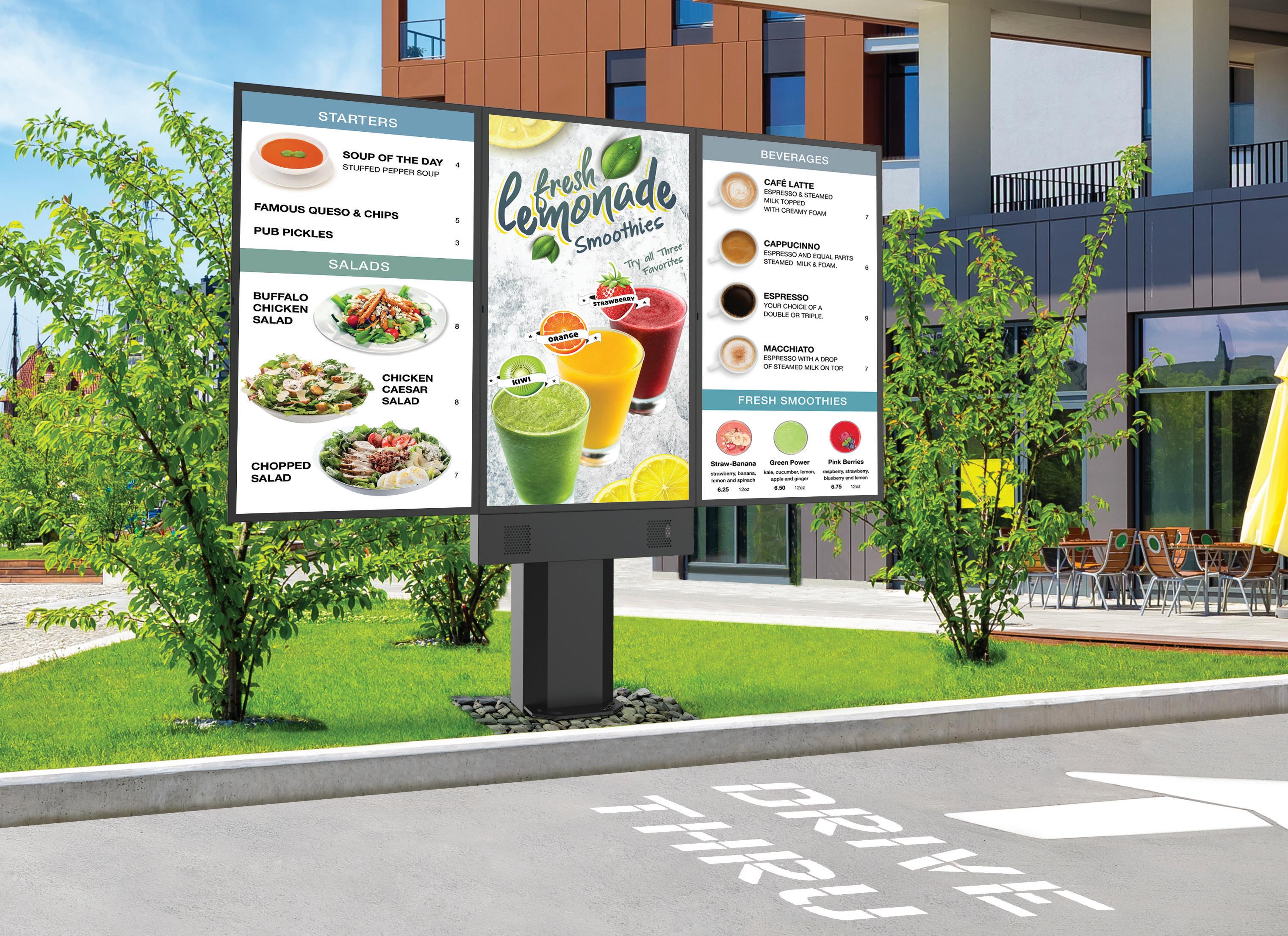



“They have shared excitement about seeing creative elements like flames and craveable food photography delivered in a bolder format.”
order accuracy and reduce order-related issues.”
He’s seen the technology evolve over the past few years. Initially, the technology faced significant challenges such as low resolution, poor visibility, and subpar design. These limitations hindered the ability to effectively display food items and create an appealing menu layout. However, advancements in technology have dramatically improved the quality of digital menu boards, making them as visually appealing as static boards.
Parlapiano says that as the technology progressed, adoption rates increased. Despite these advancements, there are still pitfalls to avoid. One of the main challenges is balancing the dynamic features of digital boards without overwhelming customers.
“You can get a little bit excited about using the dynamic aspect of a digital menu board to constantly be animating, cycling through showcasing different things,” he explains.
The key, Parlapiano suggests, is finding a middle ground. Incorporating some animation and dynamic movement can enhance the customer experience without turning the menu into a constantly changing interactive screen.
“There’s a middle ground to having a bit of animation, having a bit of dynamic movement of imagery, and also cycling
through an offering without going all the way to where it almost starts to look like a video game and it’s hard for the customer to actually pick out those items that they are looking for and put together an order,” he advises.
A potential opportunity with digital menu boards is the ability to use dynamic pricing, in which restaurants could seamlessly lower or raise listed menu prices based on the time of day. Earlier this year, Wendy’s said during its Q4 earnings call that it planned to test this. Following that announcement, the burger giant was met with a wave of criticism after consumers and media confused it with surge pricing during peak hours. Instead, the purpose was to lower prices during shoulder periods to boost traffic.
Parlapiano says dynamic pricing hasn’t been much of a topic with The Culinary Edge’s clients. He believes the strategy seems interesting and smart for stimulating visits, but he also thinks the approach would have a difficult time gaining consumer acceptance. Parlapiano notes some guests might feel frustrated if they can’t access lower prices during peak times when their demand is highest.
“Dynamic pricing is not a new concept; we’ve seen it with technologies like Uber. But applying it to food is different. There’s an adoption curve and a hurdle for consumers to get over, especially when prices fluctuate based on the time of day,” he says.
Although The Culinary Edge has not actively engaged in dynamic pricing strategies, Parlapiano finds the concept fascinating and believes it warrants further investigation. He’s curious about the future integration of AI with digital menu boards, like facial recognition and loyalty programs.
“AI could present custom-tailored menus to customers based on their previous orders and preferences, potentially showcasing
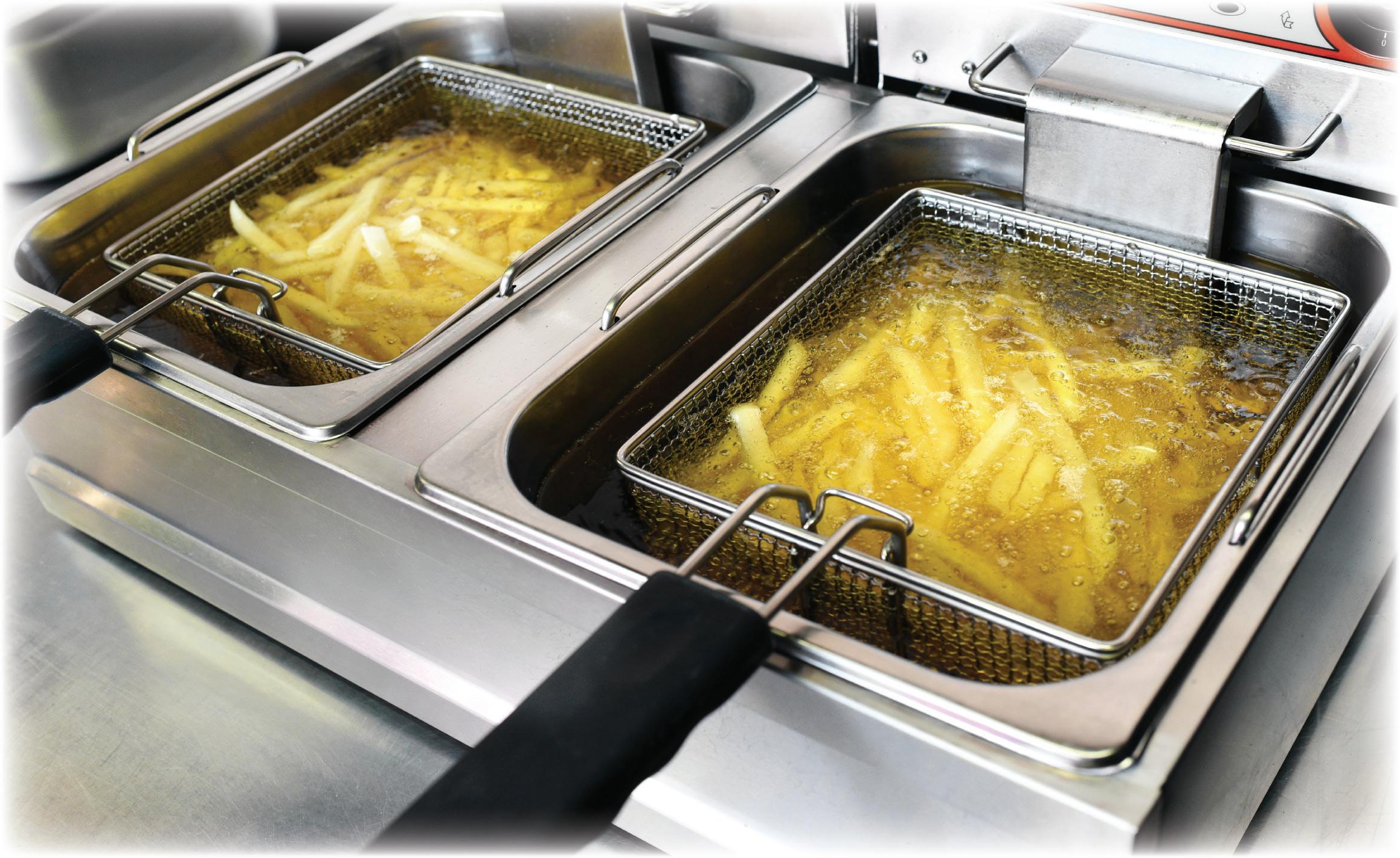

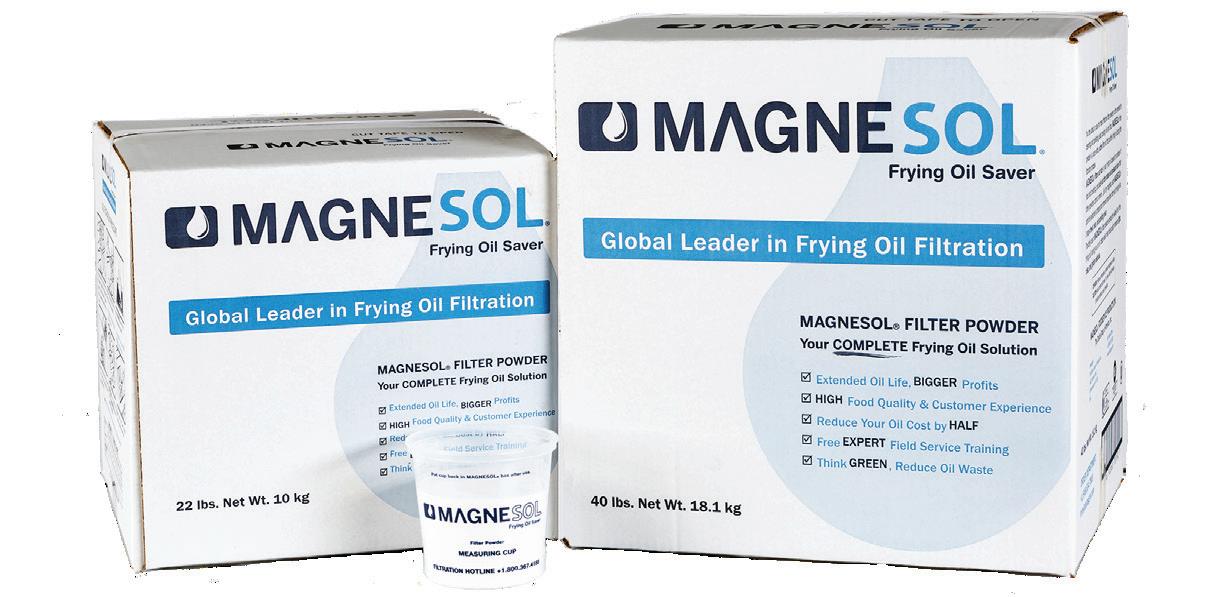
items they haven’t seen before or offering bespoke deals,” he says.
Blake Devillier, president of Carl’s Jr. USA, says the interactive nature of these displays empowers guests to verify their selections, minimizing the possibility of errors and reducing order-related issues. This makes communications in the drive-thru easier for team members while improving overall guest satisfaction.
Anthony Nguyen, vice president of brand marketing at Carl’s Jr., adds that digital menu boards offer greater flexibility in menu design and management.
“By enabling real-time updates, it is easier to introduce new items or highlight promotions,” Ngyuen says. “This agility allows us to more rapidly adapt to guest preferences, promotional opportunities, and the fast-paced competitive landscape.”
Kara Gasbarro, vice president of creative strategy at CKE Restaurants—parent of Carl’s Jr. and Hardee’s—says digital menu boards have played an important part in a recent menu transformation, which focused on customizable flavors. The simplified order decisions for guests increased customer engagement and effectively highlighted new products without interrupting or cluttering the ordering experience.
The introduction of dynamic content on the digital boards has also been well-received by team members.
“They like to see the brand come to life in new ways through the menu displays,” she says. “They have shared excitement
about seeing creative elements like flames and craveable food photography delivered in a bolder format.”
From an operational perspective, digital menu boards provide better night-time visuals for guests and make the ordering process easier when it’s dark outside. The boards also feature an operator portal, which allows restaurant teams to preview menus, check accuracy, train staff, and prepare for menu changes efficiently.
However, Gasbarro notes that leveraging the full potential of digital menu boards requires a shift in mindset.
“Digital menus provide new and different opportunities than a traditional menu, so it requires the team to think differently and challenge existing paradigms about menus,” she says.
Although technology is influential, Parlapiano says restaurants shouldn’t forget the significance of hospitality, the bedrock of food service. If everything is working right, digital menu boards and great menu design can better the customer experience. When designed with the team members’ experience in mind, it’s a win-win, he says.
Parlapiano says that while technology is great, it must serve the humans involved to be fully adopted.
“Hospitality is core to what we think about every day at The Culinary Edge,” Parlapiano says.
Ben Coley is the editor of QSR. He can be reached at bcoley@wtwhmedia.com




BY SAM DANLEY
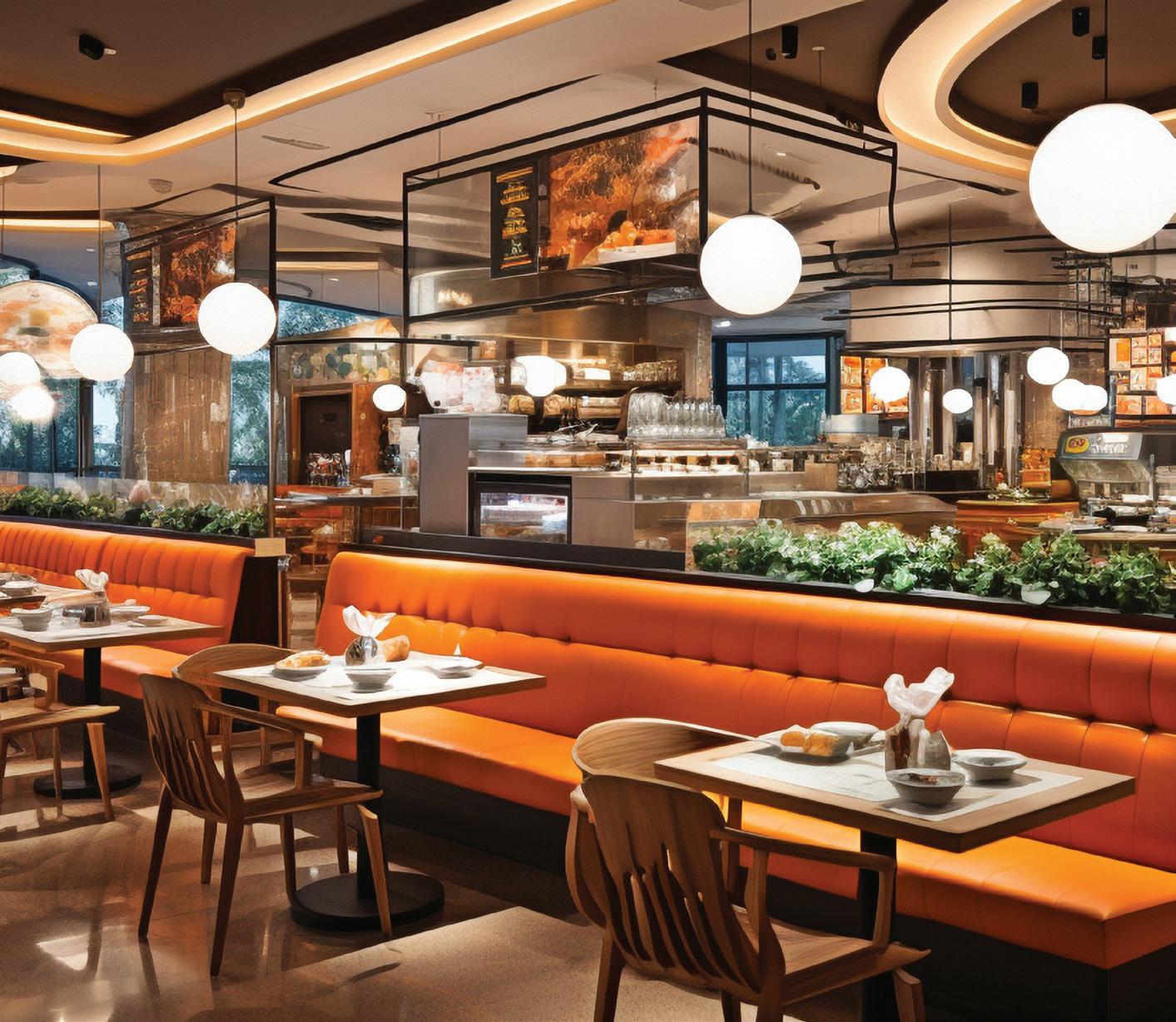
spending,” says William Blair research analyst Sharon Zackfia. “Restaurants aren’t immune from this. There’s definitely a slowdown. We see it in almost every election cycle.”

Restaurants may be in store for a bumpy end to an already challenging year. After spending the past few quarters trying to win back price-sensitive guests who largely cut back on dining out, the election could add another headwind into the mix.
A recent report from William Blair looked at the weighted yearover-year change in monthly retail sales from October through January during presidential elections compared to the trailing 12-month average to determine how political cycles impact consumer demand. The analysis excluded 2008 and 2020 due to the outsized economic effects of the Great Recession and COVID-19.
It found retail sales excluding gas and auto sequentially decelerated by an average of 0.7 percent over five election cycles. The impact was most pronounced during the peak of the holiday selling period in December, with retail sales sequentially decelerating by an average of 1.8 percent. Sales declined by an average of 0.4 percent in October and November before ticking upward in January with an average acceleration of 0.4 percent.
“When you’re feeling less certain about the future, there’s just a natural tendency to tighten your belt a bit and rein in your
The good news is that restaurants are typically more insulated from the consumer spending pressures than other categories. Excluding 2008 and 2020, sales have dipped during every election cycle since 1996—down 2.2 percent in 2000, 1.4 percent in 2004, 0.9 percent in 2012, and 1 percent in 2016. That’s worse than grocery (up 0.7 percent on average) and e-commerce (up 0.9 percent) but better than higher-ticket segments like electronics and appliances (down 3.8 percent) or furniture (down 2.7 percent)
Other factors are at play in the industry’s Q4 forecast. Thanksgiving falls later this year, and a shorter Christmas season could amplify election-related pressures.
“You have to adjust for all of those things,” Zackfia says. “But just looking at the election cycle alone, it’s hard to paint it as a good thing for the fourth quarter.”
Beyond consumer uncertainty amid a tempestuous political cycle, the election will have much wider consequences for the business environment restaurants operate in going forward. The stakes are high since the results will shape the regulatory and legislative landscape for the next few years.
“Politics matter for the restaurant industry,” says Sean Kennedy, executive vice president for public affairs at the National Restaurant Association. “We’re the nation’s second-largest private employer, so labor policies coming out of Washington have an outsized impact on us.”
Comprehensive immigration reform and expanded visa programs, like the Essential Workers for Economic Advancement Act, could boost workforce numbers and alleviate the labor market pressures facing restaurants, he adds.
That’s just one area the Association is focusing on in the lead up to the election. It also is pushing for federal policies that foster restaurant growth and ensure the industry’s interests are well-represented when tax legislation takes center stage in the House and Senate next year.
“Republicans and Democrats alike acknowledge that 2025 is going to be a key year for tax legislation,” Kennedy says. “Both


sides say they want to see comprehensive tax reform, but there are very different priorities on the scope and contours of that. We want to make sure that restaurant priorities are at the forefront of those discussions.”
The Credit Card Competition Act is another issue that’s top of mind this election season. The legislation aims to introduce competition to the credit card processing market, which is currently dominated by just two companies. Kennedy says increased competition could lower processing fees and enhance security. That would be a significant boon for restaurants operating on slim margins. Other important issues include protecting the tip credit and opposing the FTC’s proposed “junk fees” rule.
Kennedy says the Association aims to avoid relying on any single party or individual to achieve those legislative and regulatory goals. That’s why its advocacy work during the election cycle focuses on delivering pro-restaurant messages to candidates across the political spectrum.
“You always have to be talking to everybody—Republican or Democrat, liberal or conservative,” he says. “We need to build bipartisan coalitions, and they need to be able to withstand whatever changes occur in Washington come Election Day. The stakes are high because we’re in a tremendous period of political uncertainty where voters don’t know what they want, and they’re very comfortable flipping control of the House and Senate or White House. Our job is to stay above all of that and push an advocacy

agenda that can be endorsed by Republicans and Democrats alike.”
The Association’s goal is to ensure that restaurant priorities are front and center as lawmakers navigate an increasingly polarized political landscape. Active engagement from the industry is crucial, he explains, because the decisions made in Washington can have far-reaching consequences on operators big and small.
“I don’t think you have to be political to be engaged,” he says. “You just have to drive home the message that restaurant issues are community issues, and if they’re presented well, they can be nonpartisan issues.”
Take credit card swipe fees as an example. They’re often the third-largest cost for restaurants after labor and food, and they’ve doubled over the past decade with no signs of going down.
“We know it’s because we have an entrenched duopoly in place,” Kennedy says. “There is common sense bipartisan legislation in Washington. Do we finally inject competition into that space and bring down those costs for quick-service operators?”
Ultimately, he says, there are numerous ways restaurants can engage in the political process without taking sides.
“It’s just by sharing the facts, the opportunities, and the challenges of the nation’s second-largest employer,” Kennedy says. “It’s saying, ‘Here’s how the government can really help me grow, help me expand, and have even more of a presence in the community.’”



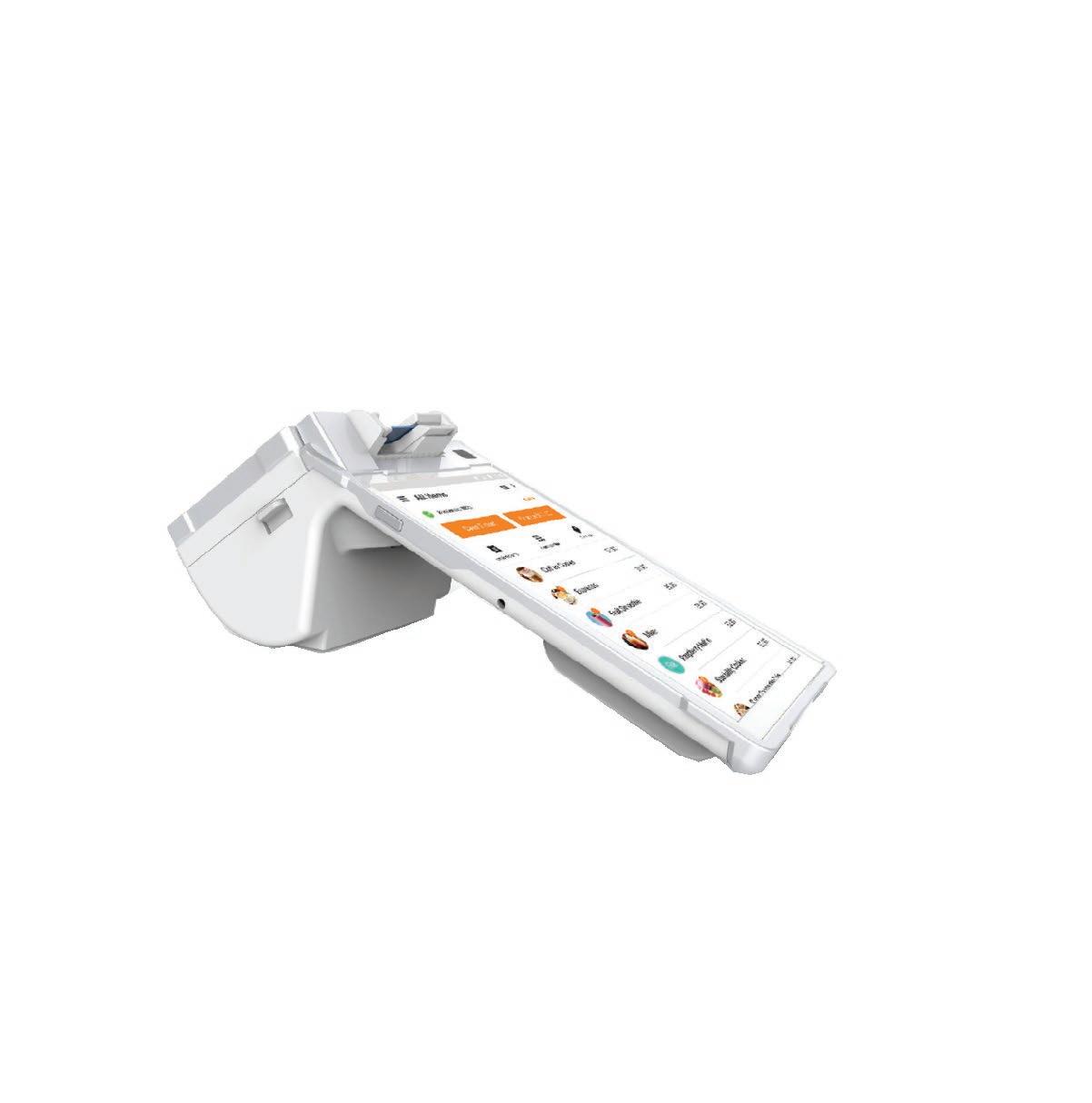


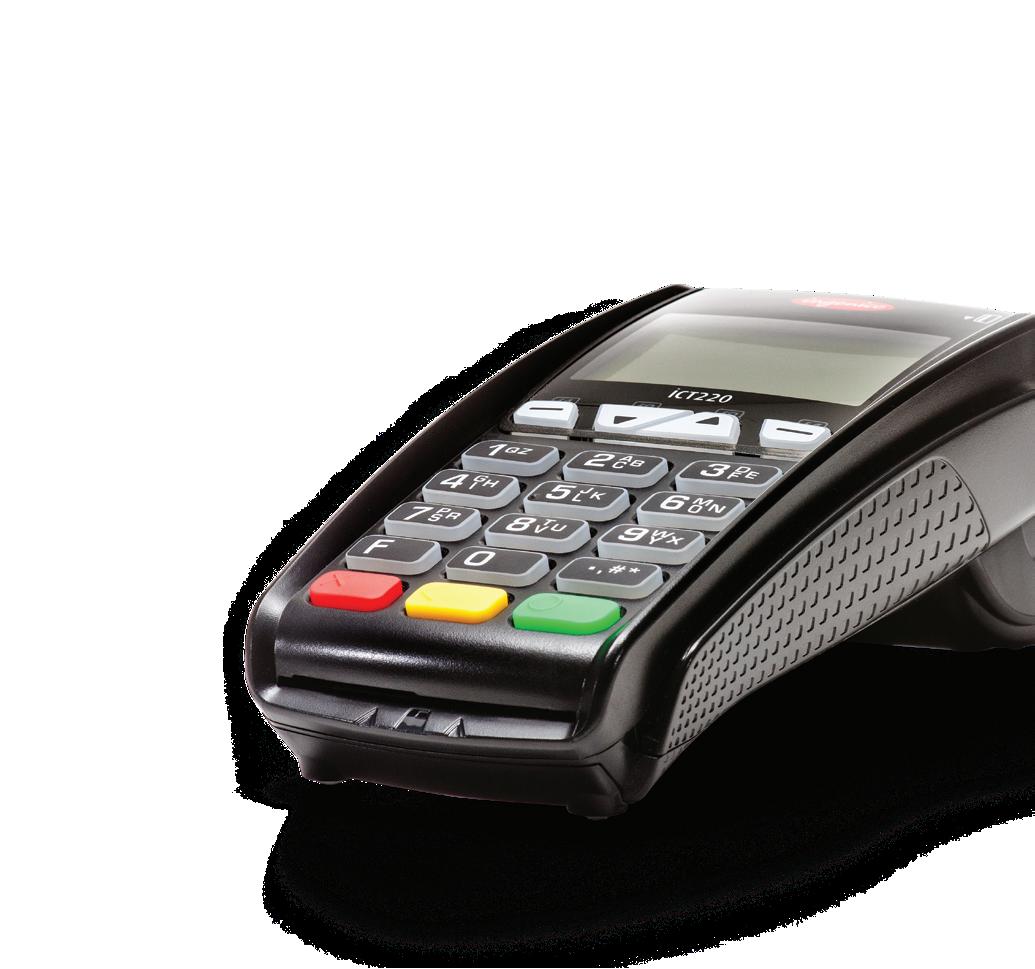

BY TALULLAH HAWLEY

Not many can do trendy culture-fusion Tex-Mex better than Velvet Taco—except, maybe, artificial intelligence? In July 2023, the Dallas-based chain launched ChatGPTaco as one of its WTFs (weekly taco features). It was so successful that Velvet Taco decided to bring it back for a second round, aptly named the ChatGPTaco 2.0.
Being located so close to Mexico, there are a multitude of taco options in the DFW area. Velvet Taco’s ability to be innovative is the key to standing out, says CEO Clay Dover. He says the brand “look[s] for inspiration from all over. Our WTF allows us to try something different all the time and it gives us a license to do anything, whether it’s a Hawaiian ahi tuna taco or a burnt ends barbecue taco. It allows us to try something for a week.”
With the motto “Tacos without Borders,” Velvet Taco is no stranger to wacky taco combos—Halloween 2023 was celebrated with a sweet pumpkin pie in a pie crust shell while April 2024 culminated with a French dip-esque WTF with prime rib and gruyere, with chipotle au jus on the side for dipping.
Chef Venecia Willis has been with the brand for two and half
years and manages all menu innovation, including sourcing equipment and tracking down unique ingredients. Tapping into the AI market started when Willis used it as a functioning tool to see what the program knew about Velvet Taco. Next, she had it create a peanut butter and jelly taco and found that it gave her multiple options for nut butter and many flavors of jam.
“I pitched the idea of doing an AI-generated taco on a Monday with our CEO Clay Dover, and we actually went live 10 days after,” Willis says. “And that includes billboards and everything.”
When creating the AI taco, she first made her way down the serving and prep counter, inputting every ingredient into the system. She assigned certain rules to each item, such as noting chicken as a protein and salsa as a topping sauce. She also made sure ChatGPT 4’s creation did not include more than eight toppings.
After asking the AI program to create four different tacos, Willis and her tasting panel finally sat down to try them out. The only mishap was a fried tofu and pineapple taco with red curry coconut queso. She adds, “You definitely need to fact-check it!”
“The great thing about [using ChatGPT ] was that if we didn’t like any of them, we could always just copy and repeat and run it through again, and see what it would come up with,” she says. “But I wanted to keep it as true to the exercise as possible by not changing any of the ingredients. We wanted to keep it 100 percent true to what it spit out.”
The ChatGPTaco in 2023 was filled with grilled flank steak, blackened shrimp, crispy fried potatoes, queso fresco, red chile aioli, and grilled onion.
This year’s ChatGPTaco 2.0 was a riff on the original, featuring a Tajin basmati rice base, blackened shrimp, queso fresco, avocado crema, pickled red onions, red chile aioli, jalapenos, corn pico de gallo, and cilantro, wrapped up in a corn tortilla. Dover points out the trendiness of Tajin in the culinary world and notes that ChatGPT was able to pick up on it and choose to blend it specifically with the basmati rice, saying, “It’s thinking!”
The normal restaurant menu includes around 20 seasonal tacos as well as various chip and dip options. The new WTF drops keep the customer on the balls of their feet, and keep



business also sort of uniquely franchisable,” Ned says, “because there are all these proprietary items that are either ready to eat or ready to be cooked.”
While Moby Dick has 30 restaurants currently in operation, it will continue to expand. Being located in and near the transient area of the District of Columbia, Ned and Momeni say they have a lot of once-loyal customers who have since moved across the country yet continue to pine for the restaurant’s accessible, diverse, and vibrant cuisine. Momeni says, chuckling, “We get pinged and emailed all day long about I’d like to open a Moby Dick in this state or that state: ‘I just moved away from [the DMV ] and I can’t get my favorite kabobs. Can I open one here?’”
Even though the company has brand loyalty countrywide, this next year is fiscally centered on “looking to grow very strategically in certain areas, definitely and most likely East Coast and Mideast as [we] develop the brand and grow the footprint,” Momeni says.
When Ned Daryoush was born, his father’s restaurant was already nearing its fifth birthday. “My dad always used to say that Moby’s is his first baby,” Ned jokes. He recalls being in the restaurant as a young child, “helping” out his dad. The customer base of Moby Dick is just as generational. Ned says, “People that grew up as kids eating at our restaurants are now bringing their kids, and so that, to me, is a huge point of pride.”
Often, he says, people do not realize Moby Dick is a chain. The ambiance, customer care, and depth and variety of cuisine suggest otherwise.
The value of the meal, coupled with the large serving size, has attracted all types of customers, ranging from families in for dinner to hospital staff getting a solo latenight meal to a group of laborers inside for a fast dish to parents meal-prepping with the catering-style family platters. Because the chain’s food is made to order, each dish can be fine-tuned to fit any dietary restrictions or modifications.
Moby Dick has remained family-owned since its inception, highlighting Mike’s business motto of “We’re going to run this business with feeling.”
a staff writer for QSR magazine. She can be reached at thawley@wtwhmedia.com
WOMEN IN LEADERSHIP / CONTINUED FROM PAGE 24
experience that keeps Orange Leaf top of mind for our guests. The products are colorful, fun, and easily marketable.”
One of the biggest challenges Phillips faced in franchising was securing funding, a struggle many in the industry can relate to.
According to the 2019 Visa State of Female Entrepreneurship report, 73 percent of women entrepreneurs have experienced difficulty obtaining financial backing for their businesses.
“The best thing I ever did was build a relationship with the bank and surround myself with a good team to guide me through those first few months when I was just getting started,” Phillips shares. “If you’re looking to start a franchise, have people who can guide you … I’m proud of what I’ve been able to accomplish because of all their help.”
Phillips, who is also a mother, says her experiences have helped her connect with Orange Leaf’s target market—women with children coming in to celebrate birthdays, good grades, and after-practice treats. Her ability to relate to her audience has helped her build lasting relationships with both customers and employees.
“When I had my first daughter, a handful of customers brought me baby gifts. I have a grandmother who used to bring her twin daughters here before their soccer games, and now they work for me,” Phillips says. “Orange Leaf has been a stepping stone for many in their work lives, and I’m passionate about teaching them good fundamentals and watching them grow into their professional careers. I love the relationships I’ve been able to foster here.”
Like Mack, Phillips isn’t in a hurry to expand to more locations—she’s focused on pouring her energy into her Evansville shop, making a difference in her community, and most importantly, inspiring the next generation of women-led businesses.
“I’d be lying if I said you couldn’t find me and my girls at the store almost every morning,” Phillips says. “My 5-year-old thinks she could clock in and run the show, and my twoyear-old is more concerned with what she can get into and eat. They’re like sponges, soaking it all in. I hope they see that their mom can work hard and be successful.”
/ CONTINUED FROM PAGE 78
them returning to further expand their palate. From a financial perspective, Velvet Taco sees a spike in sales nearly every Wednesday on the day of the WTF release as well as on Tuesday, for the customers sneaking in one last taste .
In 2023, Velvet Taco’s average number of impressions per post on social media was about 100,000.
However, the fast casual achieved more than four times its normal statistics on posts related to Willis’ ChatGPTaco. The brand even decided to keep the exclusive taco special on for an extra week so that all 47 locations could feature it.
This year, ChatGPTaco 2.0 has outperformed its older sibling, despite Velvet Taco’s decision to decrease its marketing campaign the second time around. This triumph places the 2.0 version as one of the top three best-performing WTF of the year, so far through August.
As the world braces for the new age of artificial intelligence and the trials and terrors that may come in tow with its usage, Velvet Taco sees the technology as a block to build off of rather than a parasite encroaching on the creative process.
“It’s one of those things where I’d really want to get in front of it as a tool, as opposed to someone saying later on that this could take over [my] job,” Willis says. “If I can use it to find issues within the system, and have it work for me, then I think that’s a better approach.”
She suggests that she could also use AI to help brainstorm names for new tacos, for food waste mitigation, and to fine-tune their prep station to ease the process and increase the flow of building each taco.
Using AI in a culinary setting is just one part of the process, says Dover.
“No one felt threatened, no one’s like ‘Oh my gosh, computers are gonna take over the restaurant industry or take over our jobs.’”
Rather, Dover sees AI as a tool that has only just begun to help service industry personnel to further innovate, saying, “It allows our chef a wider base of knowledge—it’s adapting and using things that are from all over the world, [with] different flavors and different cultures giving input, and that is our brand!”
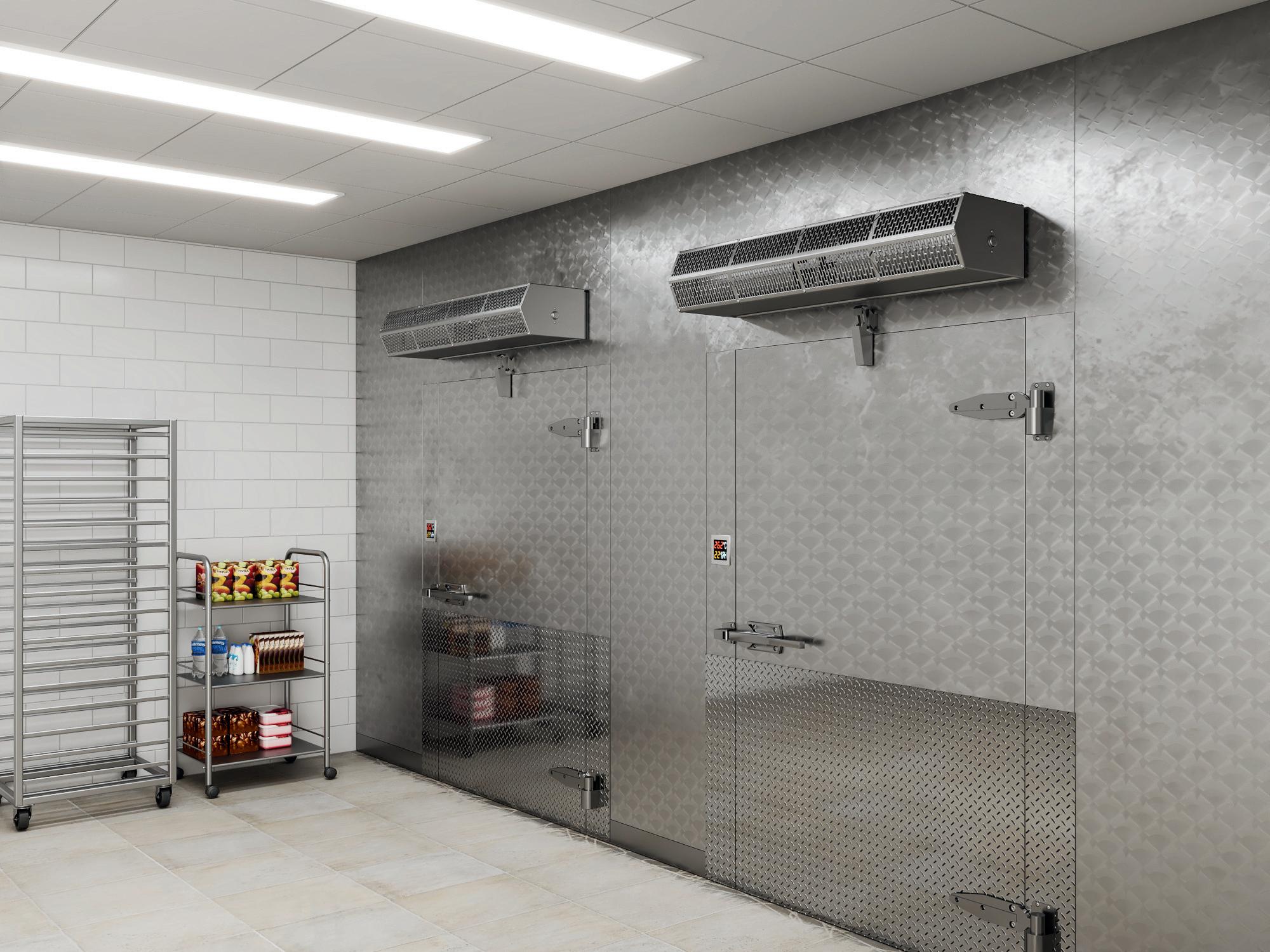
When the door is open,
INCREASE SANITATION
No strips to bump into, clean or replace
FOOD SAFETY
Interior temperatures are maintained
CONSERVE ENERGY
Compressor runs less often




















Acrelec ................................................ 35 acrelec.com
Ajinomoto............................................. 5 ajinomoto.com
bb.q CHICKEN ................................ 26, 27 bbqchicken.com
Berner Air Curtains ............................... 81 844-708-2500 | berner.com
Big Dave's ........................................... 76 bigdavesway.com
Coates ................................................. 39 coatesgroup.com
Creative Realities ................................. 43 www.cri.com
Dallas Group of America 71 800-367-4188 | dallasgrp.com
DSA Signage ........................................ 51 866-261-0317 | dsasignage.com
Ecolab ................................................. 49 800-529-5458 ecolab.com/solutions/machine-warewashing-qsr
Energy Solutions .................................. 61 714-787-1098 caenergywise.com/instant-rebates
Frozen Beverage Dispensers ..................... 2 210-637-2800 | fbdfrozen.com

Ghirardelli ................... Inside Front Cover 888-402-6262 | ghirardelli.com/professional
Hatco ................................................... 45 414-671-6350 | hatcocorp.com
HME ................................................ 20, 21 866-577-6721 | hme.com/nexeo
Inspire Brands 14 inspirebrands.com
Intouch Insight ..................................... 75 intouchinsight.com
KitchenBrains ........................................ 1 800-243-9271 | KitchenBrains.com
Mercy For Animals ................................ 81 frankenchickens.com
Mike's Hot Honey ................................. 47 212-655-0574 | mikeshothoney.com/sample
NAFEM ................................................ 64 thenafemshow.org/attend
NorthAmerican Bancard ....................... 77 866-481-4604 | NYNAB.com
Peerless AV ..........................................
Perdue Foodservice ..............................17 888-737-3832 |
PizzaCloud ............................................ 8 866-511-5521 | pizzacloud.net Ready Access ....................................... 37 800-621-5045 | ready-access.com
Red Gold ....................... Inside Back Cover 866-729-7187 redgoldtomatoes.com/foldsofhonor
RF Technologies .............................. 11, 82 800-598-2370 | rfdrivethru.com
RF Technologies APEX ............................
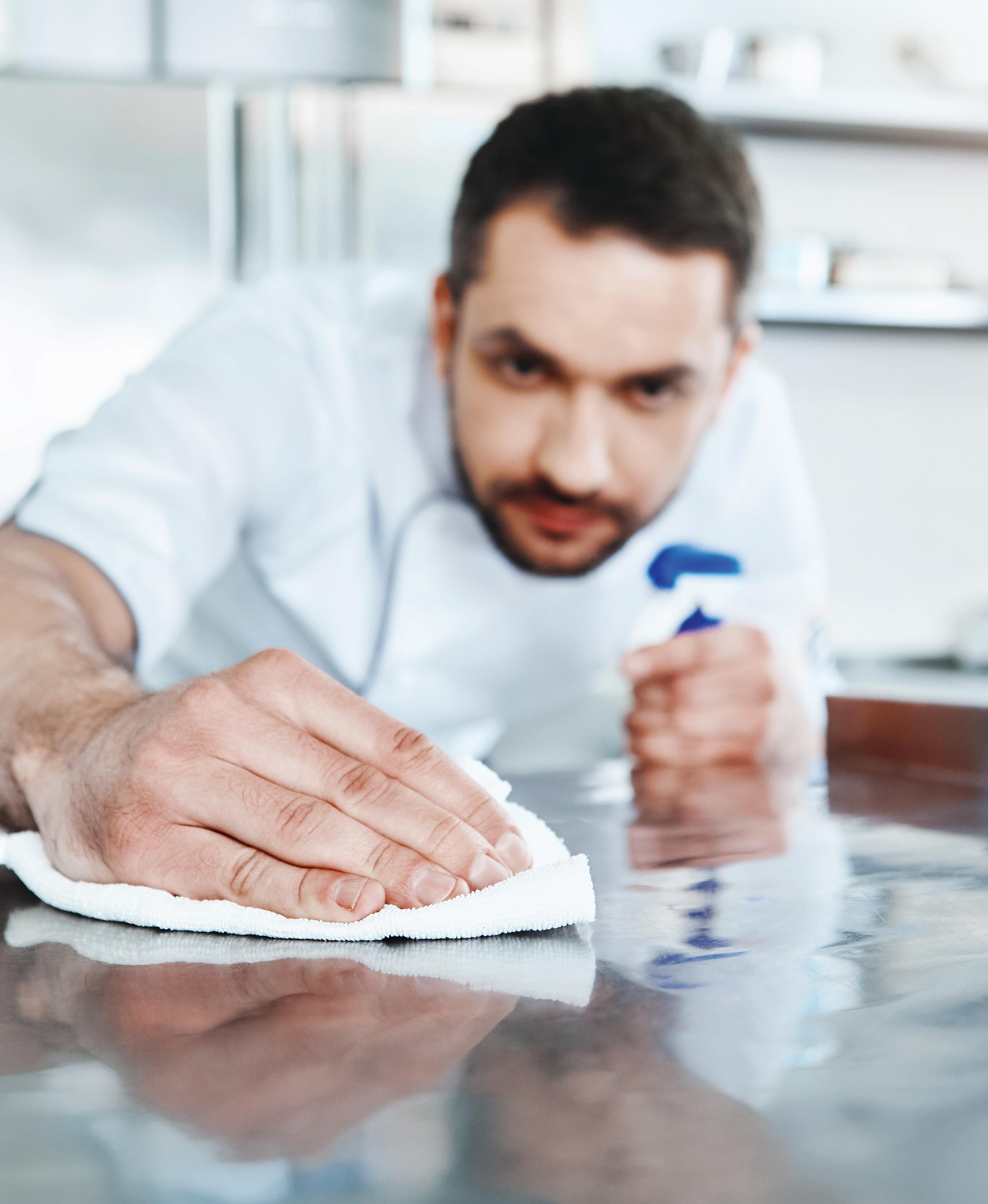

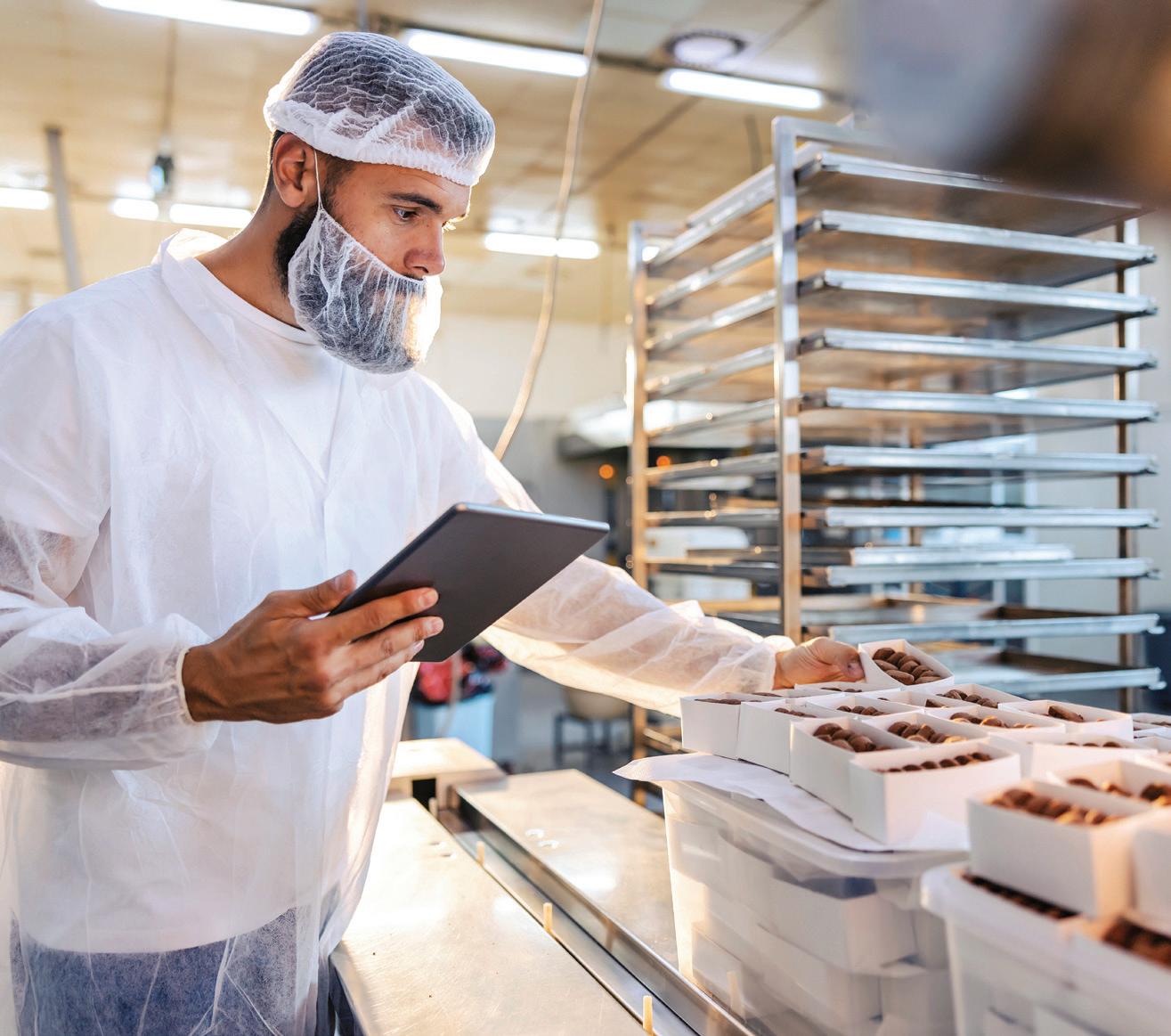
avigating the fast-paced world of quick-service restaurants is increasingly challenging as public health and safety rise to the forefront while the demand for quality is undiminished. In this issue of Smart Chain, we spotlight food safety with insights from top industry experts, exploring how social media influences restaurant reputations and the evolving standards of cleanliness driven by consumer demand for environmentally friendly practices, along with many more key insights.
Quick-service restaurants are at the forefront of the service industry and will serve nearly 84 million Americans on any given day, according to the CDC. Health and safety procedures are of the utmost importance and cannot be understated. Oftentimes, solutions may feel out of reach, too expensive, or unknown. It is necessary to look to thought leaders in the industry to analyze what solutions operators can access and what blind spots restaurants may have.
To address these concerns, we’ve gathered insights from leading experts at Ecolab USA, Inc., Force of Nature, ITD Food Safety, Sani Professional, Steritech, and Tronex. Their perspectives reveal how advancements in technology, strategic partnerships, and sustainable practices are shaping the future of food safety in the quick-service restaurant industry.






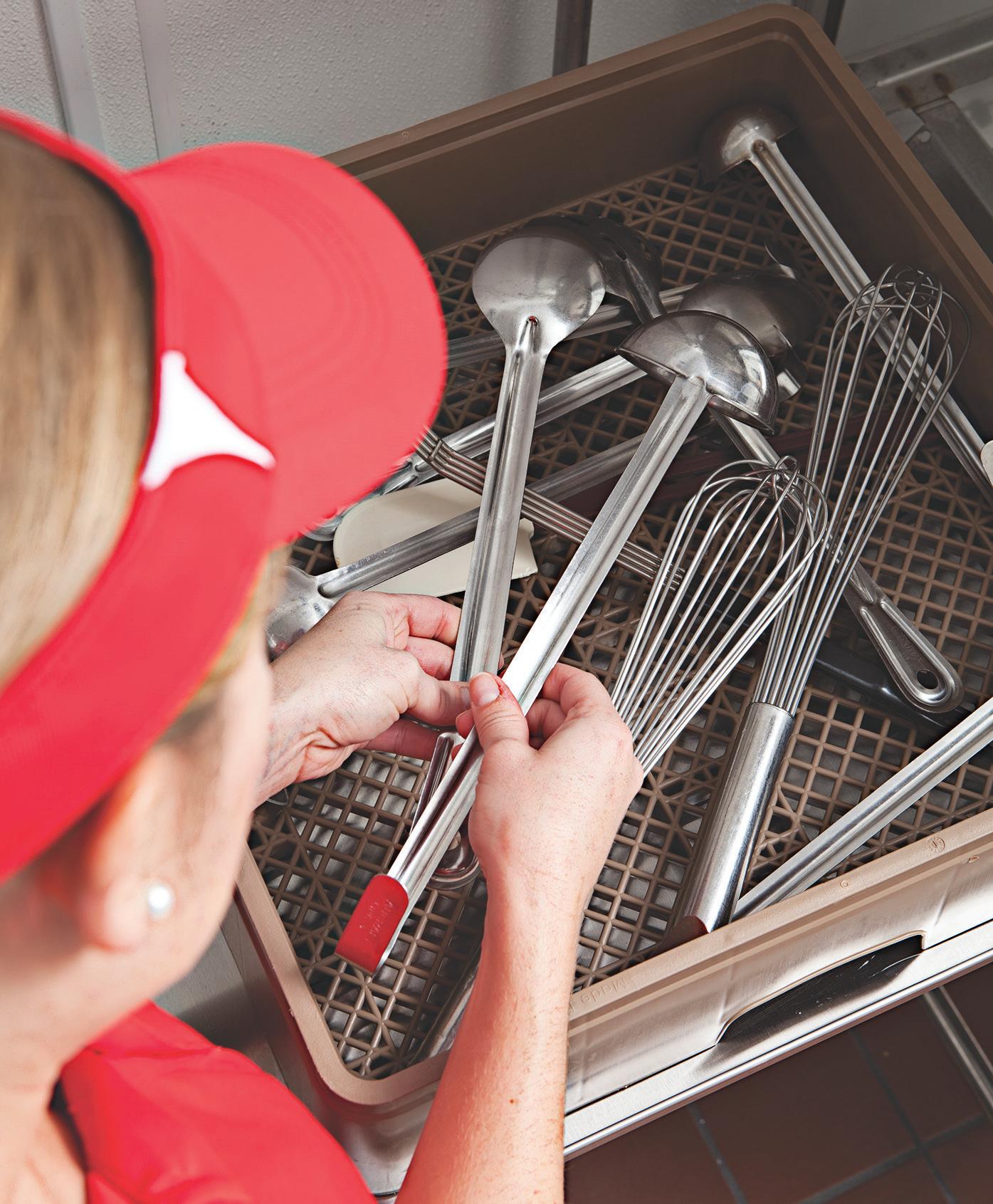
How are operators responding to these challenges?
VP RD&E Food Safety & Public Health
What are some of the challenges operators face in food safety?
ROBINSON: While there are many challenges restaurants continue to face, increased labor costs and high turnover put additional pressure on restaurants’ operating expenses, which have a widespread impact on the health of a business. A food safety management system and e ective training are critical so new employees can get up to speed quickly and maintain the quality and safety of the food they serve.
ROBINSON: Operators invest in technology where it makes sense and they see value. From digital checklists, reporting, and food rotation labeling, to machine robotics and automated warewash machines, innovation is being introduced.
These systems help simplify food safety practices and allow restaurant operators to focus on ensuring customers have a great experience.
How are advancements in technology changing food safety?
ROBINSON: Advancements in technology are leading to more automation in restaurant operations. There are more consistent and automated cooking systems and clean-in-place systems integrated into kitchen equipment. Technology is
also being used to improve traceability across entire supply chains so if there is a food safety issue identified, it becomes easier to understand where it is and how it is best addressed.
Why is it more crucial than ever before to partner with a trusted brand?
Robinson: Trusted brands can provide science-based technical expertise that operators don’t have in house. Partners o er innovative solutions and technology to help solve daily food safety challenges. A trusted provider can provide resources to train operator teams on the importance of food safety and help ensure a culture of food safety. All of these can help reduce costs, increase productivity, and protect a brand’s reputation.
What are some of the challenges operators face in food safety?
POSA: Operators navigate local, state, and federal guidelines, ensuring strict adherence to cleaning and disinfecting protocols alongside other safety measures. Noncompliance can result in penalties, including fines, temporary closures, and reputational damage.
What are the biggest problems facing the modern quick-service kitchen? How are these impacting the industry?
POSA: Quick-service kitchens are bustling, aiming to serve food quickly. This rush leads to shortcuts in cleaning, which can be risky. Skimping on clean-




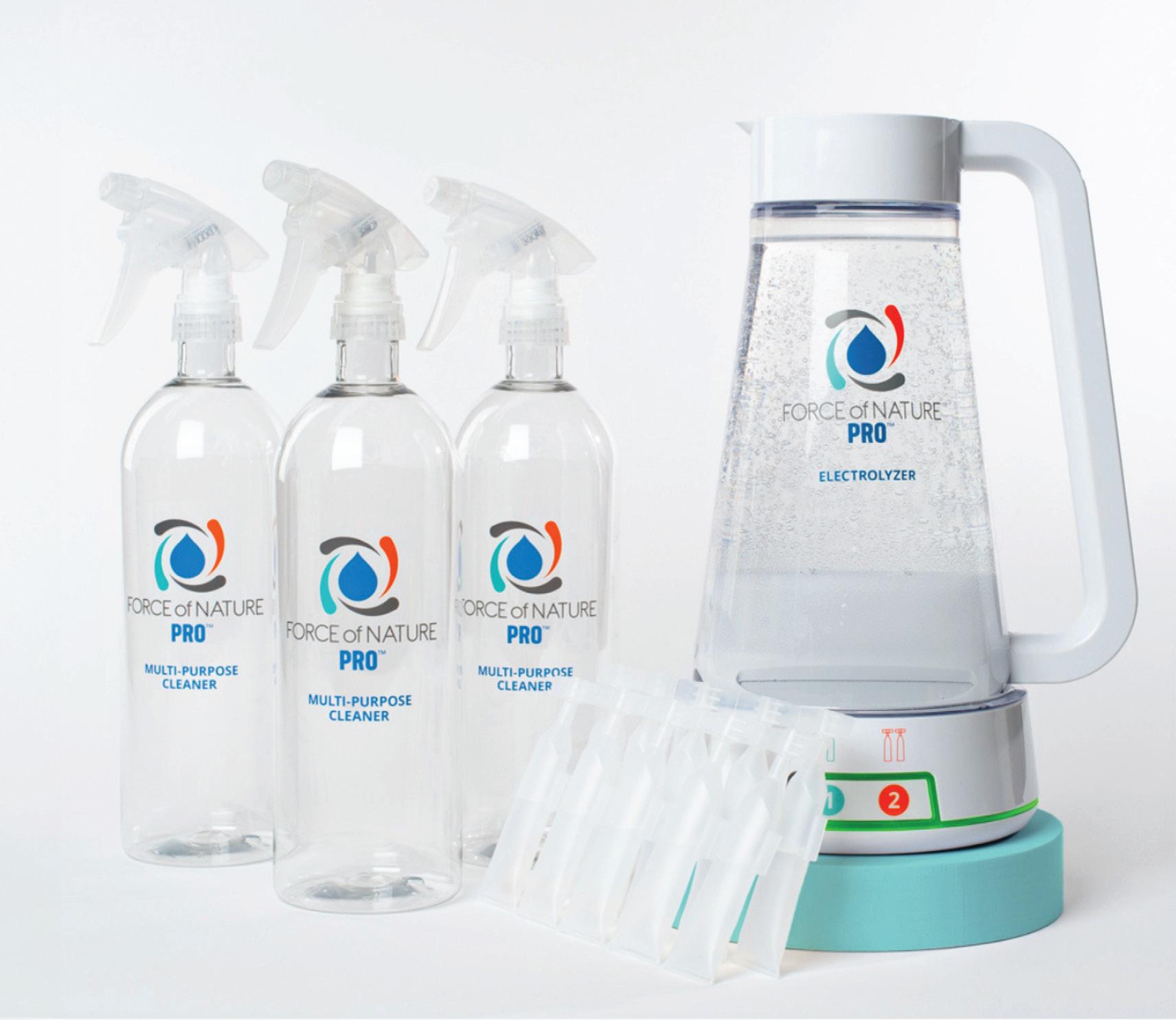
can lead to costly legal and regulatory repercussions for restaurants. Maintaining regular and e ective cleaning and disinfecting practices is essential in managing cross contamination and ensuring food safety standards are met.
What are some of the best ways you see operators addressing these challenges?
against using bleach, fragranced cleaners, and quats near individuals with these conditions. Using eco-friendly disinfectants keeps everyone healthier and operators compliant with health guidelines.
Are there any mistakes you see operators making in food safety?
POSA: One common slip up is using the same cloth for di erent areas. This leads to cross contamination, which can increase the risk of making people sick. Using an eco-friendly bleach-strength cleaner without toxic chemicals can be a game changer in ensuring e ective cleaning without compromising on safety and environmental impact.
Why is it more crucial than ever before to partner with a trusted brand?
POSA: The rise of social media and online review platforms has given consumers unprecedented access to information about food safety practices. Ensuring consistent food safety and cleanliness can lead to favorable reviews and social media mentions, attracting more customers.
ing means bacteria and viruses can hang around on surfaces, utensils, and equipment, risking food safety.
The fast-paced nature of quickservice kitchens heightens the risk of cross contamination between raw and cooked foods, surfaces, and utensils, which is a significant risk factor for foodborne illnesses and has severe health consequences for customers. It
POSA: There’s a big push for restaurants to go green, it’s not just good for the planet—it’s good for food safety too. From cutting down on waste to using eco-friendly products and getting ingredients responsibly, these practices meet consumer demands and help keep cross contamination in check, ensuring better quality overall. Embracing sustainable practices contributes to a healthier and safer dining experience.
Around 30 percent of U.S. adults and 40 percent of U.S. children have asthma or allergies, the CDC advises
What are some of the challenges operators face in food safety?
MOBLEY: Food safety is paramount and operators face several challenges in ensuring compliance with HACCP standards. These include recording temperatures, labeling food items with expiration dates, maintaining proper temperature controls, preventing cross contamination of allergens, and adhering to sanitation protocols to mitigate the risk of foodborne illnesses.
What are the biggest problems facing the modern quick-service kitchen? How are these impacting the industry?
MOBLEY: Challenges such as managing high turnover rates among sta , quality amidst speed, and adapting to dietary preferences and allergen concerns sig-



nificantly impact operational e ciency and customer satisfaction. Due to this, its imperative quick-service kitchens incorporate technology to automate food safety procedures and maintain operational e ciency.
Looking to the future, what are some challenges and opportunities for quickservice restaurants?
MOBLEY: Quick-service restaurants will likely face increased scrutiny on sustainability practices, advancements in food safety technology, and evolving consumer preferences towards healthier,
more diverse menu options. Opportunities lie in leveraging automation for enhanced e ciency, adopting innovative packaging solutions, and catering to the growing demand for transparency in sourcing and preparation methods.
What are some of the key tasks in back-of-house where technology is stepping in as a solution?
MOBLEY: Technology plays a crucial role in back-of-house operations by streamlining food prep labeling, nutritional and retail labeling, automating temperature logs, and ensuring real-time monitoring of food storage conditions. Automated systems improve accuracy and reduce the likelihood of human error—enhancing overall food safety protocols.
How have the last few years changed customers’ expectations for food safety? How should operators communicate with consumers their needs are being met?
MOBLEY: Recent years have heightened consumer awareness regarding food safety, driven by public health concerns and social media coverage of foodborne illness outbreaks. Social media has

opened doors for consumers to expose food safety faults that may occur within restaurant operations. Operators can reassure customers by transparently showcasing their commitment to food safety through partnering with trusted companies like ITD Food Safety where there is proven success of HACCP food safety automation.
Vice President & General Manager of Sani Professional
What are the biggest problems facing the modern quick-service kitchen? How are these impacting the industry?
CARRION: Quick-service kitchens face consumer expectations for speed, cleanliness, and safety, compounded by high sta turnover rates and labor shortages. Balancing rapid service with food safety protocols poses significant challenges, especially as new employees navigate these demands.
Consumers are placing emphasis on visible safety measures, such as observing glove changes and wiping of dining surfaces. Meeting these demands requires e cient technologies and innovative training strategies.
Looking into the future, what are some challenges and opportunities for quick-service restaurants?
CARRION: Quick-service restaurants will face challenges such as compliance with food safety regulations, cost management, and improving guest experiences. Persistent labor shortages will remain a concern, continuing to impact profitability and guest experience.
It’s likely the industry will be at the forefront of adopting automation solutions as they become more a ordable. Technological advancements present opportunities to enhance automation, potentially reducing reliance on human labor. This shift could enable person-






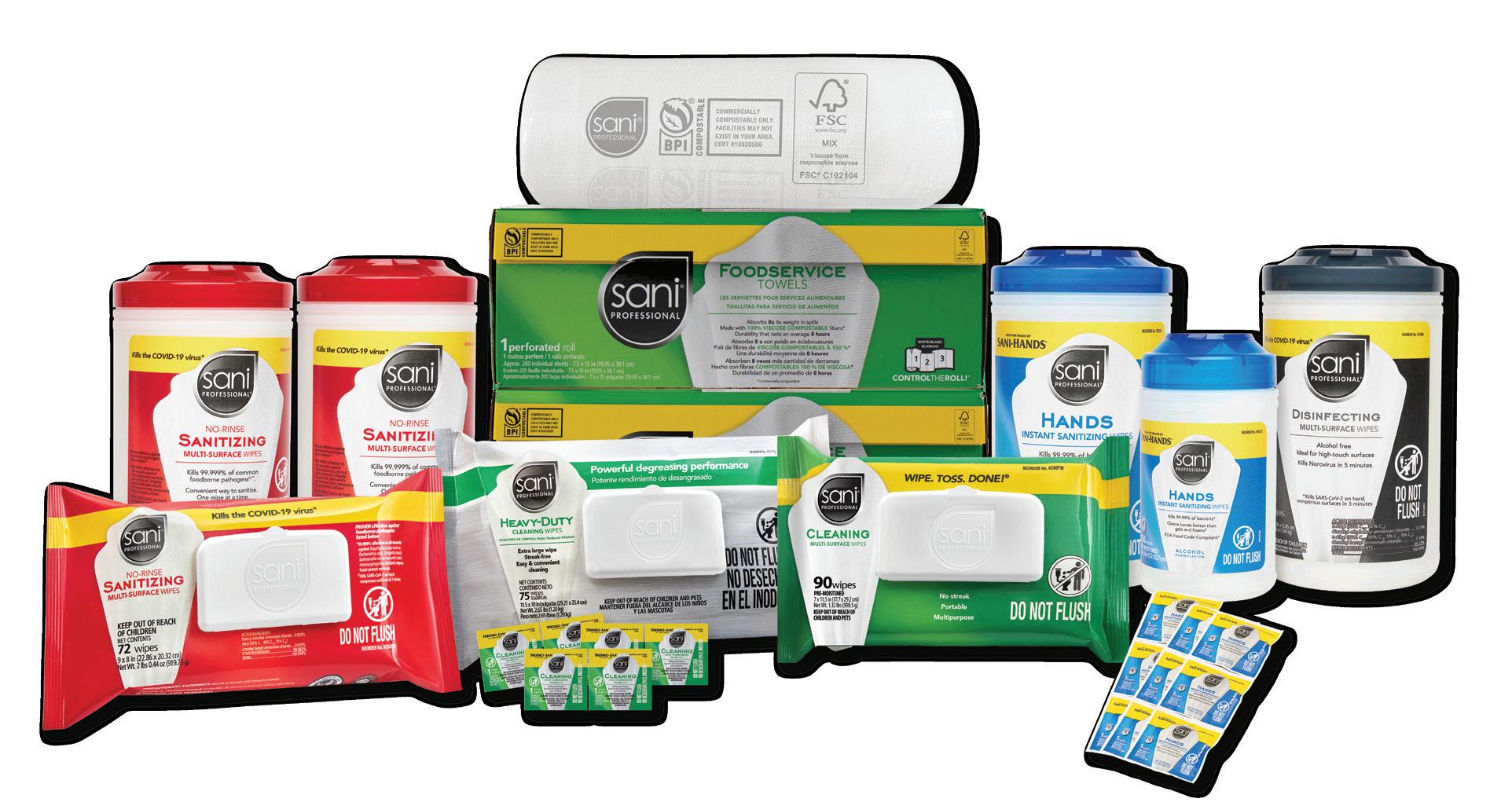



with suppliers of single-use cleaning products helping operators streamline cleaning processes, reducing training requirements, and minimizing the opportunity for human error.
What are some of the key tasks where technology is stepping in as a solution?
returns on investment. However, technology can improve food quality consistency and shift labor towards more fulfilling tasks, potentially boosting job satisfaction.
Why is it more crucial than ever before to partner with a trusted brand?
CARRION: Partnering with trusted brands ensures operators access reliable expertise, innovative technologies, and consistent supply chains critical for food safety and operational success. Brands uphold rigorous standards, enhance customer loyalty, and mitigate risks associated with regulatory compliance and market credibility.
What are the biggest problems facing the modern quick-service kitchen? How are these impacting the industry?
BOYLES: Managing multiple delivery channels such as dine in, drive thru, carry out, delivery, and catering. Each channel has its own food safety challenges. Carry out and delivery may have needs around staging orders for pick up. Large orders can overwhelm sta and space, and transport to an osite event may require equipment for temperature management.
What are some of the ways you see operators addressing these challenges? Are there any mistakes you see operators making when it comes to food safety?
alized customer experiences through data-driven insights.
What are some of the best ways you see operators addressing these challenges?
CARRION: Operators in the food service industry are leveraging strategic partnerships with their suppliers to address issues. This is evident in partnerships
CARRION: Technology is revolutionizing back-of-house operations with robotics for food preparation and sanitation. Innovations like automated cleaning systems and robotic assistants streamline routine tasks, reducing human error and operational costs.
Do you see any misconceptions when restaurants integrate more technology solutions into operations?
CARRION: Consumers fear a decline in food quality, employees worry about job displacement, managers anticipate high costs, and corporations expect instant
BOYLES: Food safety training is an investment, but operators often take a one and done approach. Unfortunately, it’s clear employees begin forgetting their training almost immediately. The best way to counteract that is to reinforce key training concepts quickly and often.
What are some of the key tasks in back-of-house where technology is stepping in as a solution?
BOYLES: Sensors can provide real-time measurements, such as temperature. Task managers can help ensure managers are performing checks on time. This


is helpful with complex processes such as cooling hot foods. It also makes it easier to manage repetitive tasks such as those on a master cleaning schedule. Cameras coupled with AI can monitor whether products are assembled according to protocol, employees wash hands at appropriate times, and the dishwashing process is followed.
How have the last few years changed what customers expect when it comes to food safety? How should operators communicate to consumers their needs are being met?
BOYLES: Consumers and regulators expect allergen management and communication from operators. In 2023, we added sesame to the list of major food allergens that have to be labeled. This law also created the opportunity for more allergens to be added quickly in the future. The most recent FDA Food Code began requiring operators to notify consumers in writing about major allergens in any unpackaged food being sold.
Executive Vice President & Chief Business Development Officer
What are the biggest problems facing the modern quick-service kitchen? How are these impacting the industry?
TAI: Perhaps the biggest problem in the industry today is managing the cost and speed of service, which directly a ects the ability to maintain food safety standards. The labor shortage has a profound impact on labor costs, creating a dire need for automation. This shift leaves humans the responsibility of tasks such as judgment and planning. Continued upkeep and proficiency in AI capabilities can be a part of the total solution to some of these challenges.
How have the last few years changed what customers expect when it comes to food safety? How should operators communicate to consumers their needs are being met?
TAI: Consumers have become sophis-
ticated in food safety. Simultaneously, customers’ expectations of the quickservice restaurant industry has risen. A few established steps in which operators can communicate adherence to food safety protocols are as follows:
• Ensure food safety protocols are followed accurately and consistently.
• Make sure sta and food handlers visibly follow protocols, communicating their commitment through their actions.
• Ensure sta always follow proper hand washing and drying procedures.
• Keep all service areas cleaned regu-
larly, ensuring every part of the restaurant environment is sanitized.
• Avoid handling money or credit cards with gloves previously used for handling food.
Why is it more crucial than ever before to partner with a trusted brand?
TAI: A brand is created based on the track record of performance excellence, dependability, and trust. Therefore, with the operational challenges restaurateurs are facing in supply chain and labor management, it is important to partner with a trusted brand to develop a partnership approach of taking care of each other.





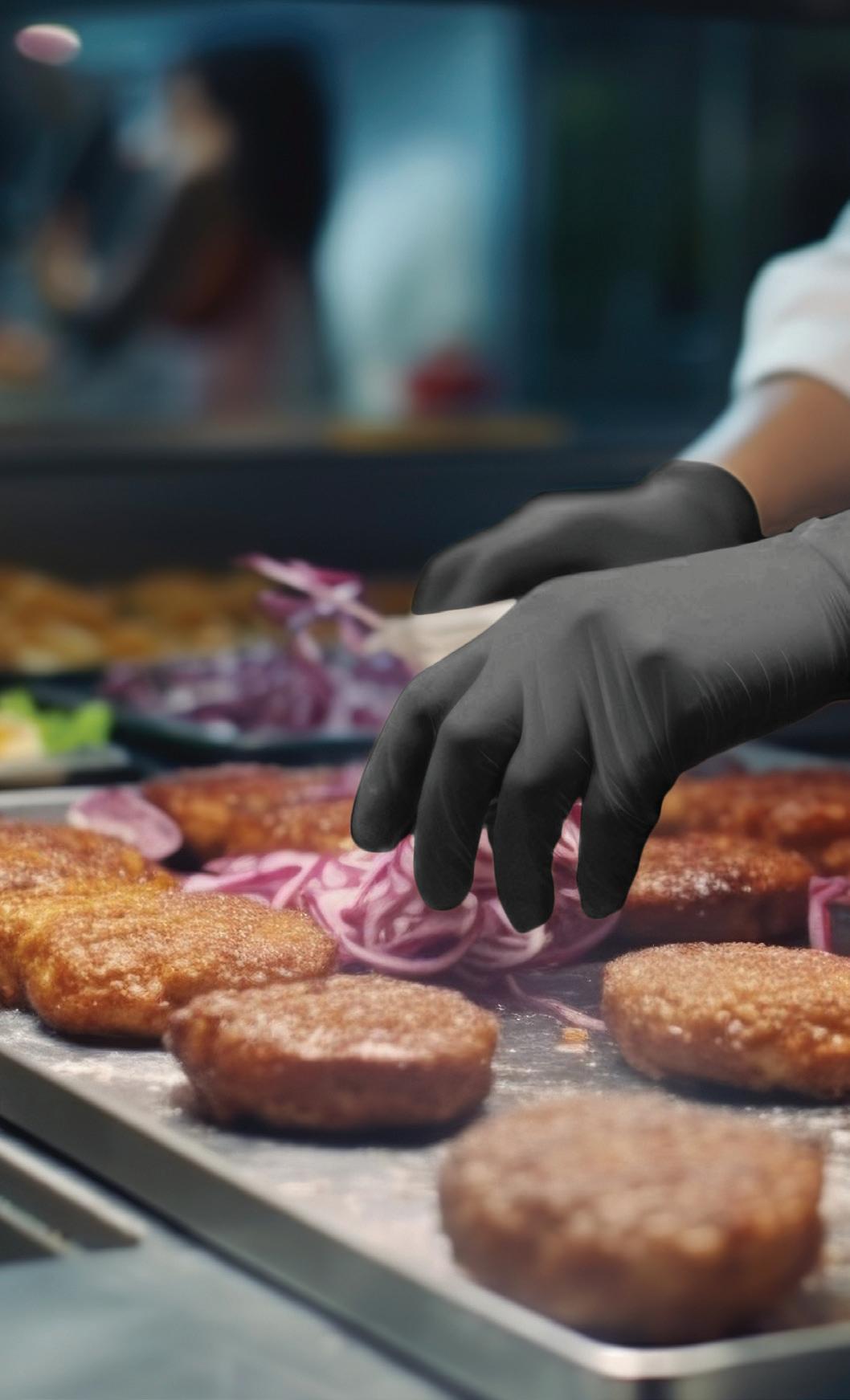

What was your first job?
I studied finance and astrophysics in college and decided to go the finance route after graduation. I worked for a hedge fund that specialized in structure credit, and primarily worked under our CFO on forecasting, valuations, and M&A activity.
What’s your favorite menu item at 16 Handles?
The great thing about 16 Handles is that the menu is always fresh, with multiple flavors rotating through the stores each month. Right now, I’m hooked on the Original Tart flavor.
What is your favorite cuisine aside from what is offered at 16 Handles?
My family and I love seafood! Whenever we are somewhere coastal, we always try the local oysters (Kumamoto are the current favorite). Nothing beats fresh lobster or king crab.
Who inspires you as a leader? There are a lot of great visionaries in the modern era that I look up to. Warren Buffet has taught me and many others about value investing, long term positions, and never being above the role. I respect the vision of Elon Musk and his execution with SpaceX and Tesla at upending industries typically seen as boring.
What is the best piece of advice you have that other restaurant executives should hear? There is a quote about min-maxing your life that has always stuck with me. In a short summary, find the things you really excel at, or are passionate about, and go all-in on them.

If you live in the Northeast, chances are you know 16 Handles. The brand was originally founded as NYC’s first self-serve soft serve frozen yogurt shop, designed to compete with the other frozen yogurt concepts in Manhattan that were limited on flavor and topping selection and didn’t allow customers to own their creations. Today, the product lineup has expanded, and so has the brand, but we are still focused on one main thing: selling a spoonful of happiness that just so happens to be healthier than traditional ice cream.
I was first introduced to 16 Handles as a customer of the East Village store, where I became a frequent loyal customer grabbing froyo after the gym, after dinner with friends, or even just as a midday weekday pick-me-up. After leaving behind my finance career for my own entrepreneurial ventures, I saw the opportunity for a new, active operator to lead 16 Handles into a new phase of growth, creating systems to scale nationally using the lessons learned from over a
decade of real-world experience and data for the 30-plus-unit brand.
In 2022, as 16 Handles’ largest franchisee, I acquired the brand from its founder. Today, we are entering a new phase of growth with a new leadership team. 16 Handles is the evolution of the self-serve frozen yogurt shop but modernized for today’s consumer.
Our premium soft-serve ranges from vegan, nonfat and no sugar added frozen yogurt to rich and decadent ice cream, with 50-plus toppings spanning from fresh fruit to edible cookie dough. Our stores also feature fruit smoothies, milkshakes, acai bowls, cookie dough, and really anything you could want when you need a snack. I personally operate seven stores across NYC in addition to overseeing growth and franchise support across the country, from Boston to Florida to Texas.
Many of our stores have seen consistent year over year sales increases and earned really positive organic reviews.


UNMATCHED NUTRITIONAL BENEFITS:
• Tomato Puree is the FIRST Ingredient
• Made with Real Sugar
• No High Fructose Corn Syrup (HFCS)
• 75% Less Sodium Than Other Leading Brands
• No Artificial Colors, Flavors or Preservatives
• Made Without Artificial Caramel Color
• Sweet & Smoky Flavor
• Gluten free
REQUEST YOUR FREE SAMPLE
OFTEN UNDETECTED UNTIL TOO LATE

F22 RAPTOR INVISIBLE BUT DEADLY
Automatically detects operational and HR Risks before they turn into major legal liabilities.